- Home
- The Way of St. Francis
- Assisi, a Sacred Medieval Treasure
Jump to Way of St. Francis Stages
Assisi ~
A Sacred Medieval Treasure
Just so you know, the PilgrimageTraveler.com is an associate of Booking.com, Roamless, and Amazon. As an associate of these merchants, we earn from qualifying purchases from our links.
Assisi, a sacred medieval treasure, is well known by tourists and pilgrims. Both arrive here in droves, some even on foot(!) to experience its special allure. It is truly a medieval gem like no other, brimming with culture, history, art and captivating views. It is the land of St. Francis, and lest we forget, St. Clare.
🙋♀️ Why Trust Us at the Pilgrimage Traveler?
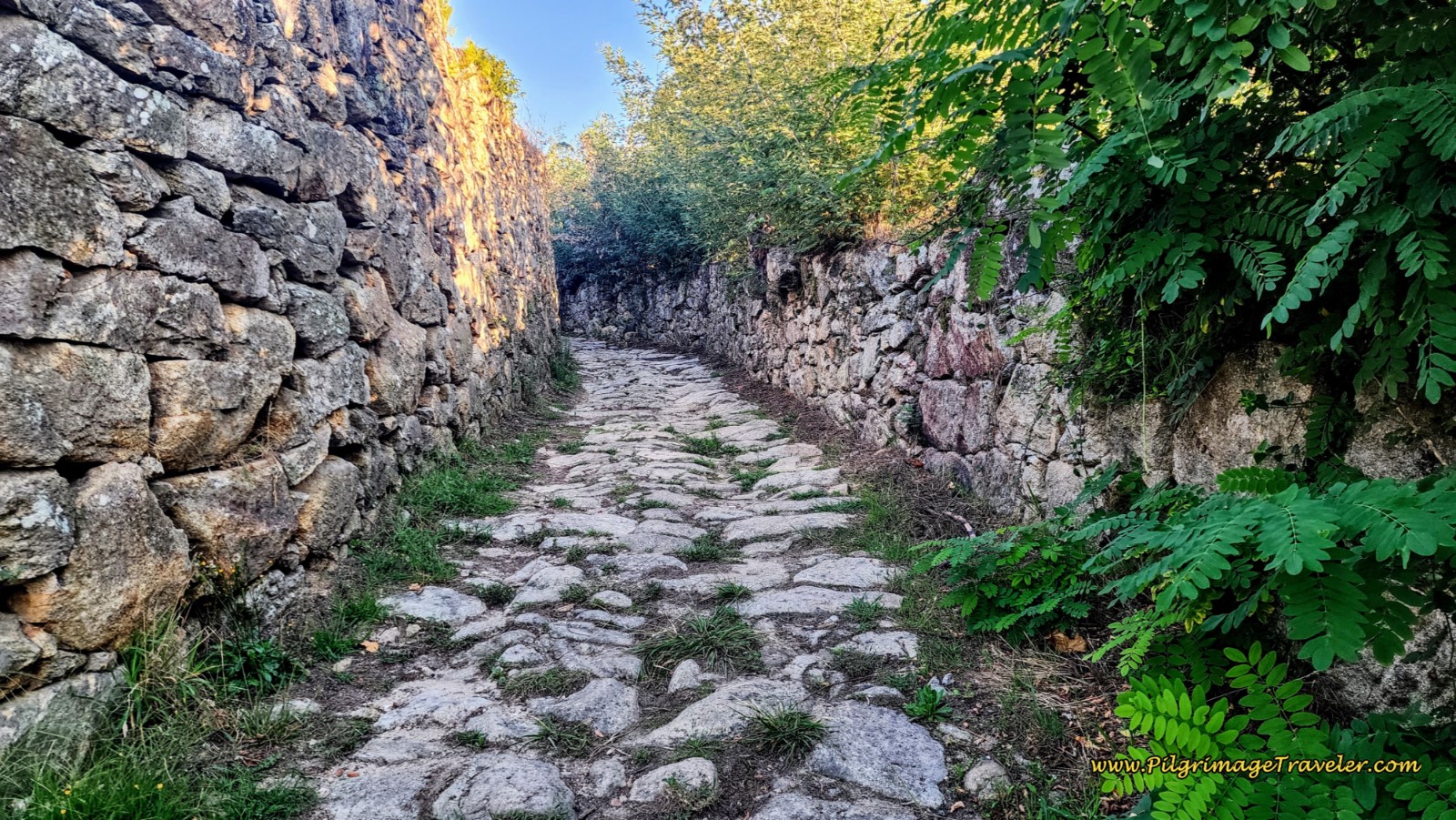
We’re not a travel agency ~ we’re pilgrims, just like you.
We've walked Pilgrimage Routes Across Europe!
💬 We’ve:
- Gotten lost so you don’t have to. 😉
- Followed yellow arrows in the glowing sunlight, the pouring rain and by moonlight. ☀️🌧️🌙
- Slept in albergues, hostals & casa rurals. Ate and drank in cafés along the way. 🛌 😴
- Created detailed and downloadable GPS maps and eBook Guides, full of must-have information based on real pilgrimage travels. 🧭 🗺️
- Shared our complete journeys, step by step to help YOU plan your own ultimate pilgrimage and walk with your own Heart and Soul. 💙✨
Every detail is from our own experiences ~ no fluff, no AI rewrite. Just fellow pilgrims sharing the way. We add a touch of spirituality, a big dose of ❤️ and lots of wisdom from the road.
Ultreia and Safe Pilgrimage Travels, Caminante! 💫 💚 🤍
"Architecture is the will of an epoch translated into space." ~ Ludwig Mies Van Der Rohe
If ever there was a place where architecture was a reflection of an epoch, the magical and sacred, medieval town of Assisi, reflecting the lives of the saints is one!
Map of Assisi, A Sacred Medieval Treasure
Here is my Google map of the city and its sites, with some of the more economical hotels in red, and the new pilgrim's Hospitale Laudato Si (+39 331 122 4691) and the Apartments Aurora Delle Rose where we stayed in orange and which I would highly recommend for a longer stay. We stayed here for two nights, but in retrospect, I really wish we had stayed longer. For current accommodation deals on booking.com click here.
Way of St. Francis EBook Guide
Our downloadable Way of St. Francis eBook Guide, in PDF format, contains all the valuable information from our web pages, for comfortable reading off-line in the mountainous and remote areas along this Way. Don't carry a heavy paper book, but use our digital eBook on your mobile device instead! You can deeply connect to nature, following in the footsteps of St. Francis, through the Italian countryside!
Our eBook guides are packed with frequently updated information, because a digital format is more nimble than hard-copy publishing. Our eBook Guide is unique because we also entertain and immerse you with our story! Click here for more information OR BUY NOW.
Top Sites in Assisi, A Sacred Medieval Treasure
The crowning jewel of the town of Assisi is undoubtedly the Basilica di San Francesco, where the saint is buried. One is not supposed to take photos in the basilica at all, but I saw quite a few people doing so, so I joined in. I did not, however, photograph his tomb. That felt disrespectful.
We decided to tour the basilica from the bottom up, starting with the Crypt of St. Francis. As you enter the lower basilica, first built starting in 1228 and just a few years after the saint's death, there are stairways on either side that take you down another story to the crypt. I would highly suggest you read the Key to Umbria's article about how the crypt was established, using the link in this paragraph. It is fascinating! They essentially carved out the crypt from the already-built lower basilica, in 1822, after the rediscovery of the saint's body.
Early in the morning when we arrived, to beat the crowds, there was a mass for only monks going on in the crypt. The tomb and small sanctuary was gated off with "do not enter" signs and there were signs posted everywhere for no photographs. To see a good photo of the tomb, click here.
After paying our respects and listening to the mass for a while, we returned to the lower basilica, a dark, Romanesque place with so many frescoes! It was commissioned by Pope Gregory IX in 1228 when work was begun, but many embellishments had been added up to the end of the 13th century. Historically, it was used for mass for the friars, and for pilgrims to venerate the saint's relics. In contrast, the upper basilica was used as a papal basilica.
For a good view of the cross floor plan of the lower basilica and all its side chapels, refer to the link in this paragraph. You will see an excellent description and photos of each chapel.
Here are a few of my clandestine photos! I have included references from the very exhaustive Key to Umbria website, but your best bet may be to buy the audio tour for a full appreciation of what you will see.
Here is the high altar. The tomb of St. Francis is directly below this altar in the crypt. And as if that weren't enough, the central column behind the altar contains a relic of St. John the Baptist!
The frescoes above the altar by Giotto, in the cross vault are stunning. Here is a close up of the allegory scenes above the altar, depicting the three Franciscan virtues: Chastity (left side of photo), Poverty (bottom of photo) and Obedience (right side). The upper fresco in the photo below shows St. Francis in glory, uncharacteristically dressed in royal robes surrounded by saints and angels. You can see this fresco a bit better in the photo of the high altar, above where it is right-side-up.
For more history and explanations of the many frescoes in the nave and transepts, please refer to the Key to Umbria: Lower Church website.
Make sure you visit the side chapel, the Cappella delle Reliquie, in the lower basilica that contains the robe that St. Francis wore, below left. It shows significant wear, and is full of patches made by St. Clare herself, one of St. Francis' most devoted followers who established her own order of nuns.
There are more objects used by St. Francis on display, including this ivory horn, pictured below right.
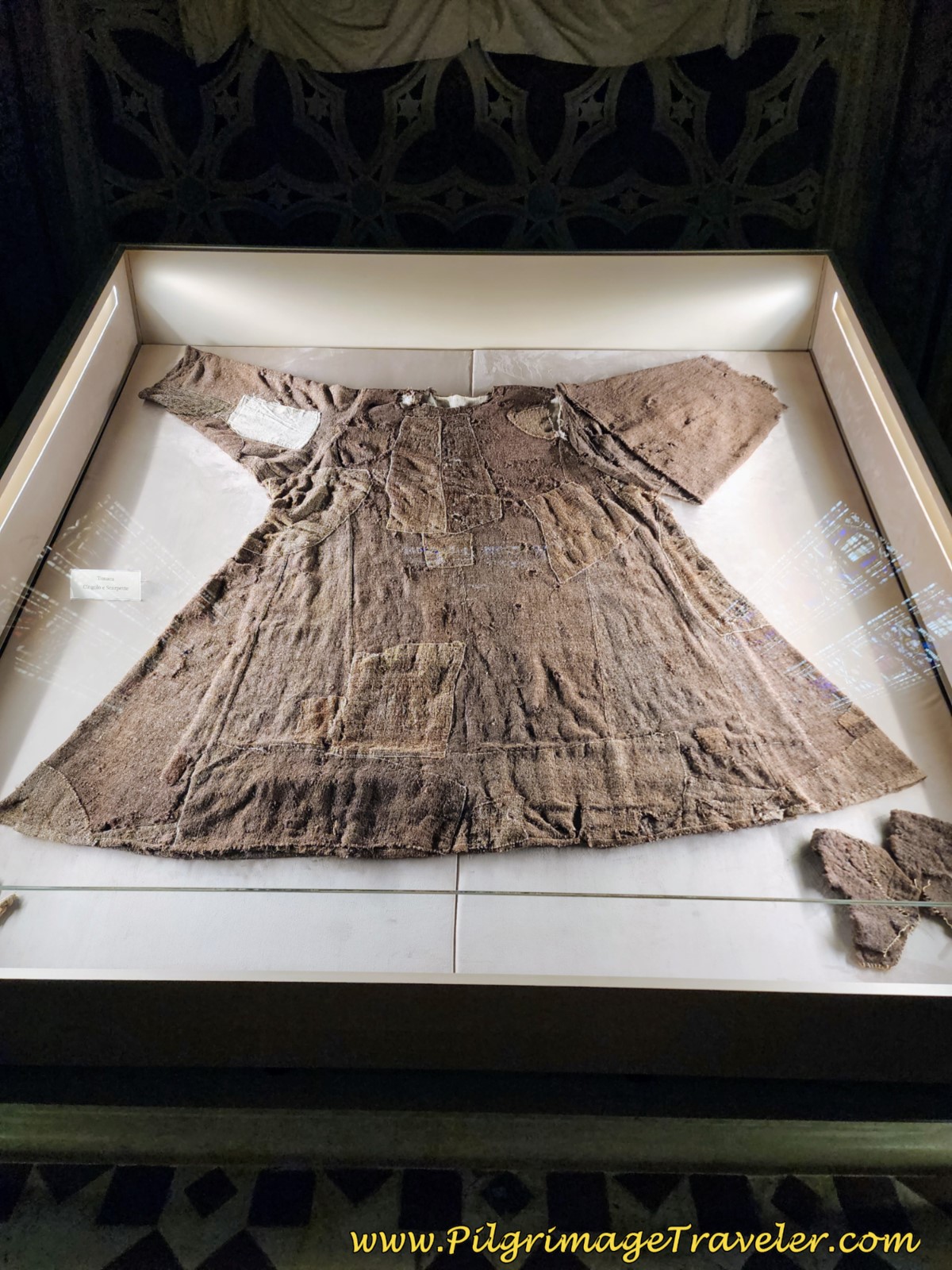 St. Francis' Robe
St. Francis' Robe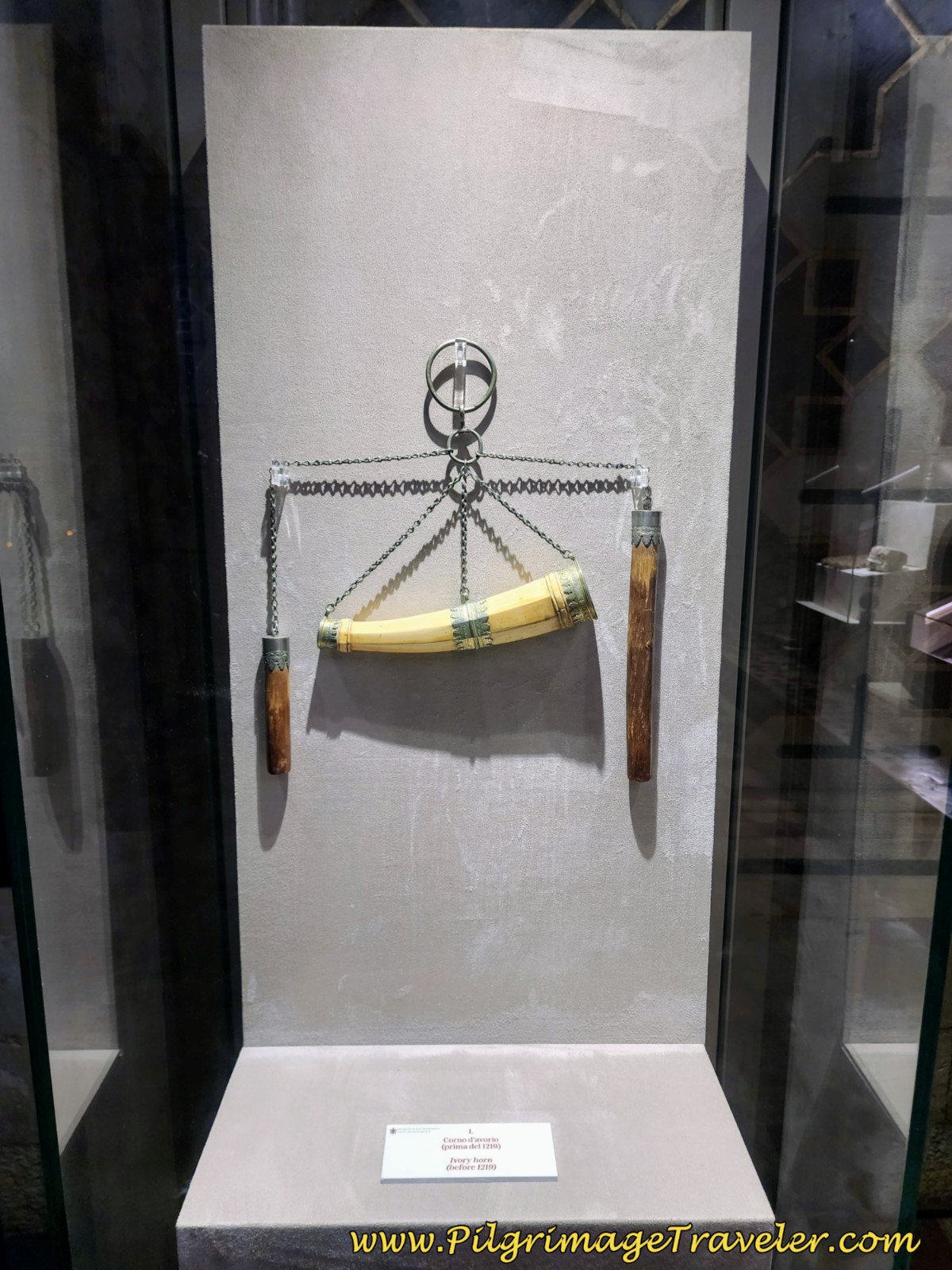 St. Francis' Ivory Horn
St. Francis' Ivory HornBut perhaps, the most precious of the relics is the document, the Regula Bullata, pictured below. On this original parchment, dated November 29, 1223, is the letter of approval, by Pope Honorius III, who solemnly confirmed the Rule, written by Francis for his order. Bullata means "bull" in Italian, and you can see the papal seal of the bull on the lower side of the letter. The letter contains all twelve chapters that make up the Later Rule, which still governs the lives of the Franciscans to this day.
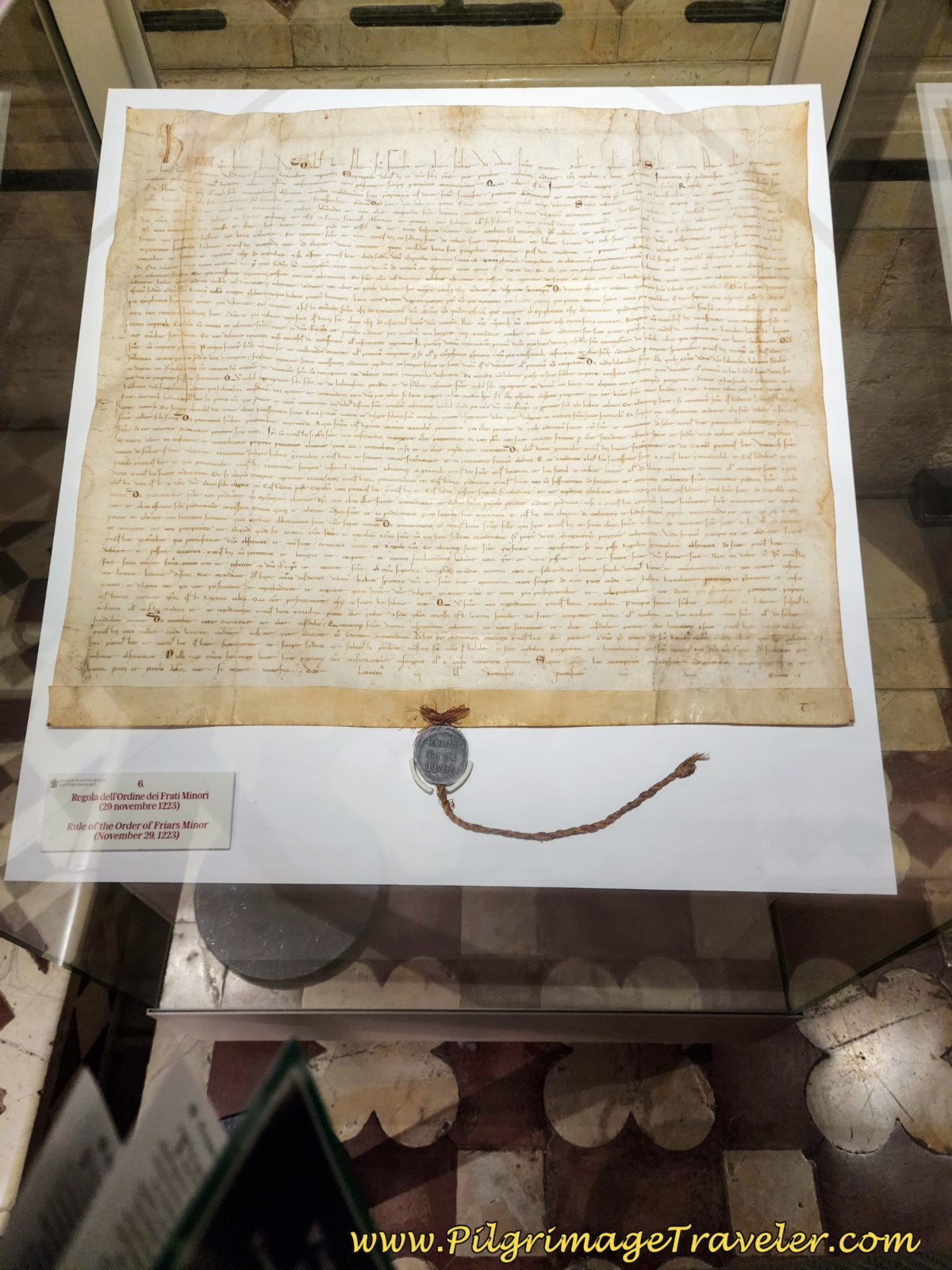 The Rule of the Order of the Friars Minor
The Rule of the Order of the Friars MinorAnd here is a photo of only one of the side chapels in the lower basilica, the Cappella di Santa Caterina. Click on the link provided to read about it and the remaining side chapels.
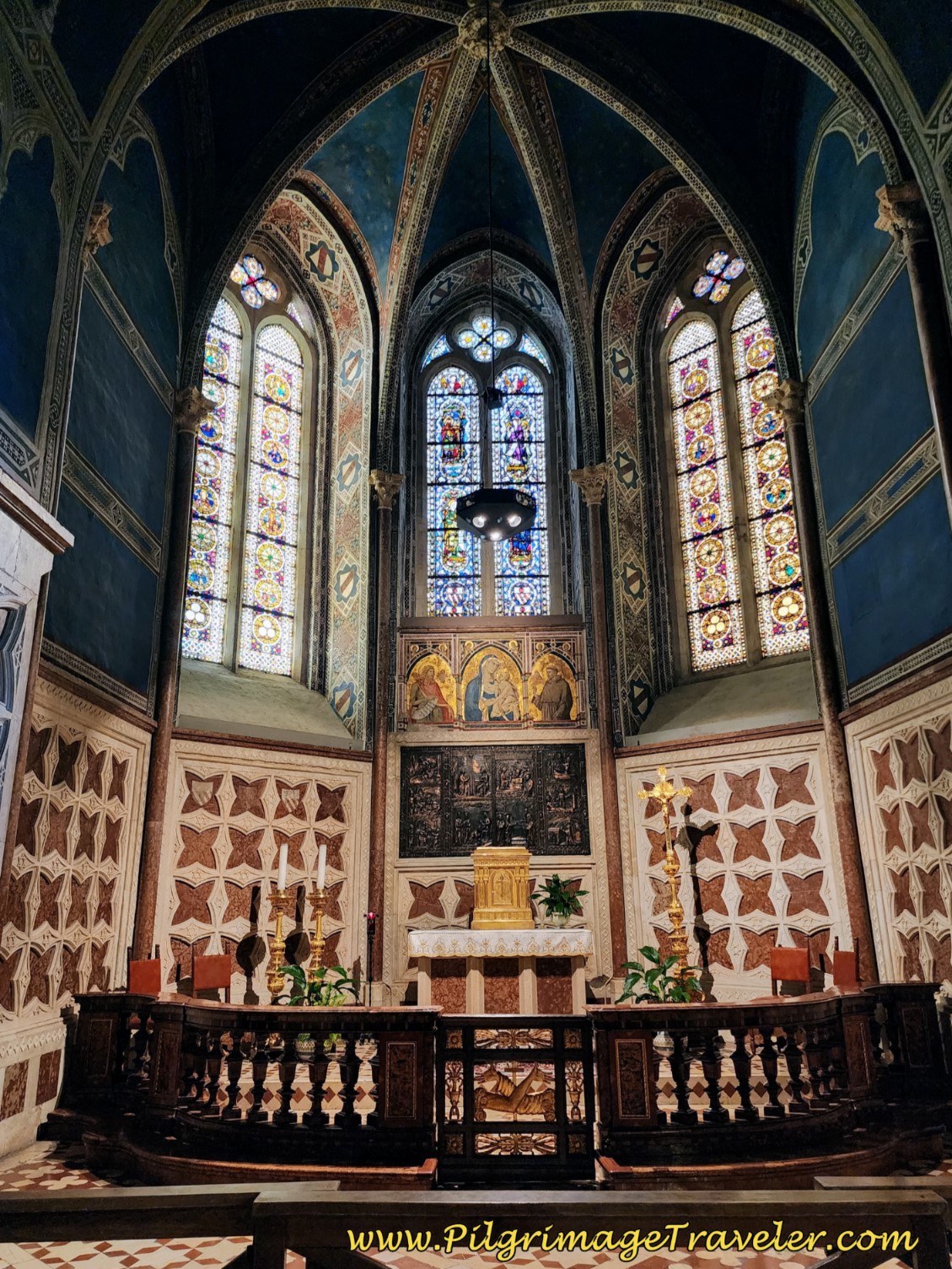 Cappella di Santa Catarina, Lower Basilica
Cappella di Santa Catarina, Lower BasilicaThe frescoes that line the transepts of the lower church are amazing, and all from the 14th century. To read about them, click here. I have one pictured below, but I can't seem to find its description. It is obviously depicting the mourning of Christ in death, by Mother Mary, Mary Magdalene and Joseph of Arimathea.
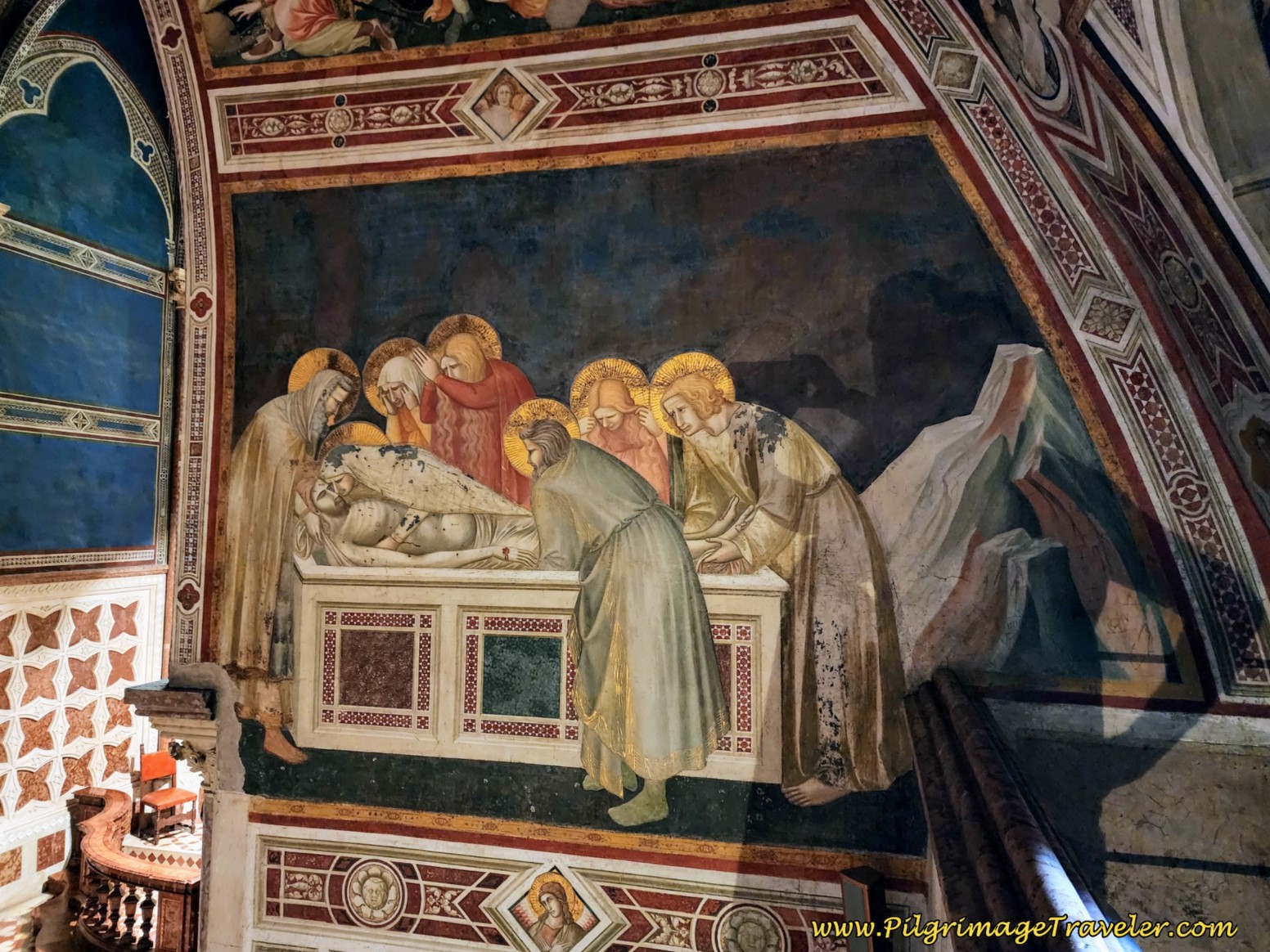 Mourners Over the Death of Jesus
Mourners Over the Death of JesusWe climbed the stairs to the Upper Basilica, in the Gothic style with French influences. Building started shortly after the lower church in 1253. While I do not picture the classic double papal altar, below left is the apse and its stained glass windows, with the papal white throne, and the choir stalls on either side.
Below right is a picture of the nave from the altar, with the famous frescoes by Cimabue in the late 13th century.
I am not certain who painted this fresco shown below, but it is one in the cycle of St. Francis. Here the saint is receiving confirmation of his Rule by the Pope.
Jump to Way of St. Francis Stages
We left the basilica, to stroll to the next big site. Along the Via San Francesco is the medieval gate, the Portico del Monte Frumentario, one of eight gates in all. The current city walls of Assisi are from the 14th century and were expanded from the original Roman ones.
Regarding the walls of Assisi, the original city was "confined by its Roman walls until about 1260, when work began on a new circuit. Still another was begun in 1316, in order to encompass the new suburbs of Assisi. This work was soon interrupted, when the city plunged into warfare, papal interdict and plague. The outer walls probably took on its present form in 1362-5, when Cardinal Albornoz regained Assisi for the papacy. The completed circuit with its eight gates, almost doubled the size of the walled city," quote from the Key to Umbria website.
Our next destination was the Chiesa di San Stefano, and along the way you walk up this narrow little passageway that is incredibly charming.
Not much is known about the tiny Romanesque church of Santo Stefano, built sometime in the 12th century, and was an established parish church by 1166. You can see by looking at the façade that it had been enlarged, but at an unknown time.
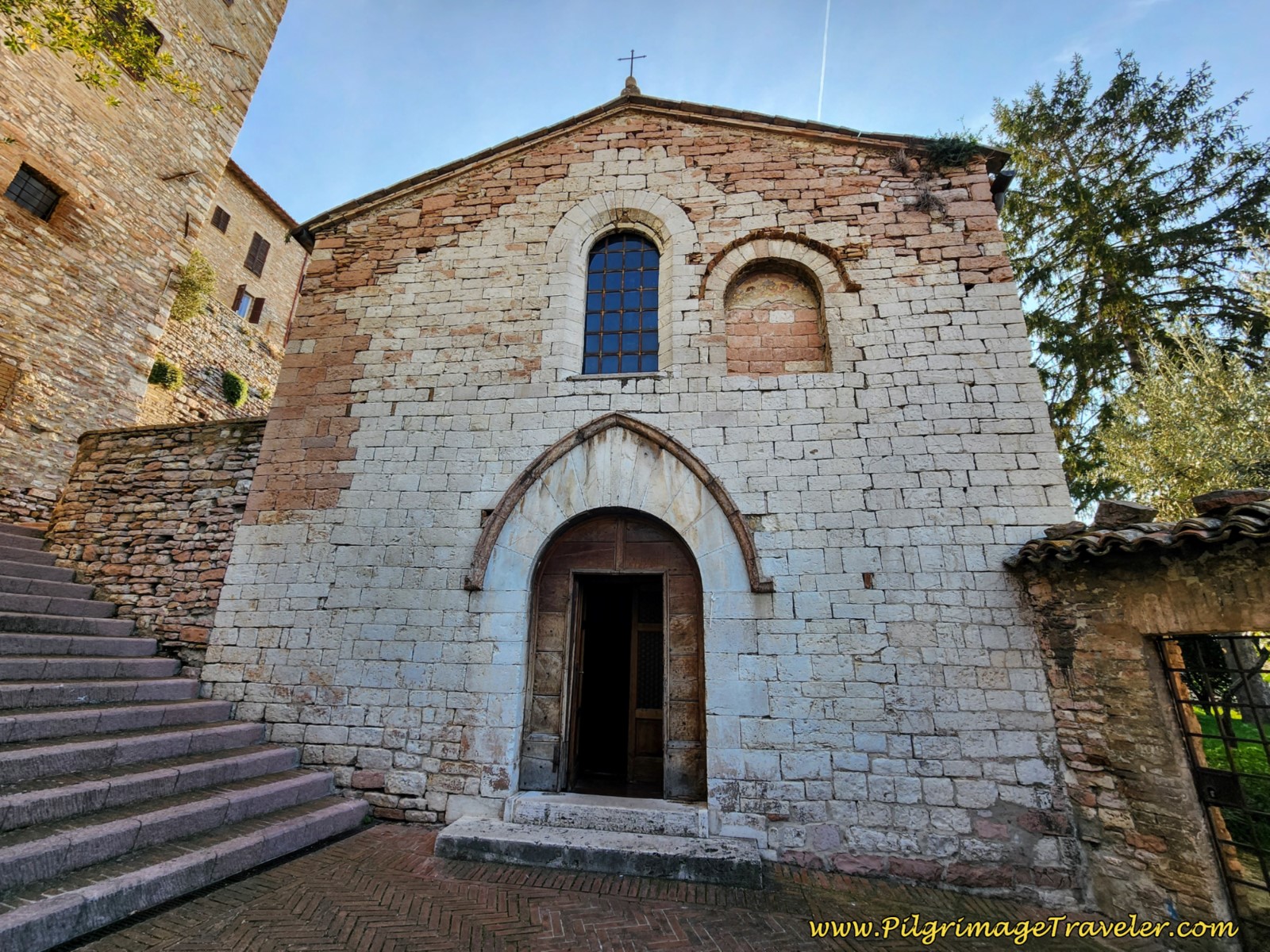 Chiesa di Santo Stefano, Assisi, a Sacred Medieval Treasure
Chiesa di Santo Stefano, Assisi, a Sacred Medieval TreasureThis incredibly ancient and simple church has an unspoken majesty and according to tradition, the bells rang spontaneously when St. Francis died in 1226.
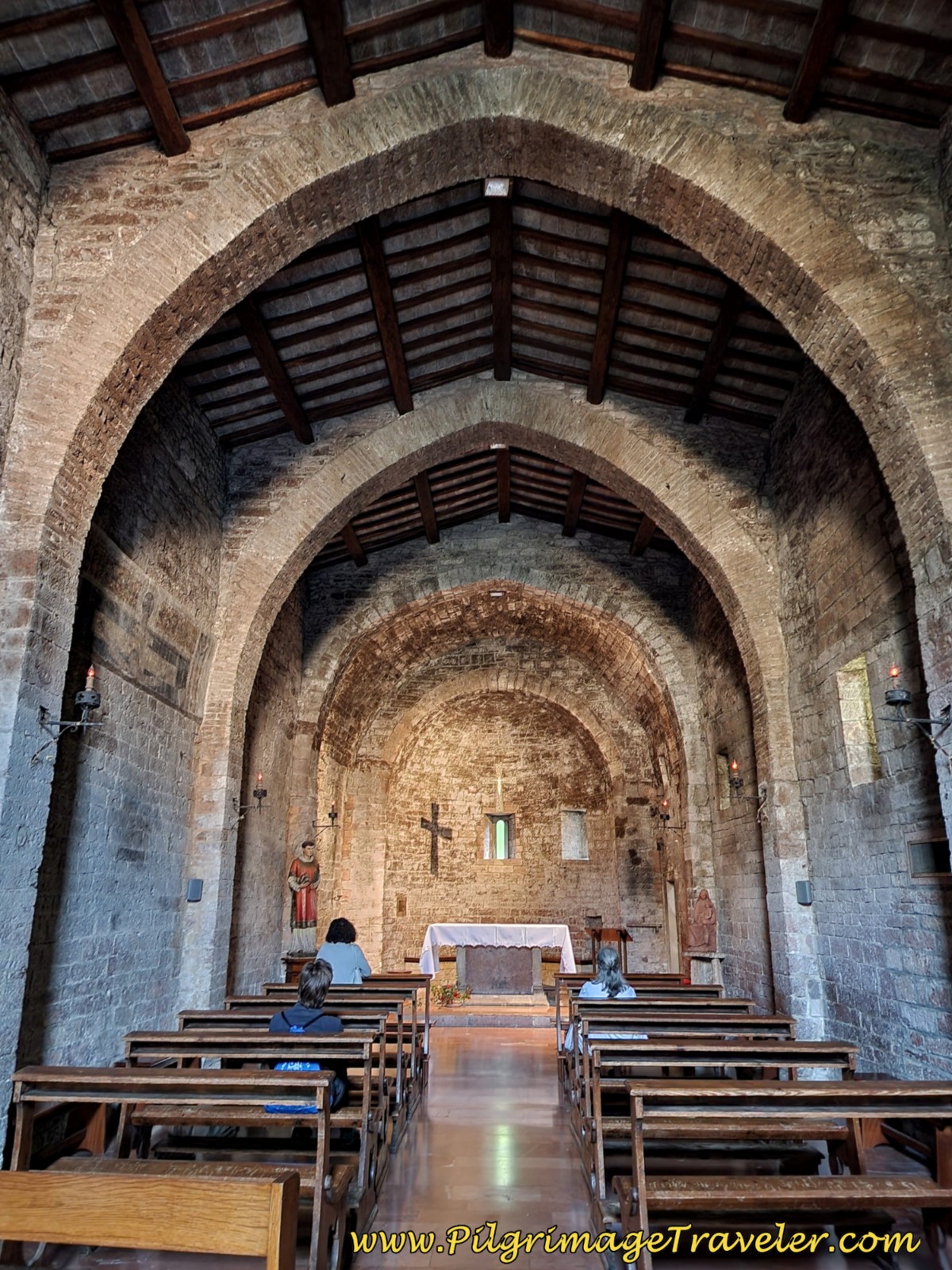 Interior of the Chiesa di Santo Stefano
Interior of the Chiesa di Santo StefanoThere are some badly damaged frescoes, the one below being the best one, of the Madonna and child, 14th century. According to the Key to Umbria website, the faces were repainted.
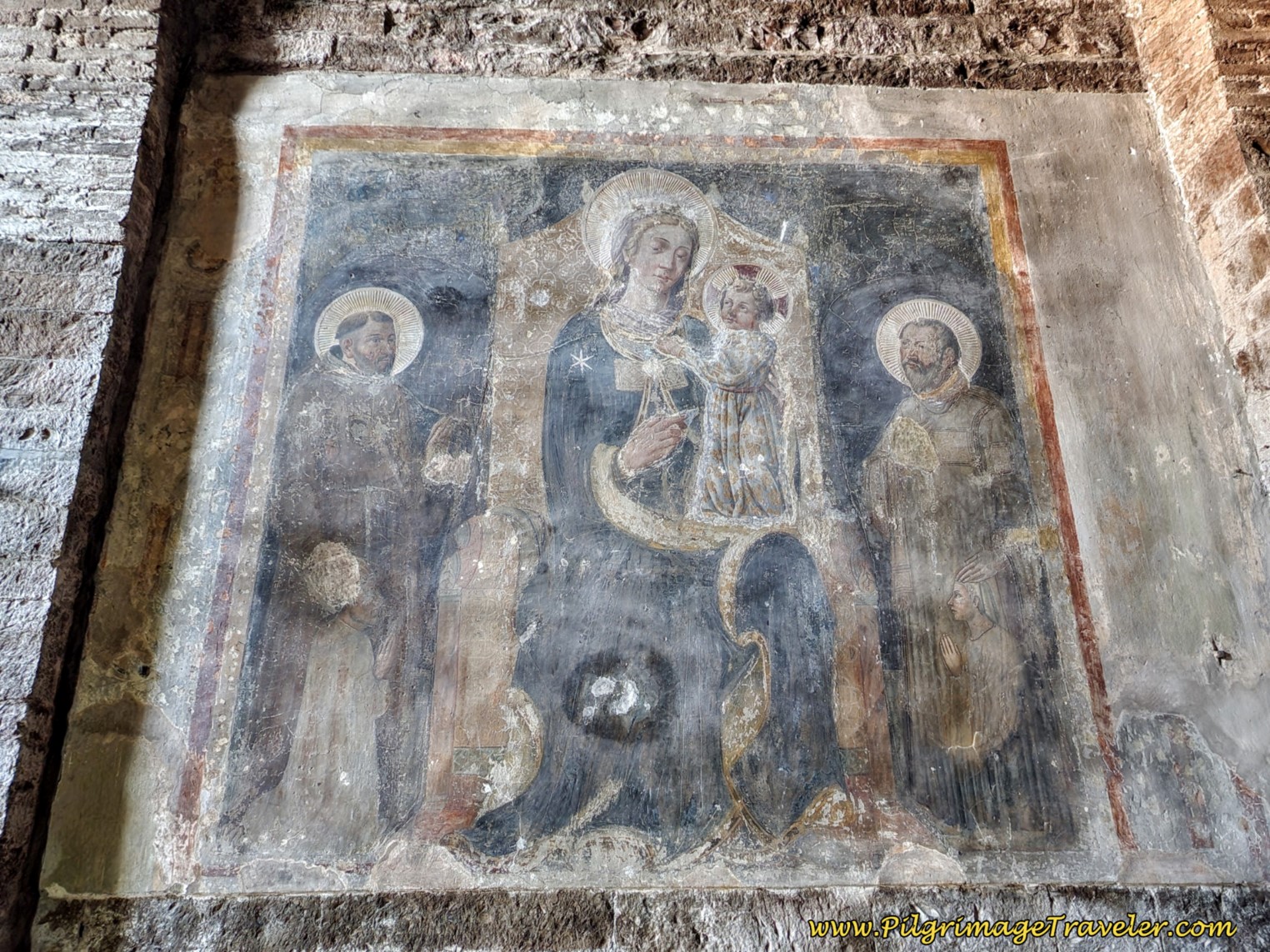 Fresco, Madonna and Child, Assisi, A Sacred Medieval Treasure
Fresco, Madonna and Child, Assisi, A Sacred Medieval TreasureMoving eastward, the next attraction we visited was the Chiesa di Santa Maria sopra Minerva in one of the large central piazzas of Assisi, the Piazza del Comune. On day ten, of our Way of St. Francis pilgrimage, I placed an amazing night time view of this fascinating church built into the 1st century Roman Temple to Minerva. Below is the daytime version.
This temple is one of the best preserved from its time. Like the Pantheon in Rome, it survives in a preserved state because of the fact that it was converted into a church.
The church was last remodeled in 1634, but more embellishments continued into the 18th century, including most of the frescoes. The Baroque high altar is made of gilded stucco and is very ornate.
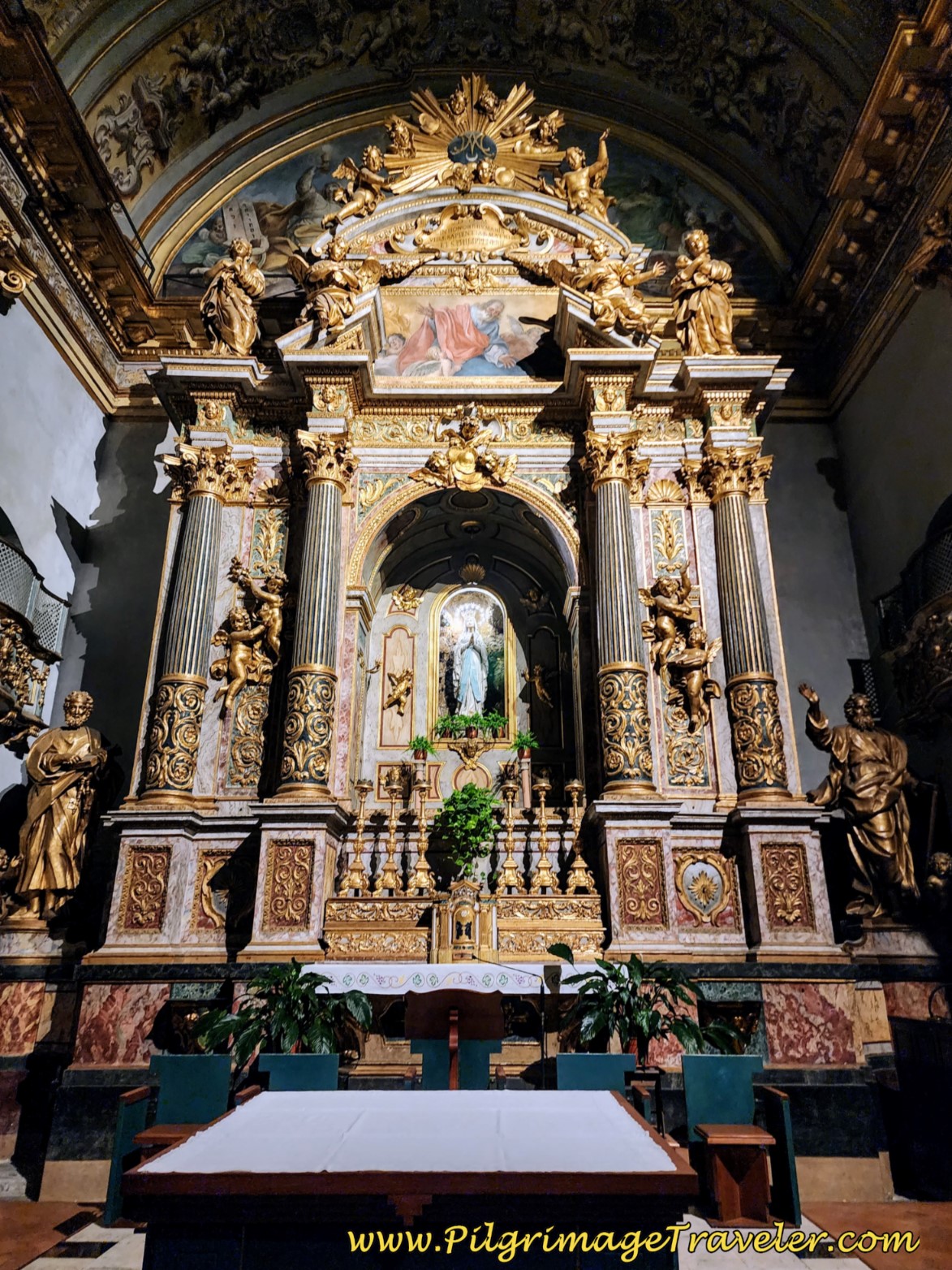 Chiesa di Maria Sopra Minerva, High Altar
Chiesa di Maria Sopra Minerva, High AltarAs we continued farther, more southeasterly and along the Corso Mazzini, in the twilight of our first evening, this lovely looking artwork within an arch caught my eye, pictured next. I did not know it at the time, but this is the entryway to a passage to the Santuario di San Francesco Piccolino, a 13th century Romanesque/Gothic chapel. Because of its proximity to the Chiesa Nuova (see farther below), this tiny oratorio is venerated as the stable next to the house where St. Francis was born. If I had known, I would have taken the few steps downhill to see it. The entryway was certainly inviting in the near dark!
Just beyond the Piccolino Chapel, is another one of the eight gates of Assisi, the Portella di San Giorgio. We were on our way to St. Clare's Basilica and the piazza overlook there. The gate, shown below, marks the beginning of the Via Santa Chiara.
Saint Clare (Santa Chiara), the beloved female counterpart of St. Francis, who created her own order for nuns, also has a church in Assisi dedicated to her, the Chiesa di Santa Chiara. This church, perhaps in the opinion of one as feminine as I, is no less in importance than the Basilica of St. Francis.
St. Clare's church was consecrated in 1265, and it was built up against the ancient church of San Giorgio, which is now a side chapel.
When I first saw this church, made of pink and white limestone, and very reminiscent of the Basilica di San Francesco, it was at dusk. When I returned the next day to visit inside, I totally failed to capture a daylight photo. But, really, this one most likely would have been the most alluring!
Below left is a photo of the high altar. St. Clare is buried directly below it, the same as in the Basilica di San Francesco. Above the altar is Christ on the cross, which you will note is a dying Christ and of the same style as the San Damiano Cross.
In contrast, the original and most famous San Damiano Cross, in the Cappella di San Giorgio, below right is of a living Christ. This small chapel of San Giorgio communicates directly with the right side of the basilica.
The San Damiano Cross painting of the living Christ, is the very same cross under which St. Francis prayed at the Santuario San Damiano and was told to "Build my church, it is in ruin." This cross, while originally at San Damiano was later moved here into the Cappella di San Giorgio.
The tomb of St. Clare is directly under the high altar, in similar fashion to St. Francis's tomb. However, this architecture is delightfully feminine and flowing in contrast, and I was enchanted by it.
The stairway leading to a pulpit (?) was gorgeous, and fortunately, I could photograph it, below left. But the photographs absolutely do not give it justice. You have to see it to believe it.
And below right is the actual tomb, and an effigy of St. Clare lies on top.
Jump to Way of St. Francis Stages
The plaza, in front of the church, the Piazza Santa Chiara, is an amazing place to gaze over the valley below and to watch the sun go down. If you look closely in the photo below, you can see the soaring dome of the famous Basilica di Santa Maria degli Angeli, on the plain. This church is very, very significant, in that it was built over the chapel near where St. Francis died, see farther below.
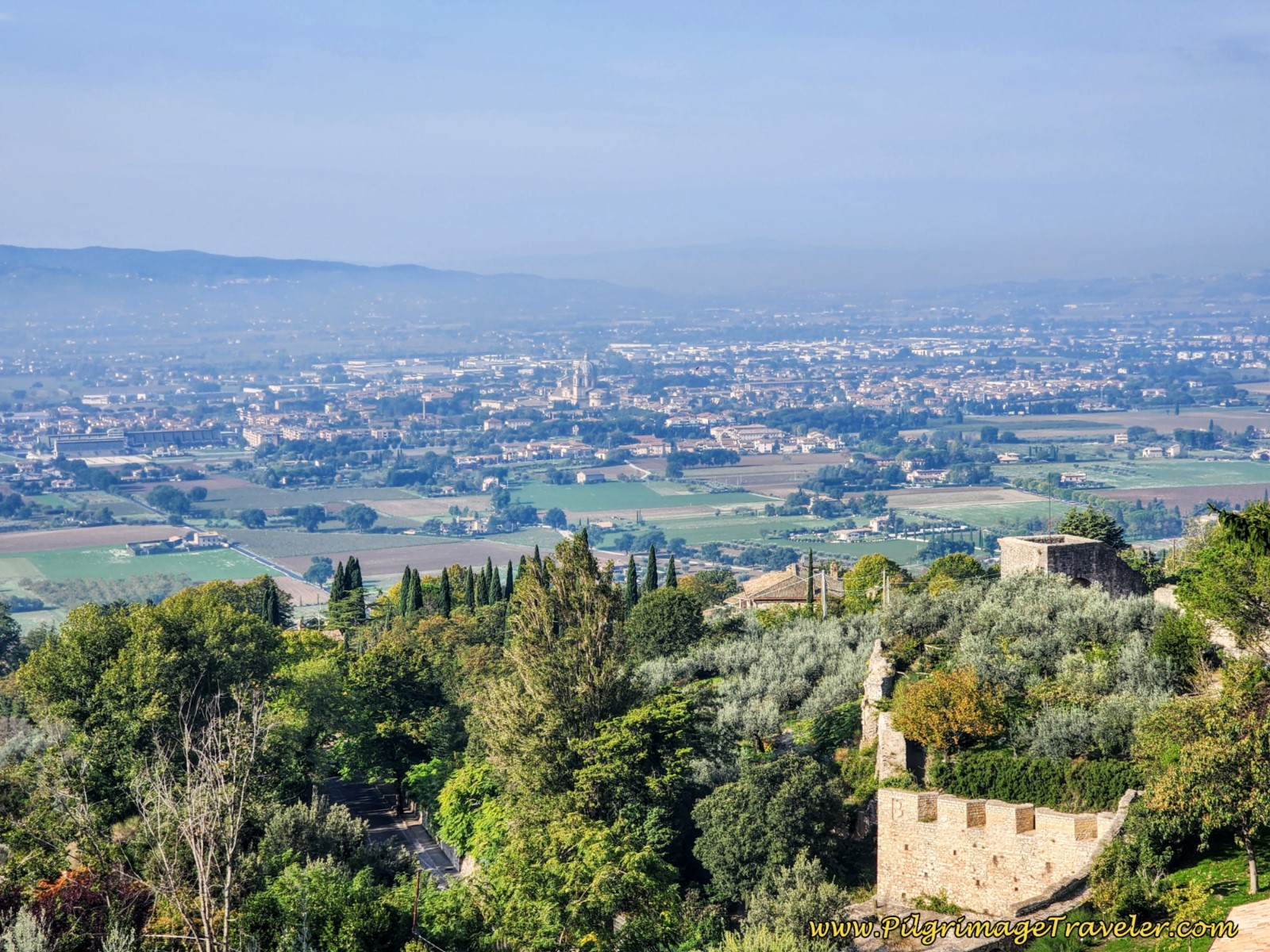 View of the Plain Below from the Piazza Santa Chiara
View of the Plain Below from the Piazza Santa ChiaraAnd indeed, we did arrive here just in time for the magical sunset on our first night here. It was favoloso! The belltower and the Chiesa di Santa Maria Maggiore provided the perfect foreground for the blessed sight!
Earlier, during the first evening, we went to the Chiesa di San Rufino, but decided we did not have enough time to see it before sunset. Unfortunately, we didn't have time the next day to see it either.
Here is a photo of the outside, and if you wish to read more about it, click the link immediately above. This is the church that is famous because it is where both St. Francis and St. Clare were baptized. St Francis often preached here.
The church, one of the earliest in Assisi, a sacred medieval treasure, has a very long history and contains a museum. The current church was built atop the former one, and there are layers of archeology noted here, dating as far back as the Roman era.
The next day we visited the Chiesa Nuova, a chapel built over the presumed site of St. Francis' parents' home and his birthplace. We only walked by and did not enter. Click on the link to see what this church has to offer. You can see a sculpture of the saint's parents in the church's piazza in the photo below.
According to the link above, in 1613 a Franciscan friar visited this site and noted the decrepit state of the saint's parents home. He bought the home and managed to convince the king of Spain to finance the building of a church and even got the blessing of the pope, so that the first stone laid was consecrated in 1615 and the church completed in 1621.
Assisi, a medieval and sacred treasure wouldn't be complete without a castle on the hilltop, and the Rocca Maggiore is it. You can see it soaring above the rooftops of the city from various vantage points. I believe I took this photo from the Piazza Santa Chiara.
It is currently closed for restoration and you can see the crane hovering over it. I have been unable to find a reopening date.
To the west of the Piazza Santa Chiara, the Chiesa di Santa Maria Maggiore was the original duomo of Assisi and was the main cathedral during the time of St. Francis. It is one of the oldest churches in Assisi, originally built in the 4th century and rebuilt in the 10th. Within the old duomo is the Santuario della Spogliazione (Stripping), newly dedicated in 1917, honoring the place where St. Francis stripped off his clothing in front of his father, denouncing earthly wealth.
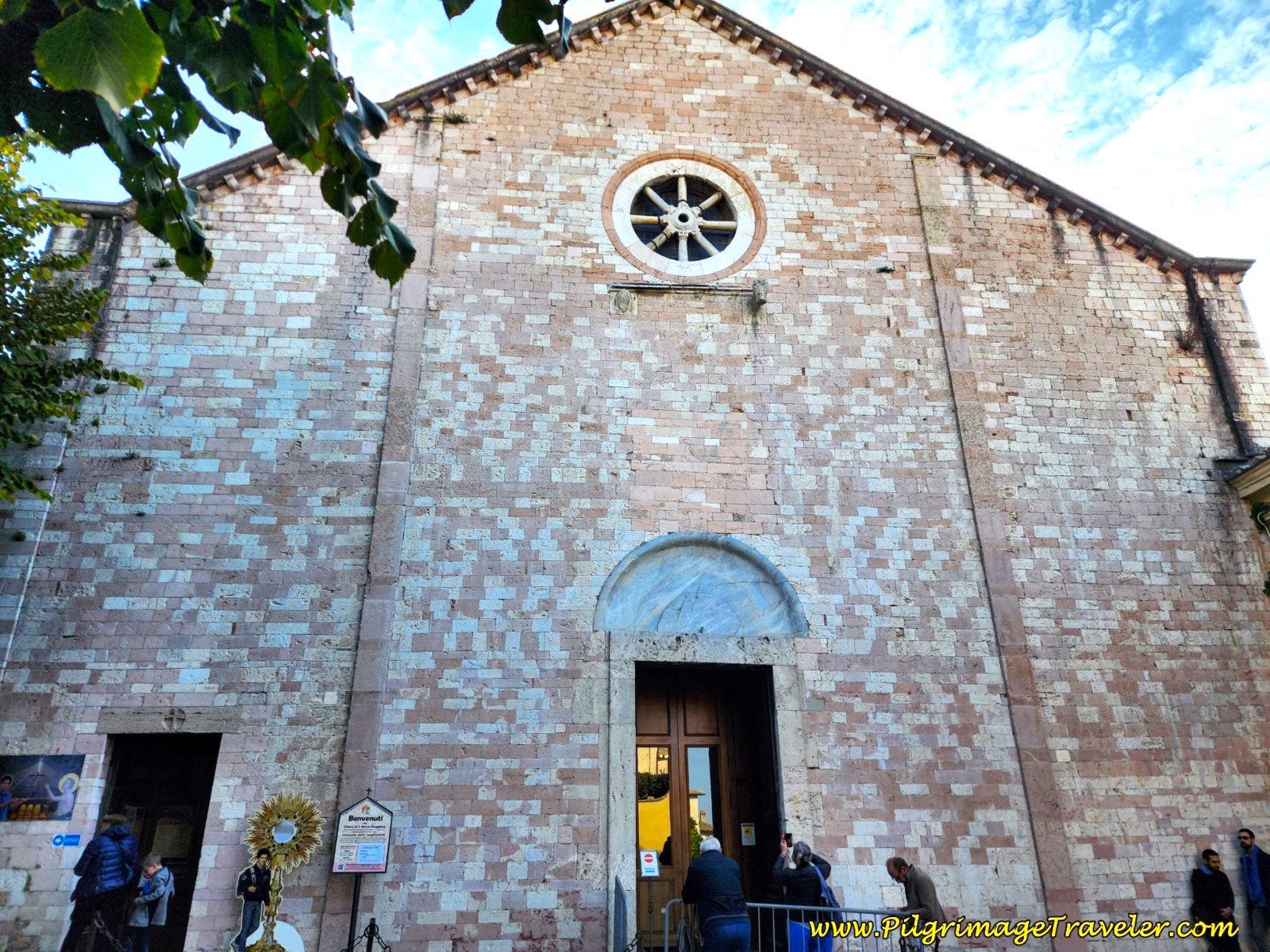 Chiesa di Santa Maria Maggiore
Chiesa di Santa Maria MaggioreAlso within the Spogliazione sanctuary is the modern phenomenon of Carlo Acutis whose body was moved from the cemetery in Assisi to this venerable place. Carlo passed away from leukemia in 2006 at the age of 15 and is in the process of being considered for sainthood. Wow! You can read about his life from the link provided.
The face on the "body" that you will see in the crypt has been siliconized and rather macabre, in my opinion. I did not take any photos for this reason and also because the sanctuary was jam packed with people venerating his life. I couldn't even get close unless I waited in a long line!
Of note, outside the church in the same plaza is a very old fountain, the Fontanella del Lione (1556-7). There once was a lion's head on the top of this fountain, but it is now gone, however, it kept the Lione name.
After leaving the fountain, we walked north to the Piazza del Vescovado, and found the narrowest, most quaint medieval street of all, the Via Bernardo da Quintavalle.
We continued to walk northwest along the Via Fontebella, where we came to a wonderful viewpoint of the countryside to the south. Across from it is another one of the oldest fountains in Assisi, the Fonte Marcella (1556-7), pictured below.
It is a bit farther west of the fountain that you will find a wonderful stairway leading down to the lower levels of Assisi, shown below.
From here, we were going to walk approximately three kilometers to the place of St. Francis' death, the Basilica di Santa Maria degli Angeli.
Jump to Way of St. Francis Stages
We followed the Google maps walking directions and wound our way down through the city, exiting at one of the medieval gates, and crossing over and down a set of stairs to a red brick, paved walkway.
The walkway leads to a main street that makes up the predominant portion of the walk, along the Viale Patrono d'Italia, shown below. At this point, the wonderful red brick walkway becomes tree-lined as well. You will follow the brick walkway for about two of the total kilometers. It makes for very easy walking.
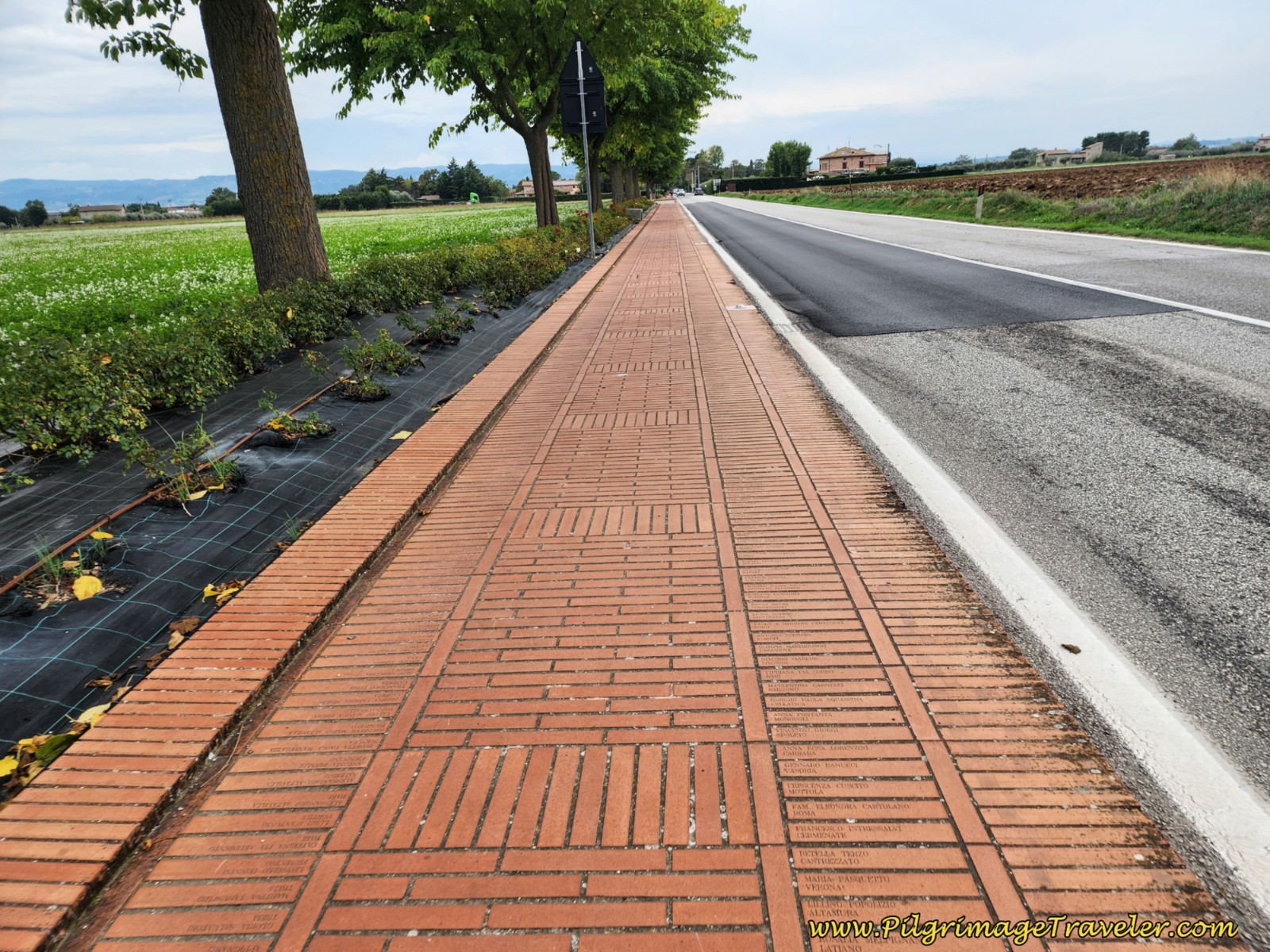 Path of Peace and Happiness
Path of Peace and HappinessIf you are not returning to Assisi via this walkway, in the beginning labeled with "Pax et Bonum," Peace and Happiness (see farther below for photo), don't forget to turn around and gaze at the views of Assisi, a sacred medieval treasure, from the plain below!
You will soon arrive at the gigantic Basilica di Santa Maria degli Angeli, from the rear, since the main façade is towards the southwest, shown below. It seemed to me to be an inappropriate place for the tiny chapel near where the saint died. This important chapel in the life of St. Francis is contained within the basilica, which was built over it.
The basilica was first built, starting in 1569, then rebuilt to its present state in 1832 after a major earthquake. To read more about the basilica, its side chapels and its art, click the link above. I was not interested in the basilica, only the place of St. Francis' death.
The tiny chapel, known as the "Portiuncula (little portion)," is originally of the 10th or 11th Century, and is the 3rd church which St. Francis restored in the early 13th century, after his mandate at the crucifix of the church of St. Damien. It was here that he heard a sermon which led him to a life of evangelical poverty.
You will see the wonderful little Portiuncula in the crossing of the basilica, immediately after entering the huge church from the main entrance. It is a sight to behold.
When St. Francis felt his impending death, he requested to be brought to this place. A simple hut near the chapel served as an infirmary for him where he died.
Below is the side view of this little church-within-a-church in the crossing. I don't think I felt the presence or the reverence for St. Francis more in any other place. There is a real Presence in this place that must not be missed!
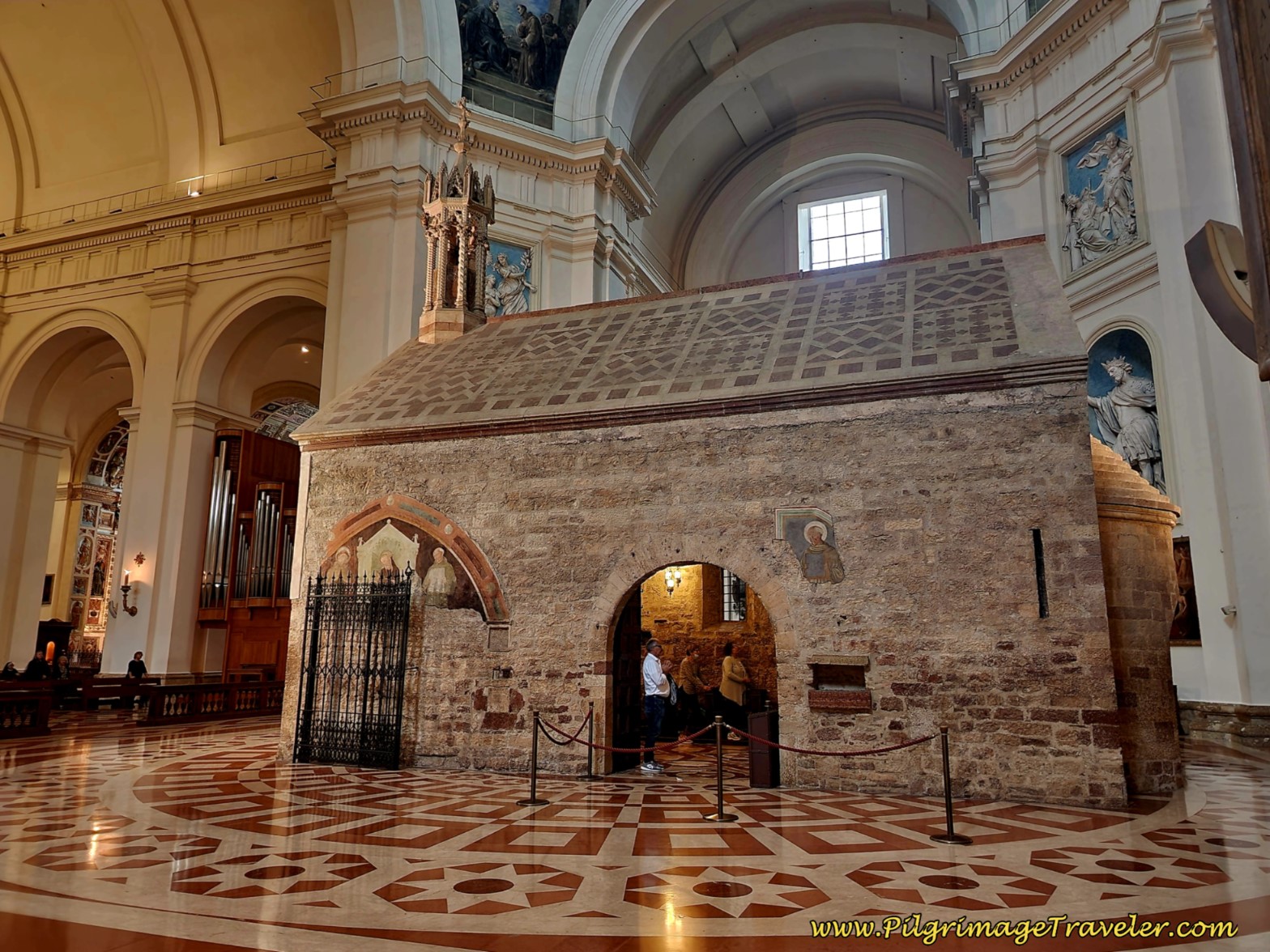 Portiuncula, Basilica di Santa Maria degli Angeli
Portiuncula, Basilica di Santa Maria degli AngeliI should have paid more attention to the basilica itself, I suppose, especially to one of the side chapels, the Cappella del Transito. According to the Key to Umbria website, this chapel, "on the right side of the presbytery incorporates part of an earlier chapel (13th century) that was built on the site of the infirmary of the Portiuncula. The rectangular chapel has a semi-hexagonal interior. St Francis died in the infirmary in 1226." So, we actually missed seeing the chapel on the site where the saint actually died.
Perhaps this was a good thing, since the Cappella del Transito, not being the actual place of his death, but a re-creation, may not have impacted me the same way. I don't know, but it gives me another reason to return.
After paying our respects at the basilica, our very last place left on our wish list was to see the Santuario San Damiano, the place where it all began. This is where St. Francis saw the vision from God to rebuild his church. It is the very first church which he restored.
San Damiano is also where St. Clare established a small religious community in 1211 that became known as the Order of San Damiano and where she died in 1253.
At present, the monks sing most evenings in the church after it closes, for Vespers, which started at 7:00 pm. For the seasonal calendar of masses and celebrations, click here.
We took a taxi from the Santa Maria degli Angeli church to the San Damiano church, and this is how it appeared to us at dusk, just before Vespers began.
As you would expect, the church is incredibly simple, and with a reproduction of the San Damiano cross above the altar, shown below left. Unfortunately, we did not stay for the service, as a young woman sat behind our pew, and was coughing constantly. It was a very congested-sounding cough. I was worried about Covid, so we left and sat outside for a brief period to listen to the monks singing.
We quietly walked back up the hill to Assisi, entering the Porta Nuova gate, shown below right, to return to our room, very tired, but happy pilgrims.
Reflections
Our best shots of Assisi, in my opinion, are of her glowing in the dark. As we left town prior to dawn on our way toward the train station, in the same direction as the church-within-a-church, we followed the brick road of Peace and Happiness. I snapped this photo, below.
Yes, we had received Peace and Happiness in Assisi, a sacred medieval treasure. And yes we had also received Peace and Happiness, walking the 10 days on St. Francis' Path of Peace, the Via di Francesco. It was a wonderful and successful pilgrimage!
Salutation
May your own pilgrimage to Assisi, a sacred medieval treasure, be filled with peace and happiness as you explore the "will of an epoch translated into space!"
Way of St. Francis Stages
Please Consider Showing Your Support
Many readers contact me, Elle, to thank me for all the time and care that I have spent creating this informative website. If you have been truly blessed by my efforts, have not purchased an eBook, yet wish to contribute, I am very grateful. Thank-you!
Search This Website:
🙋♀️ Why Trust Us at the Pilgrimage Traveler?

We’re not a travel agency ~ we’re pilgrims, just like you.
We've walked Pilgrimage Routes Across Europe!
💬 We’ve:
- Gotten lost so you don’t have to. 😉
- Followed yellow arrows in the glowing sunlight, the pouring rain and by moonlight. ☀️🌧️🌙
- Slept in albergues, hostals & casa rurals. Ate and drank in cafés along the way. 🛌 😴
- Created detailed and downloadable GPS maps and eBook Guides, full of must-have information based on real pilgrimage travels. 🧭 🗺️
- Shared our complete journeys, step by step to help YOU plan your own ultimate pilgrimage and walk with your own Heart and Soul. 💙✨
Every detail is from our own experiences ~ no fluff, no AI rewrite. Just fellow pilgrims sharing the way. We add a touch of spirituality, a big dose of ❤️ and lots of wisdom from the road.
Ultreia and Safe Pilgrimage Travels, Caminante! 💫 💚 🤍
Follow Me on Pinterest:
Find the Pilgrimage Traveler on Facebook:
Like / Share this page on Facebook:
Follow Me on Instagram:
***All Banners, Amazon, Roamless and Booking.com links on this website are affiliate links. As an Amazon associate and a Booking.com associate, the Pilgrimage Traveler website will earn from qualifying purchases when you click on these links, at no cost to you. We sincerely thank-you as this is a pilgrim-supported website***
PS: Our eBook Guide books are of our own creation and we appreciate your purchase of those too!!
Shroud Yourself in Mystery, along the Via de Francesco!
Walk in the Footsteps of St. Francis, and Connect Deeply to the Saint and to Nature in the Marvelous Italian Countryside!
Need suggestions on what to pack for your next pilgrimage? Click Here or on the photo below!
Carbon fiber construction (not aluminum) in a trekking pole makes them ultra lightweight. We like the Z-Pole style from Black Diamond so we can hide our poles in our pack from potential thieves before getting to our albergue! There are many to choose from! (See more of our gear recommendations! )
Gregory BackPack - My Favorite Brand
Do not forget your quick-dry microfiber towel!
Booking.com
My absolute favorite book on how to be a pilgrim:
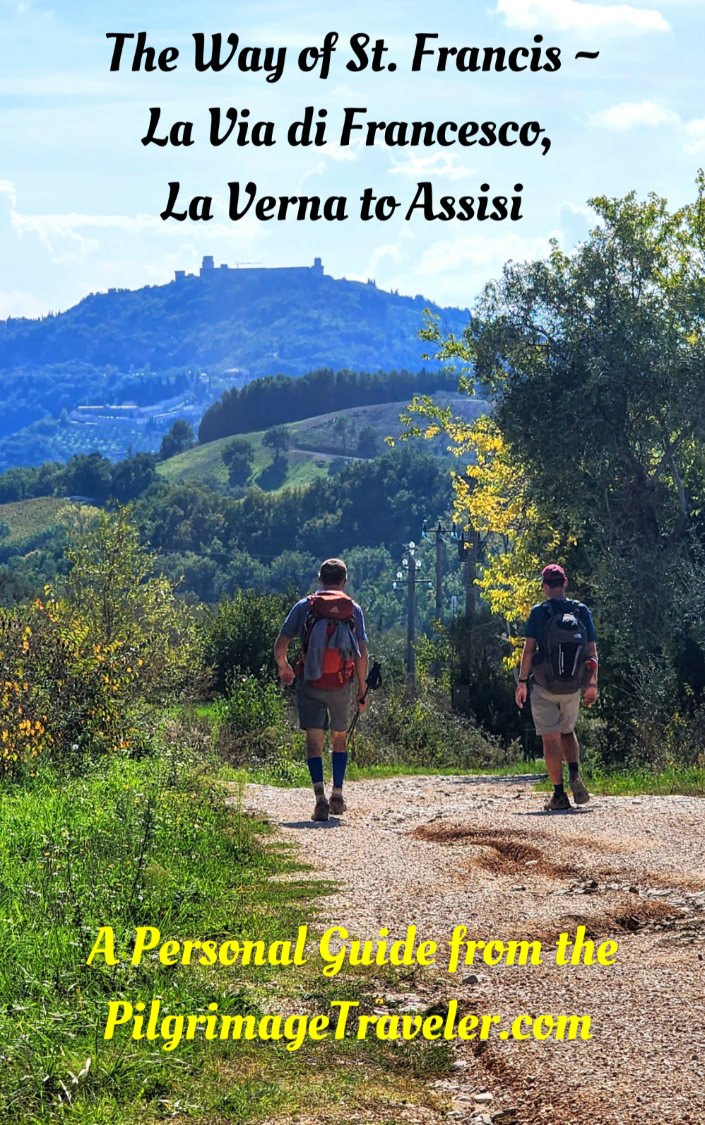
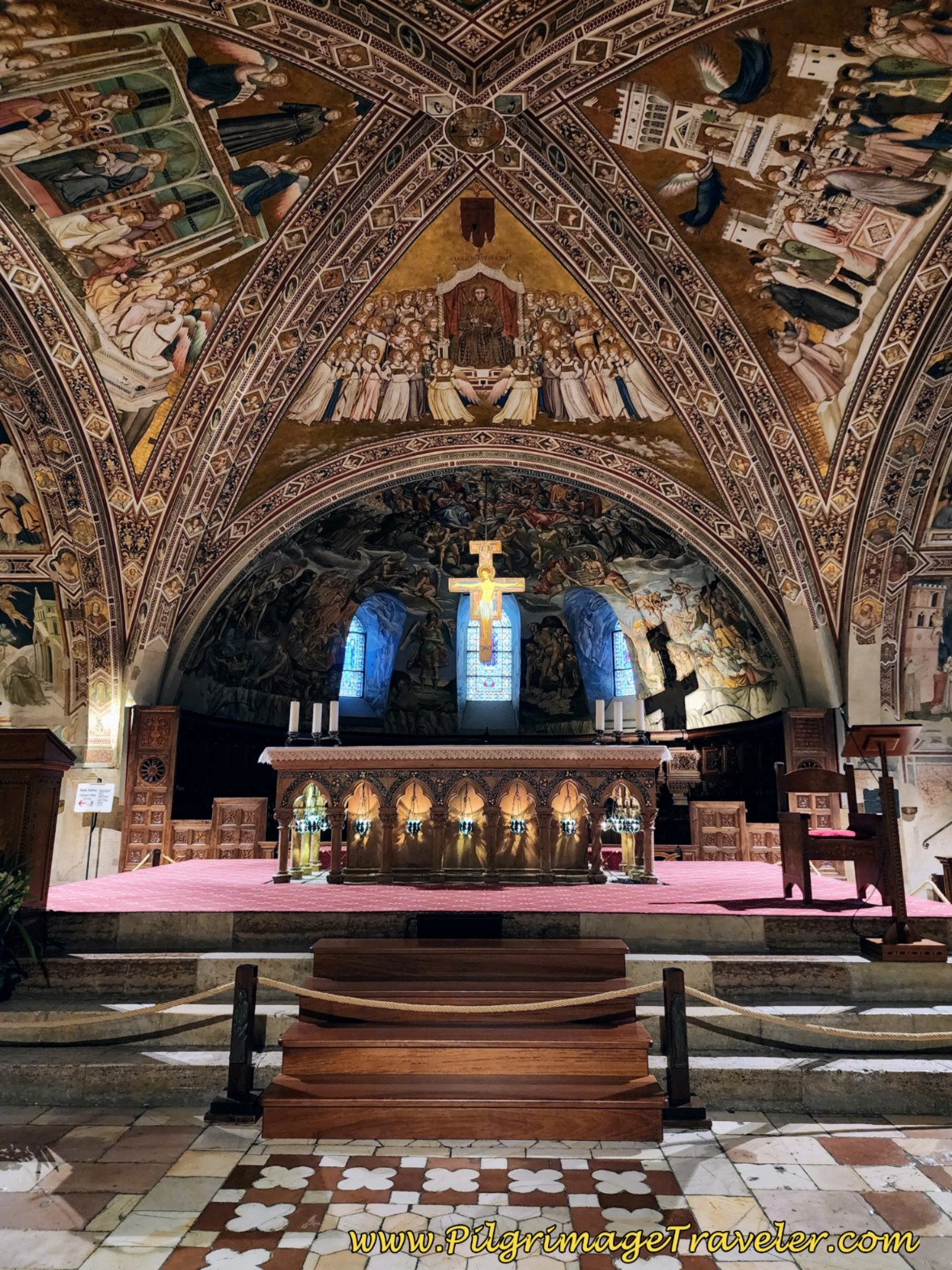
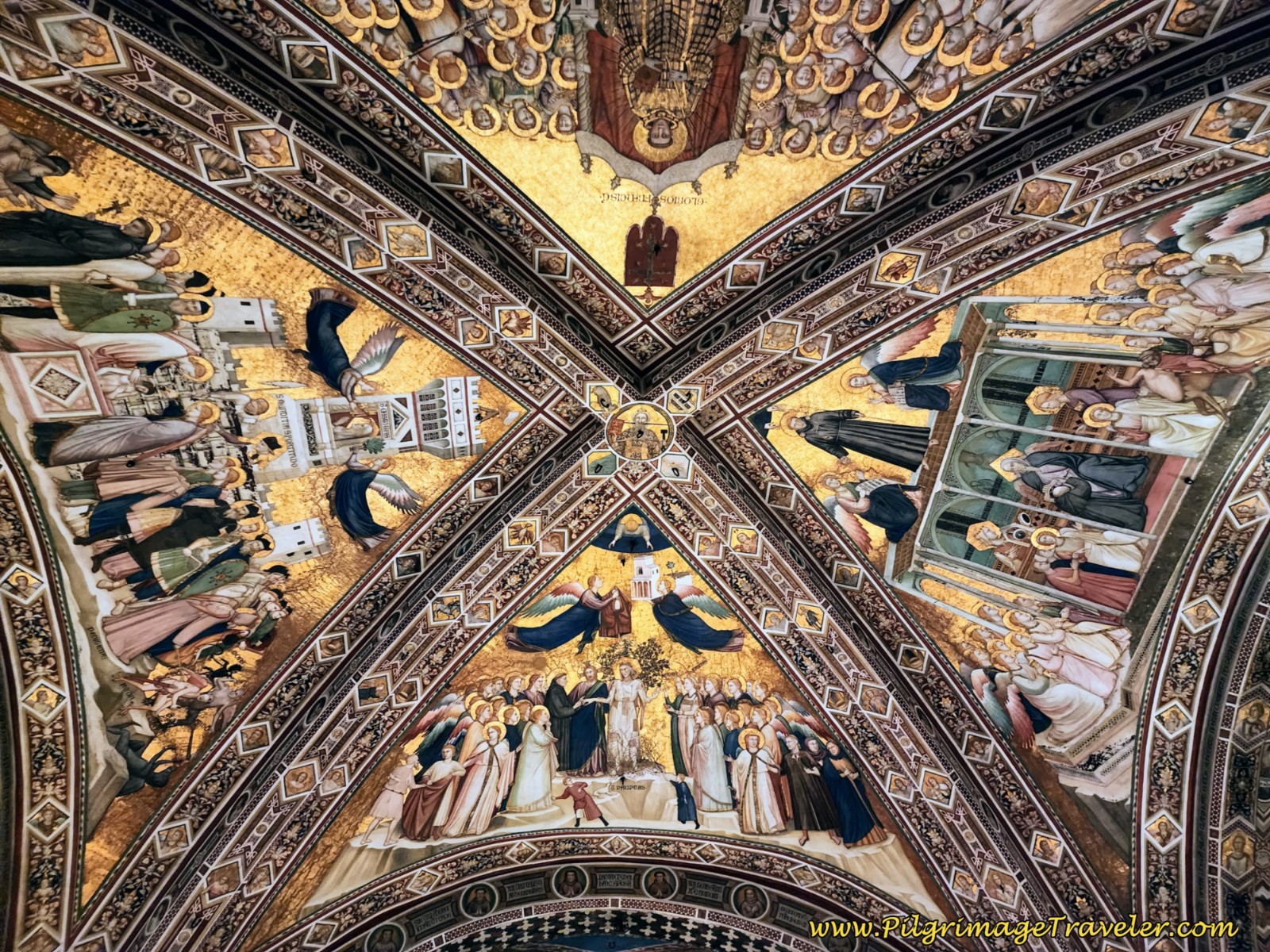
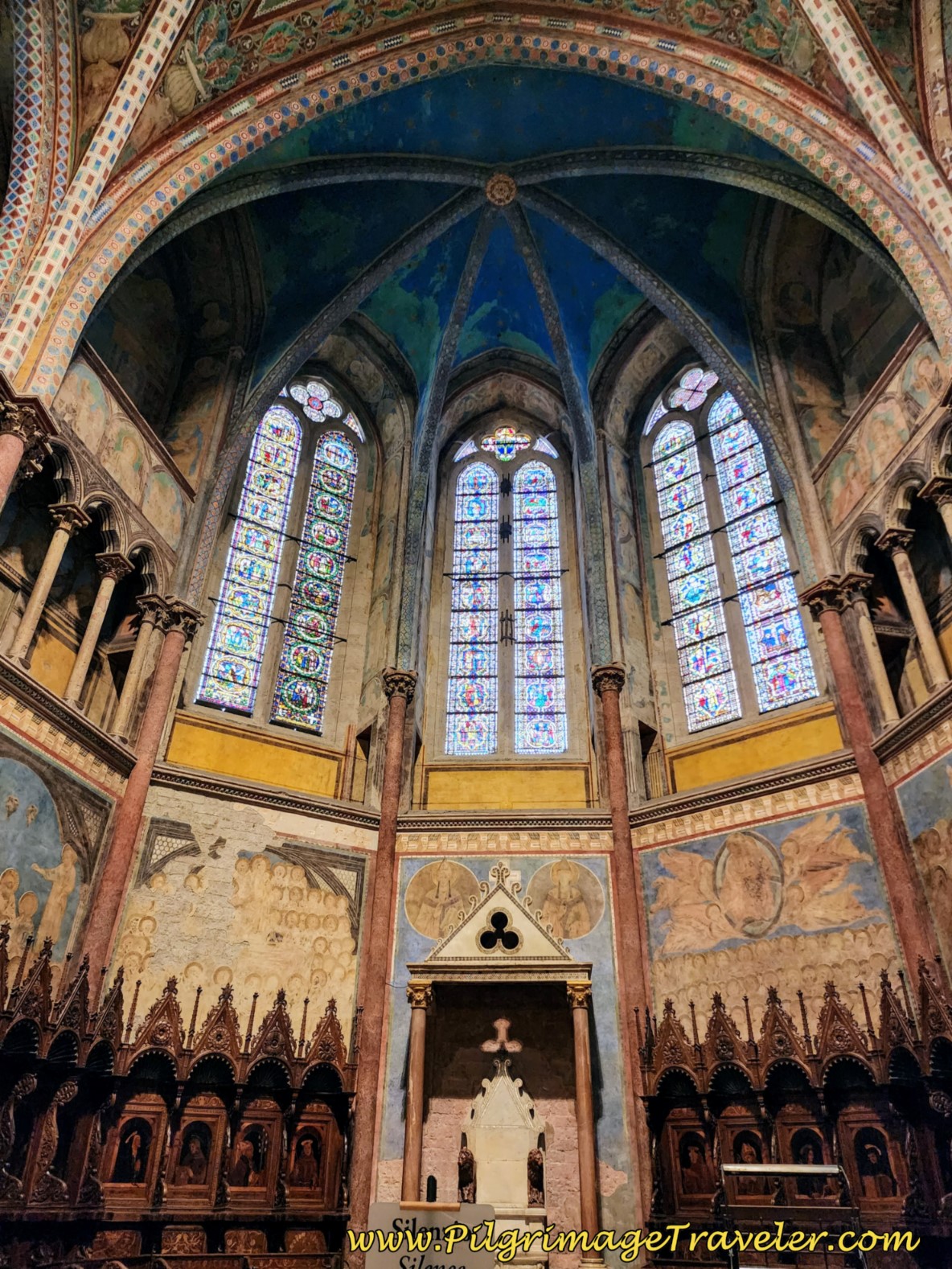
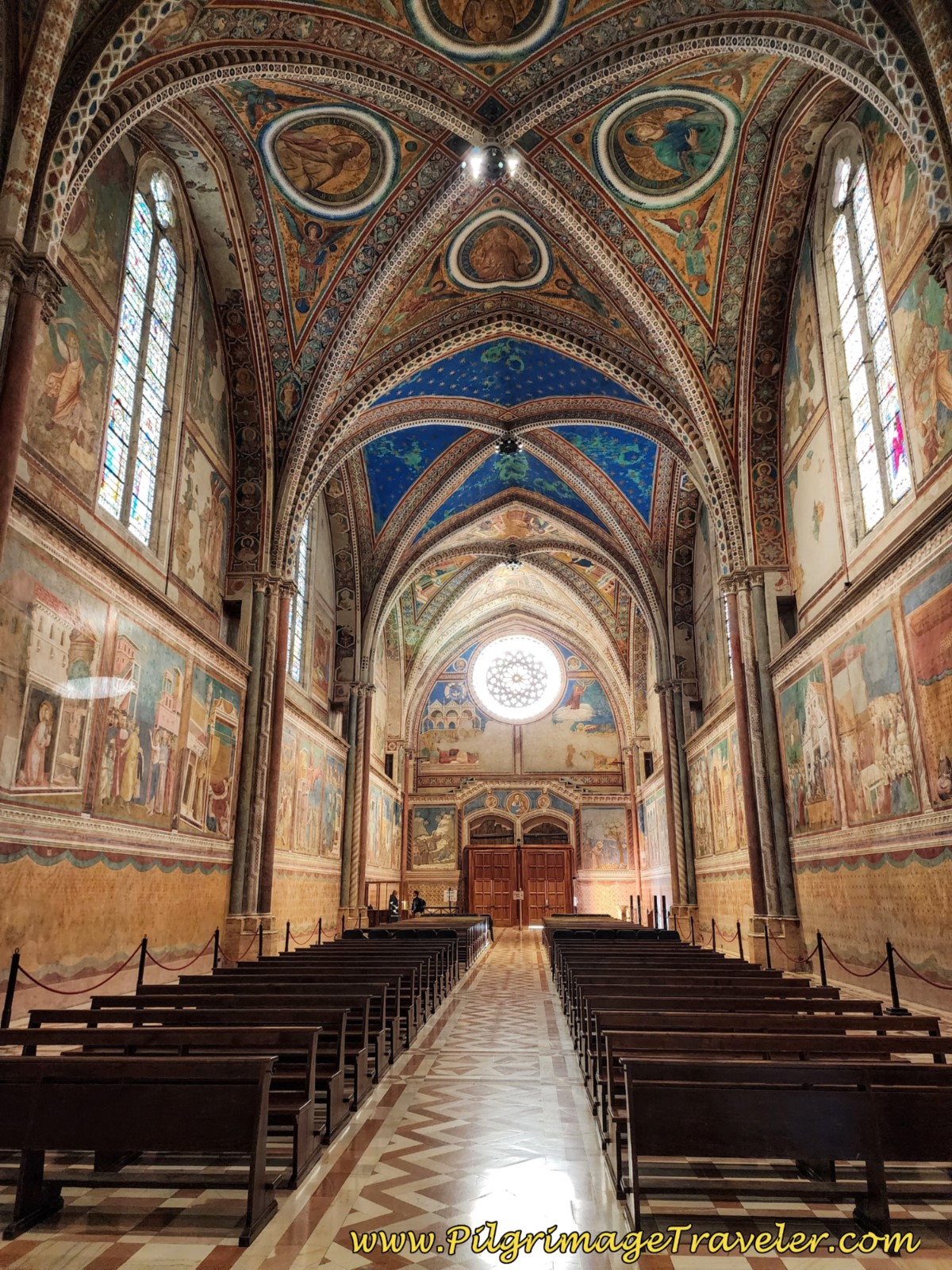
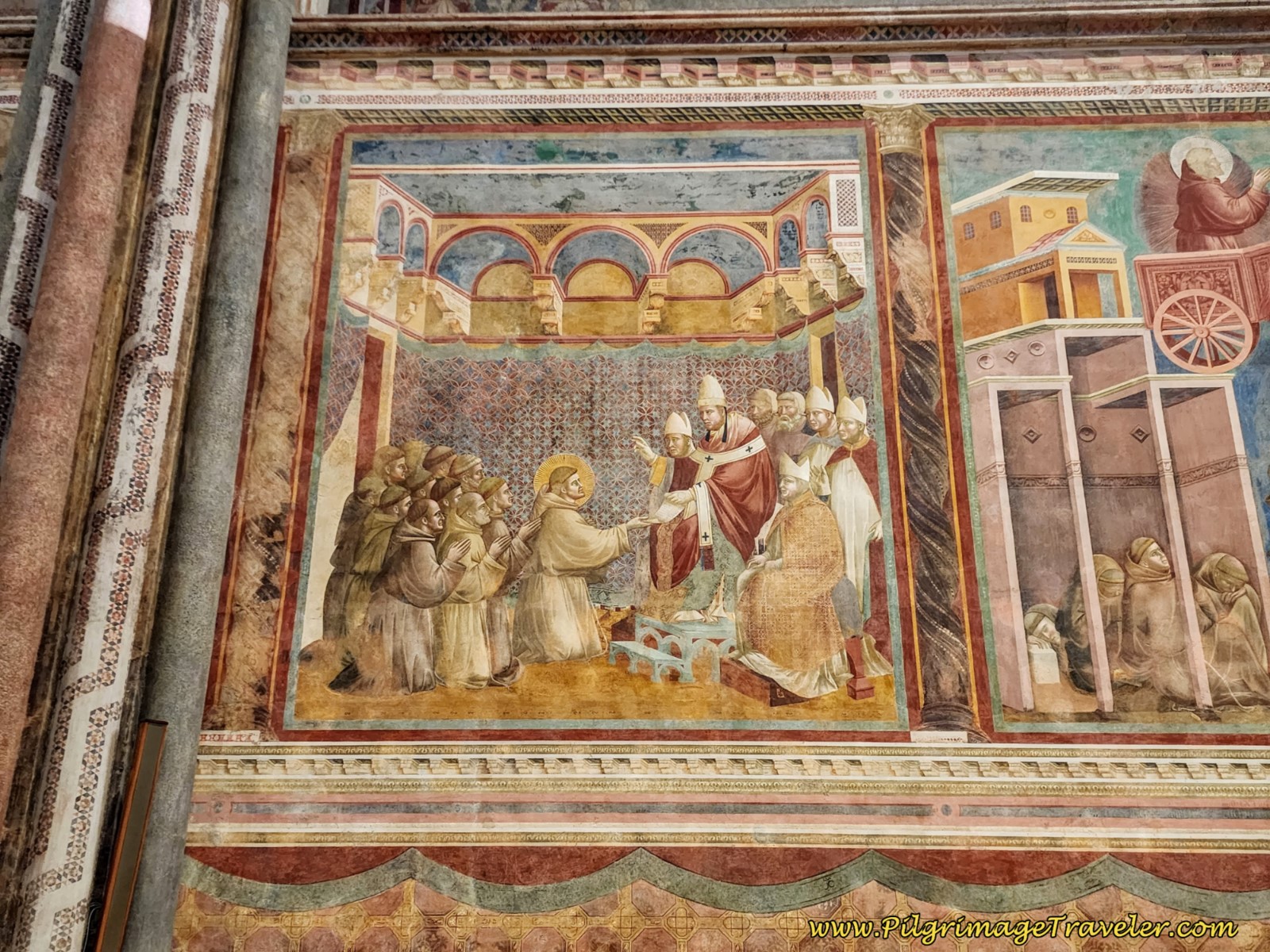
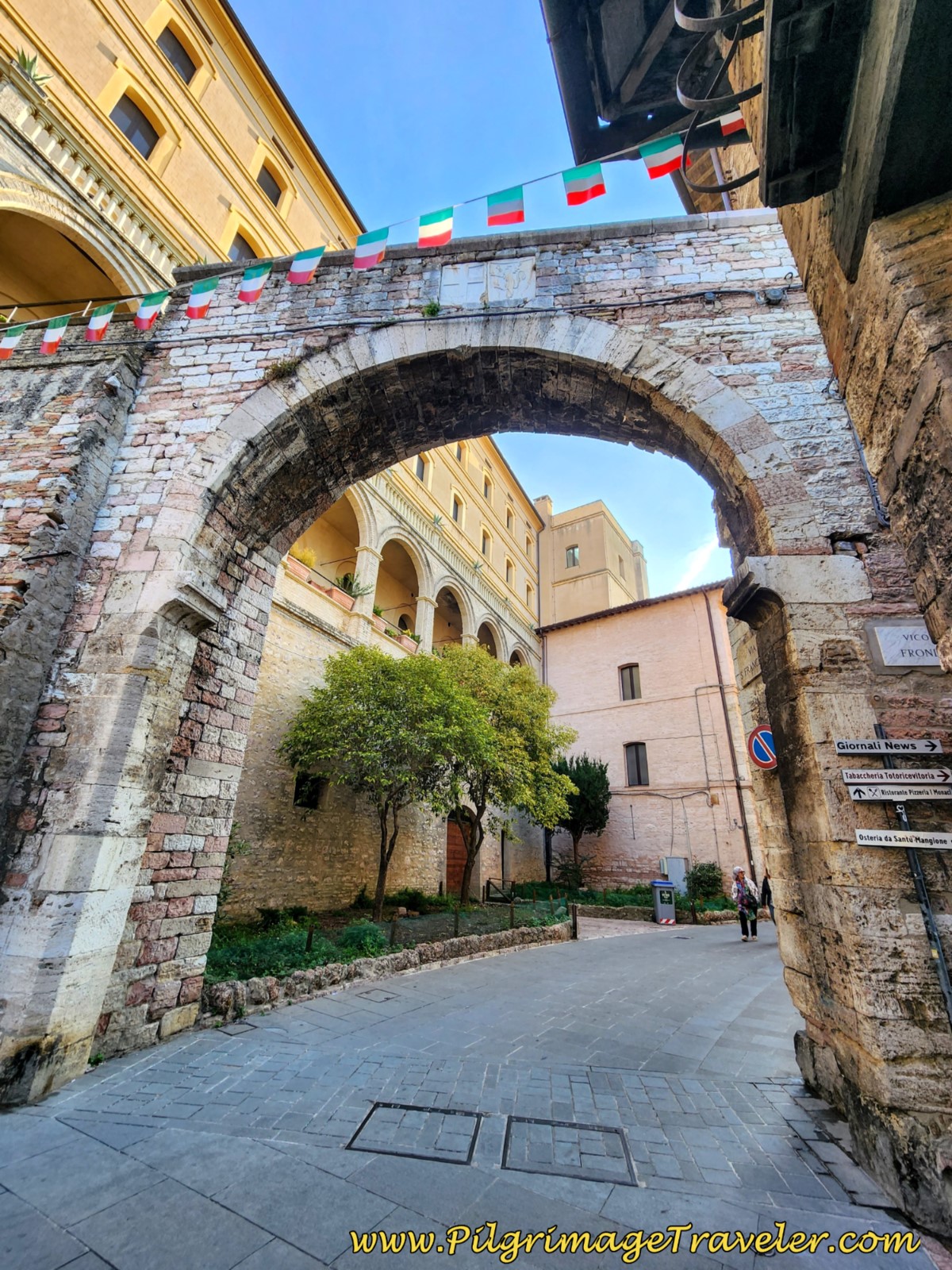
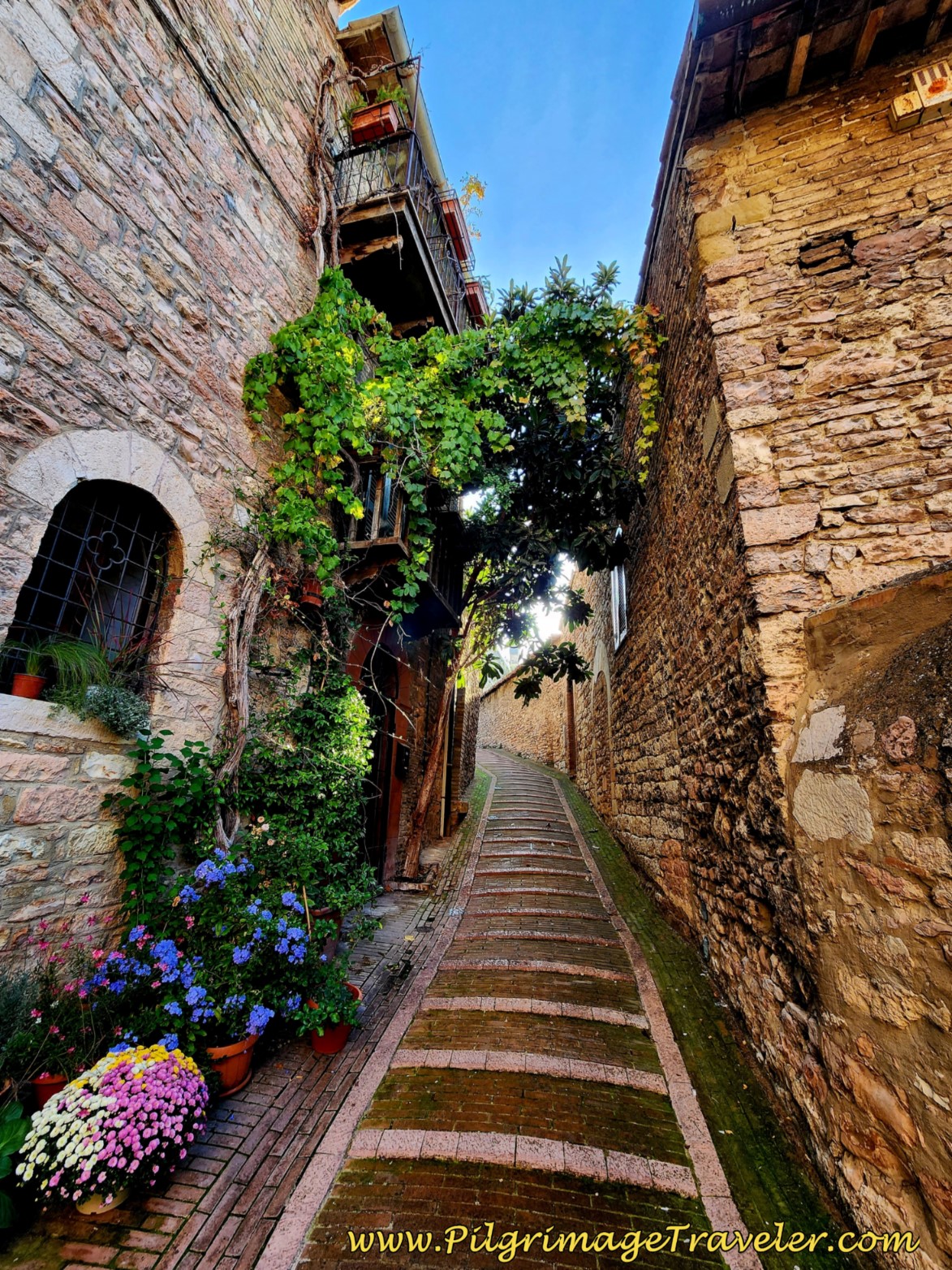
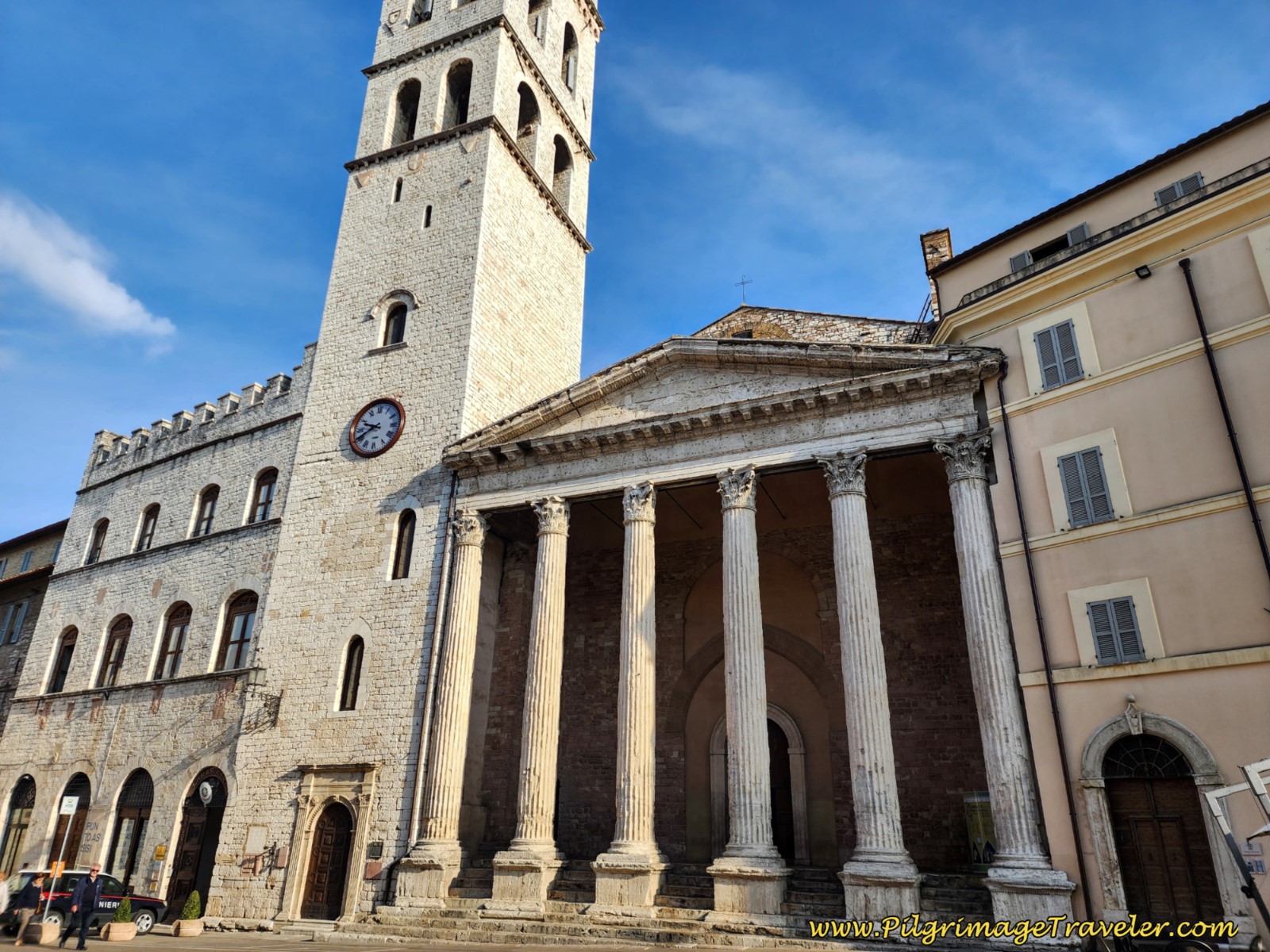

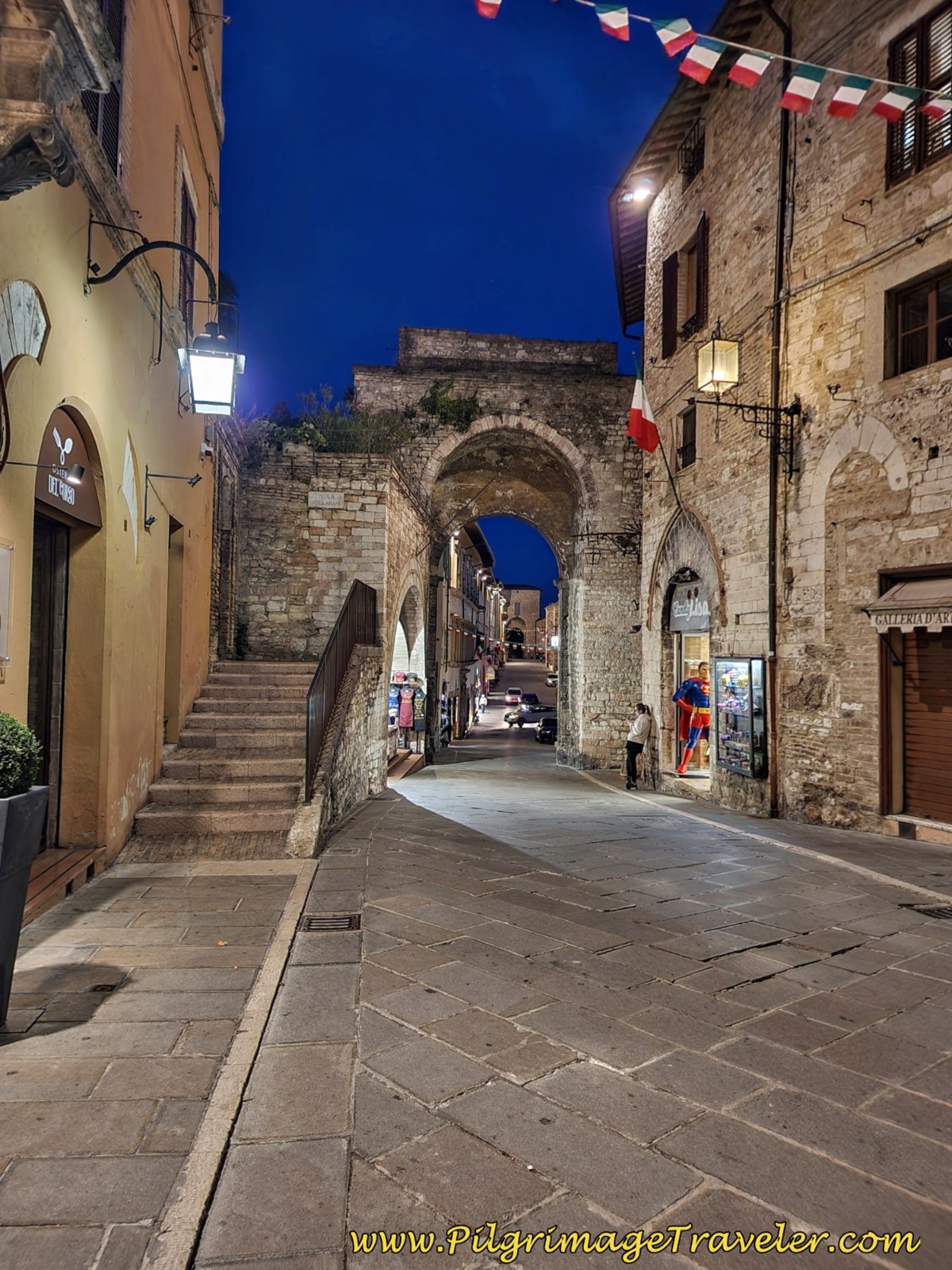
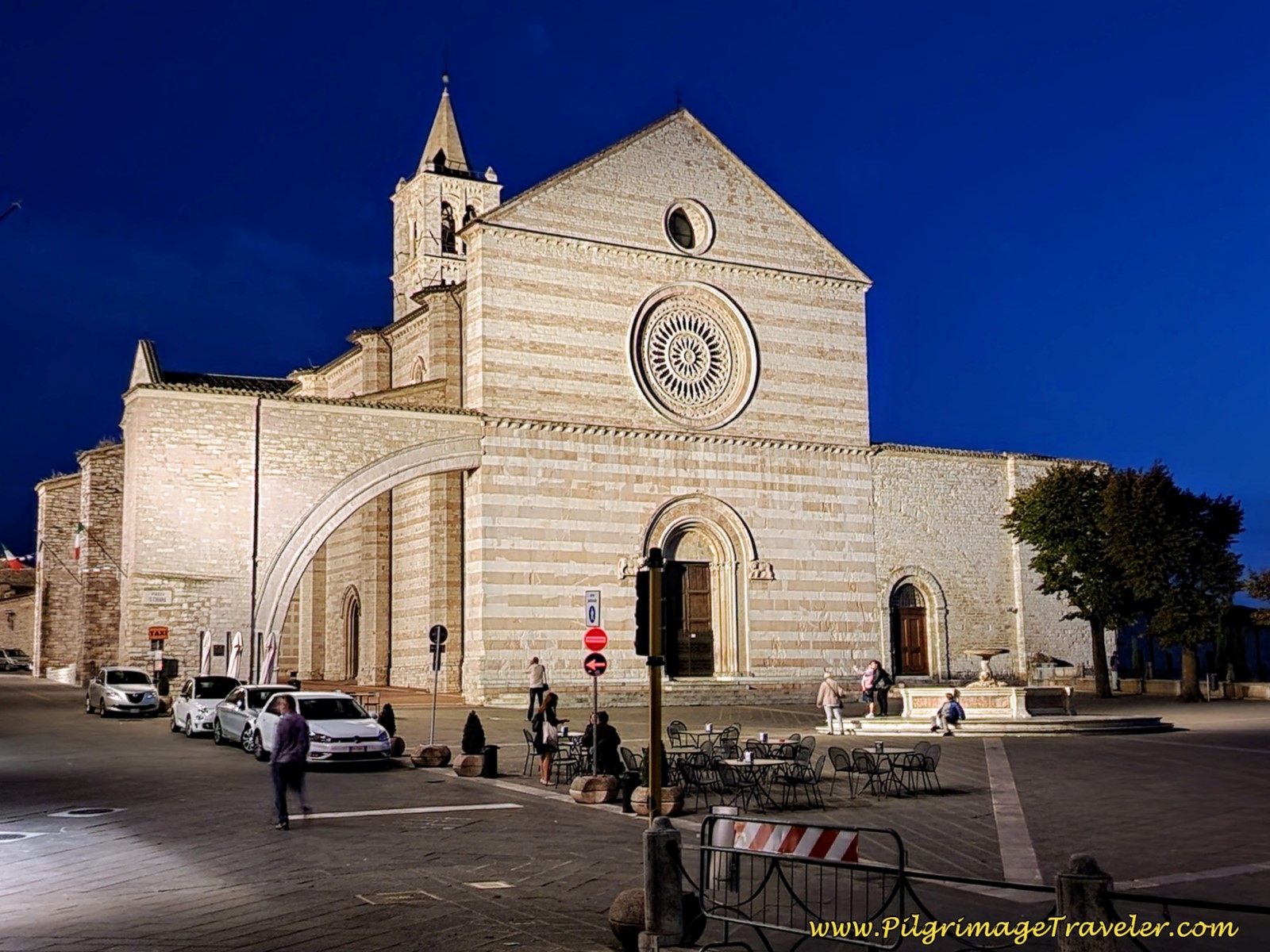

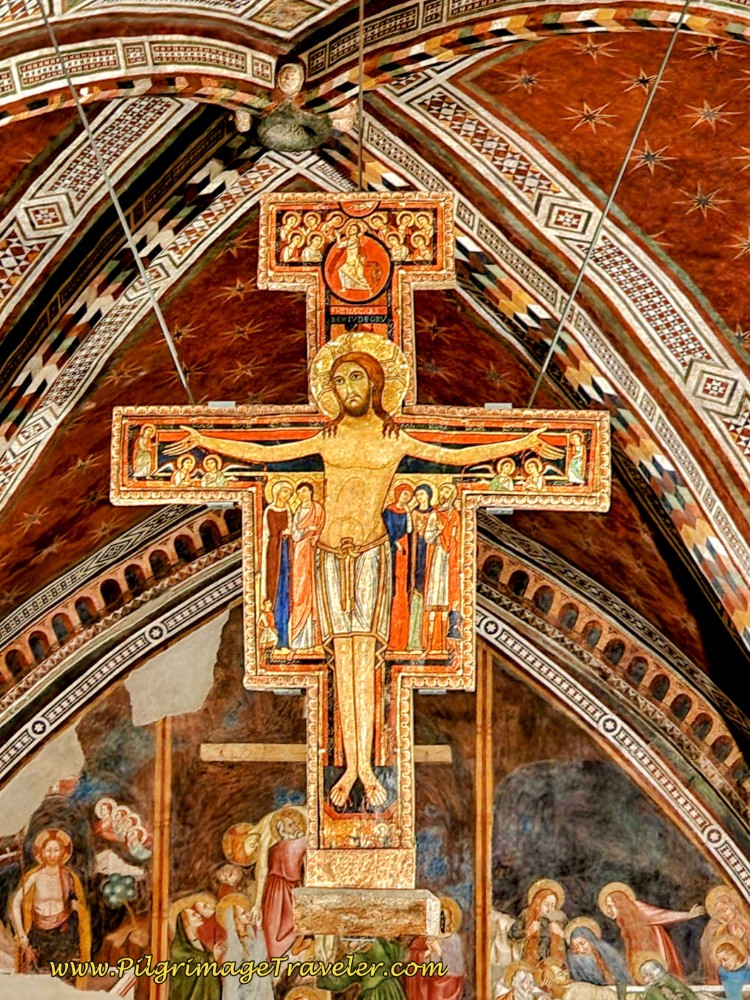
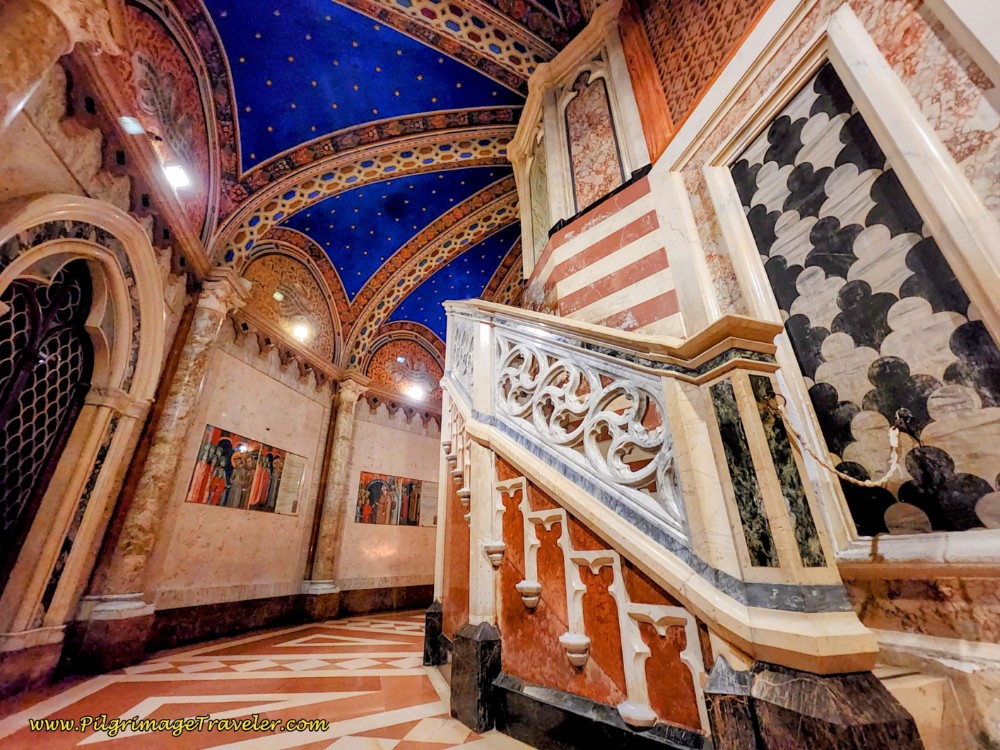
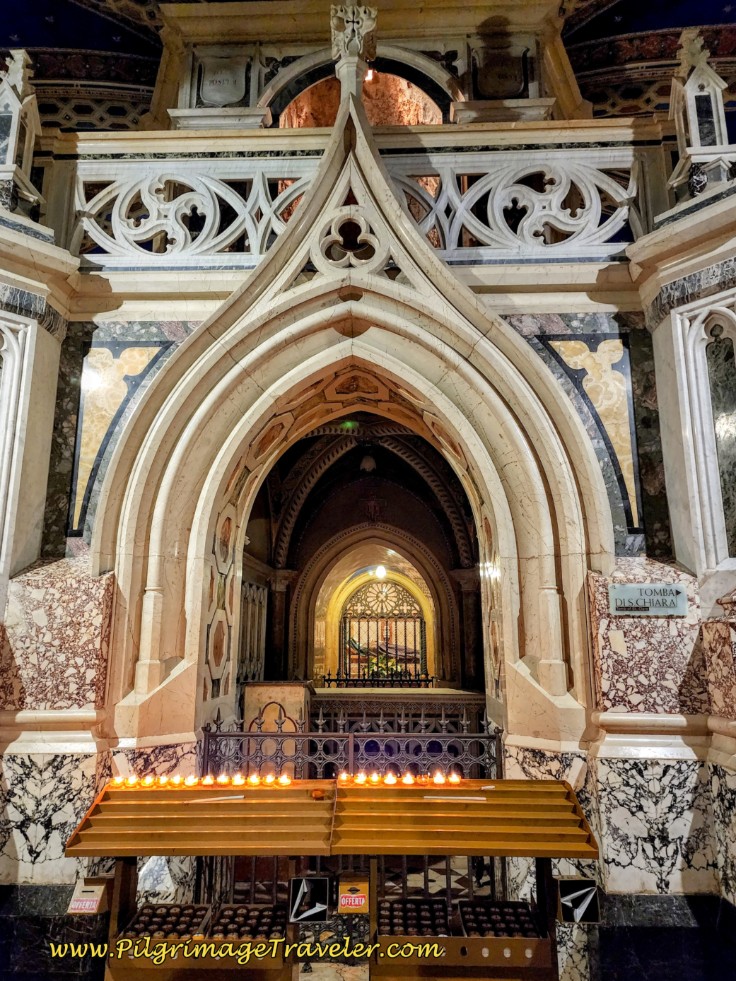
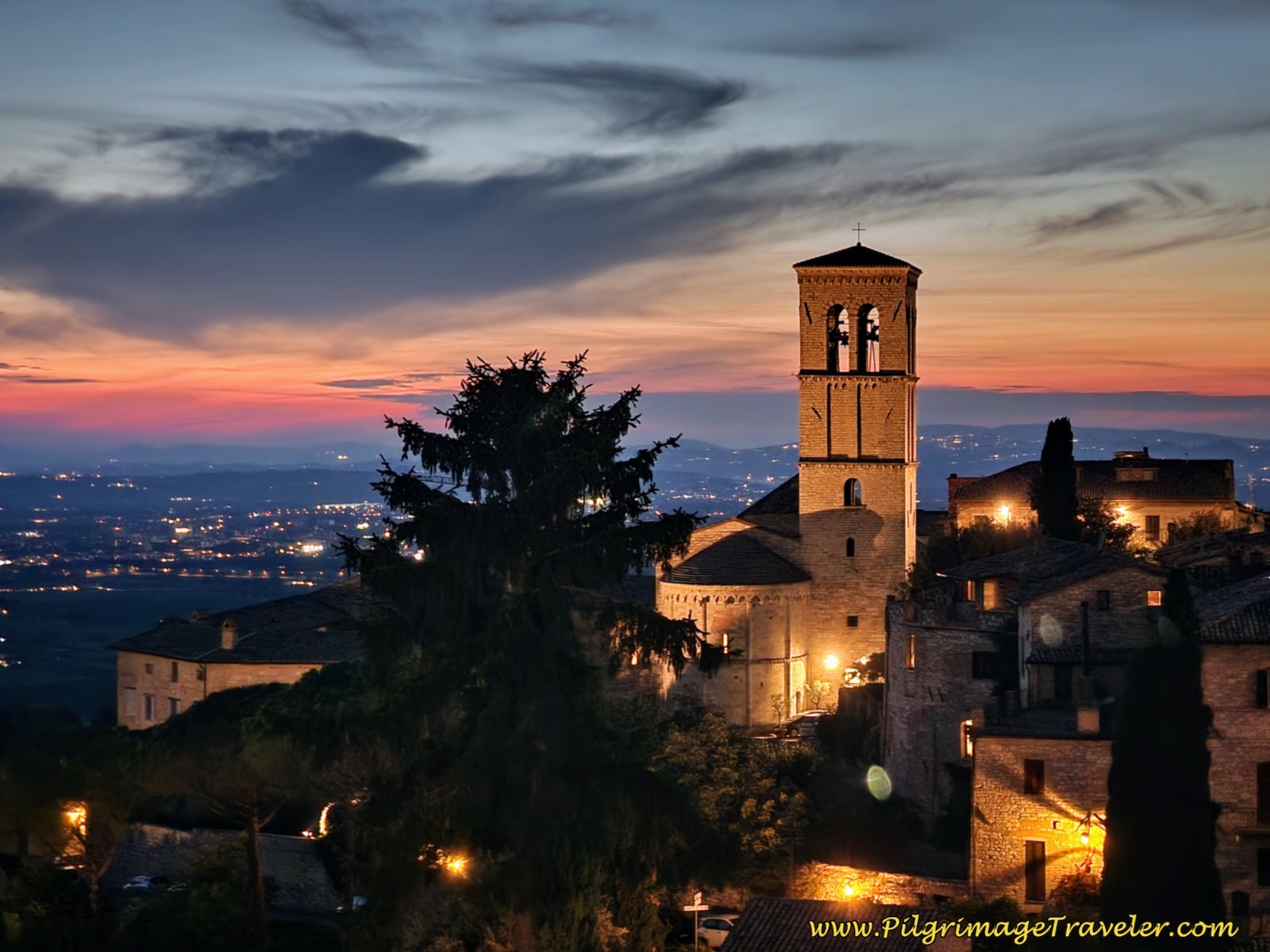
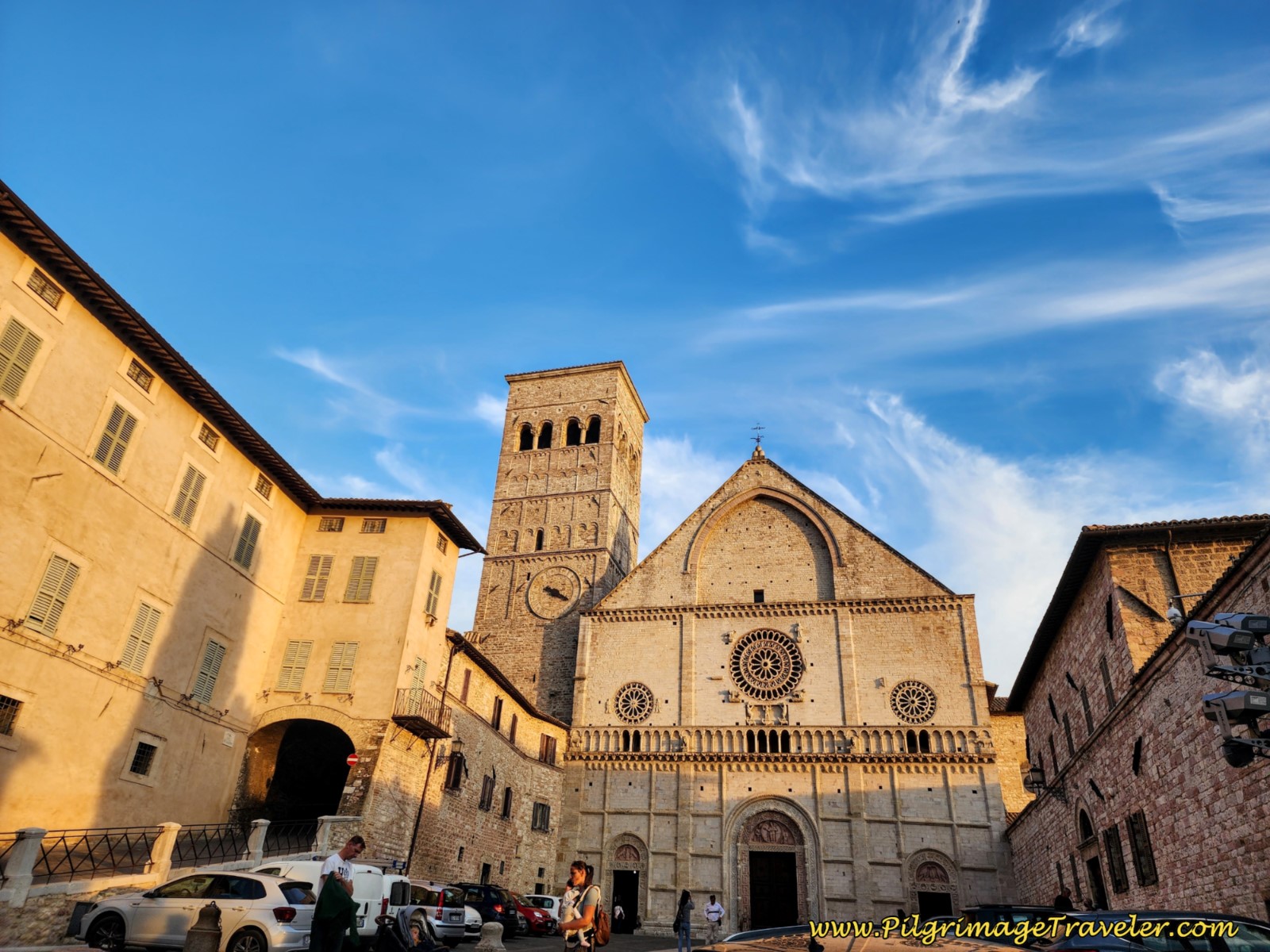
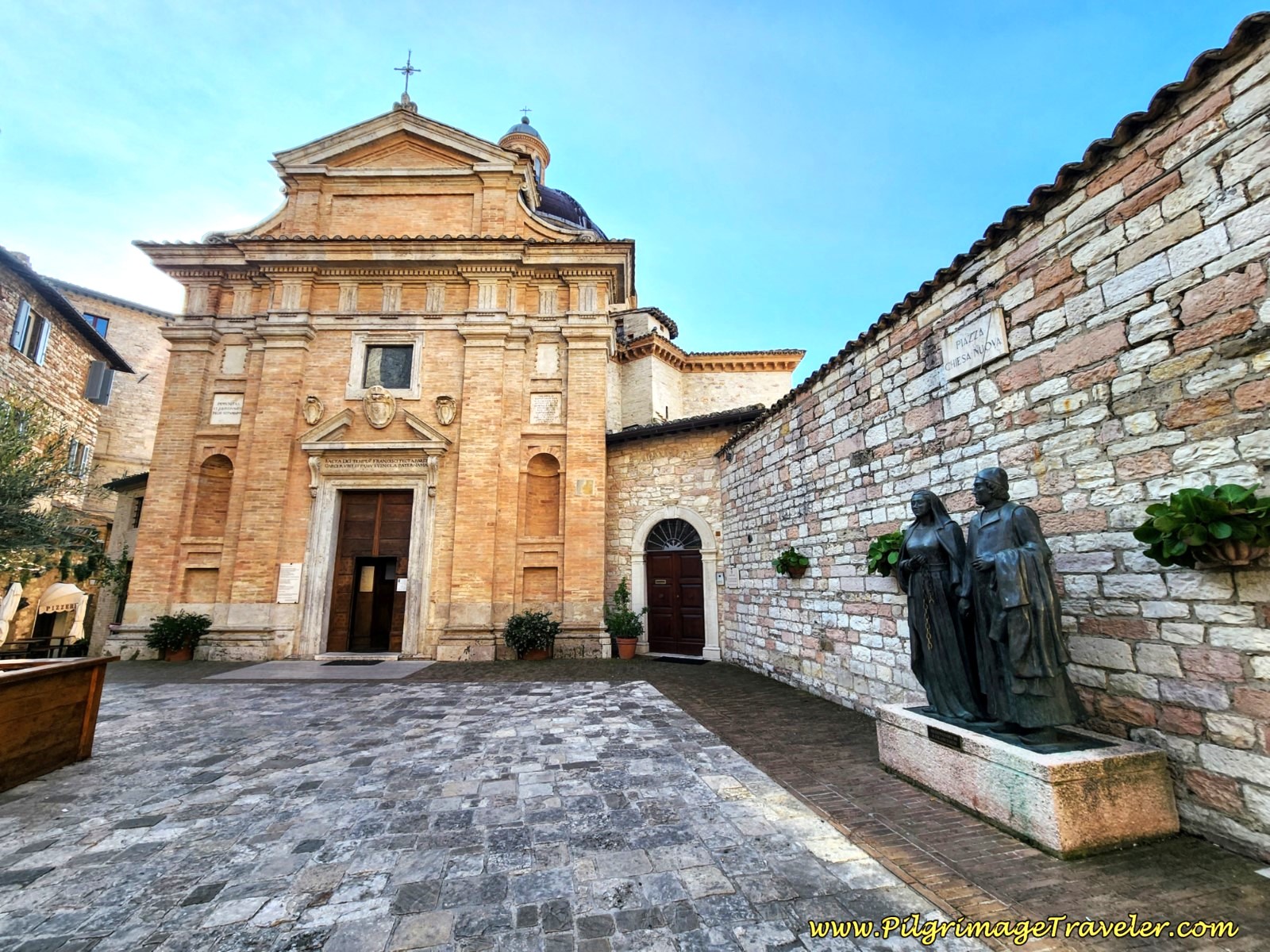
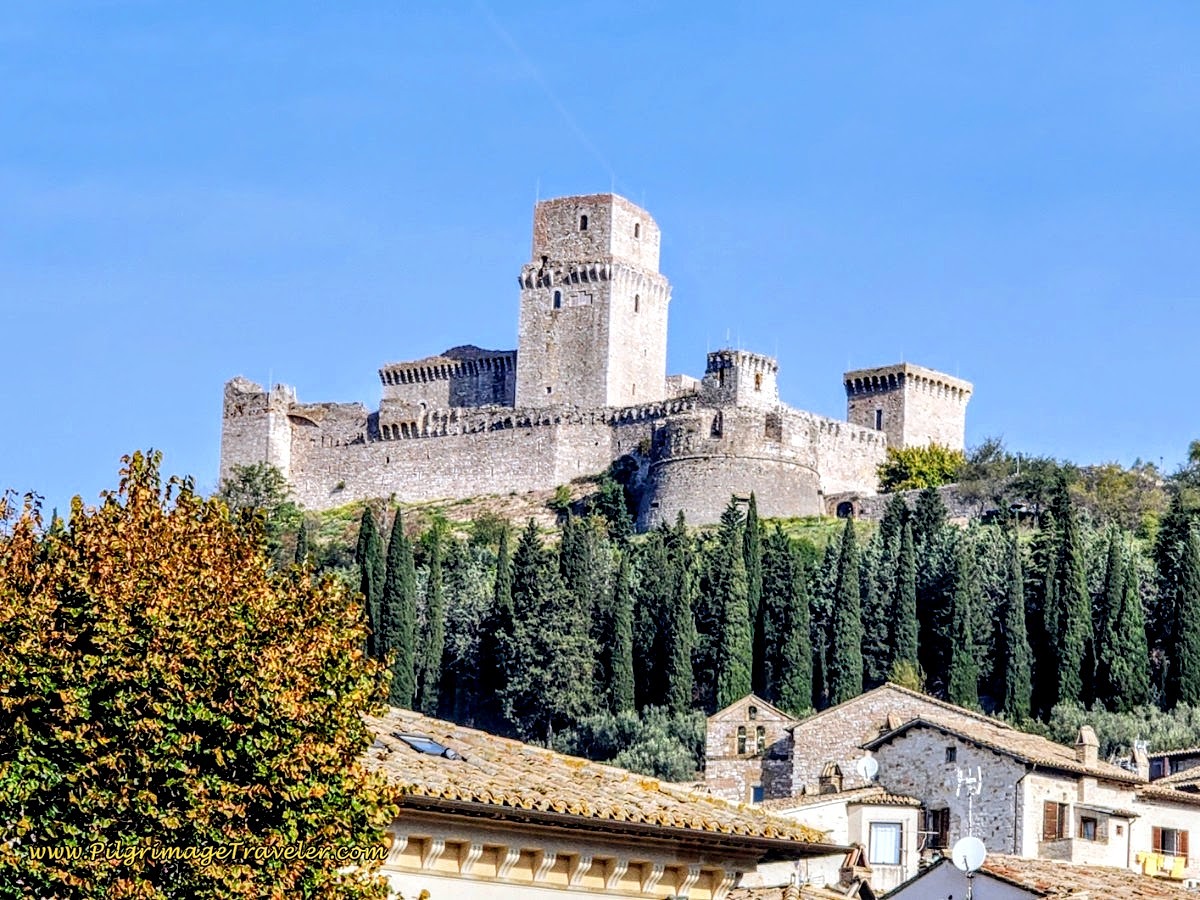
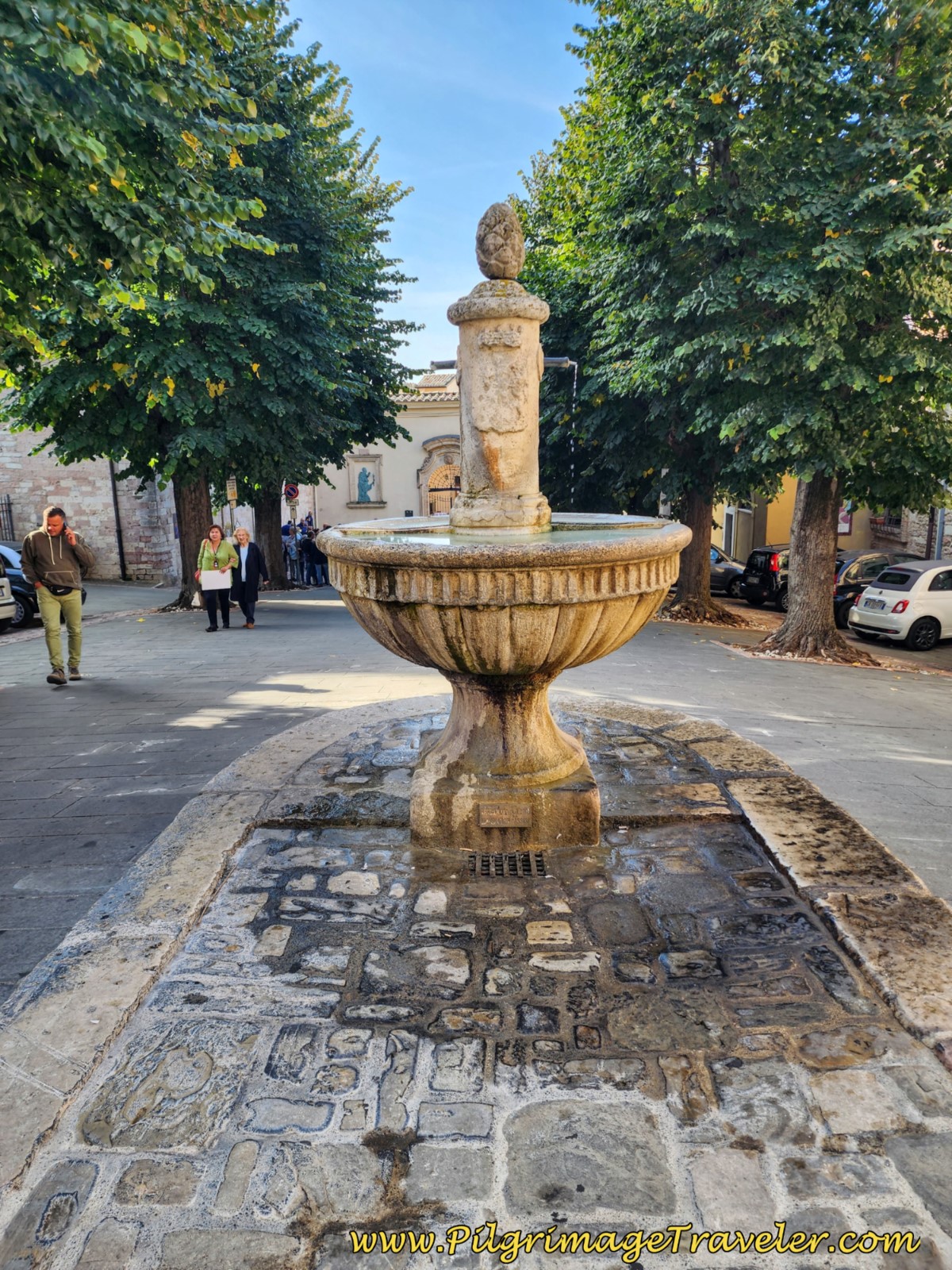
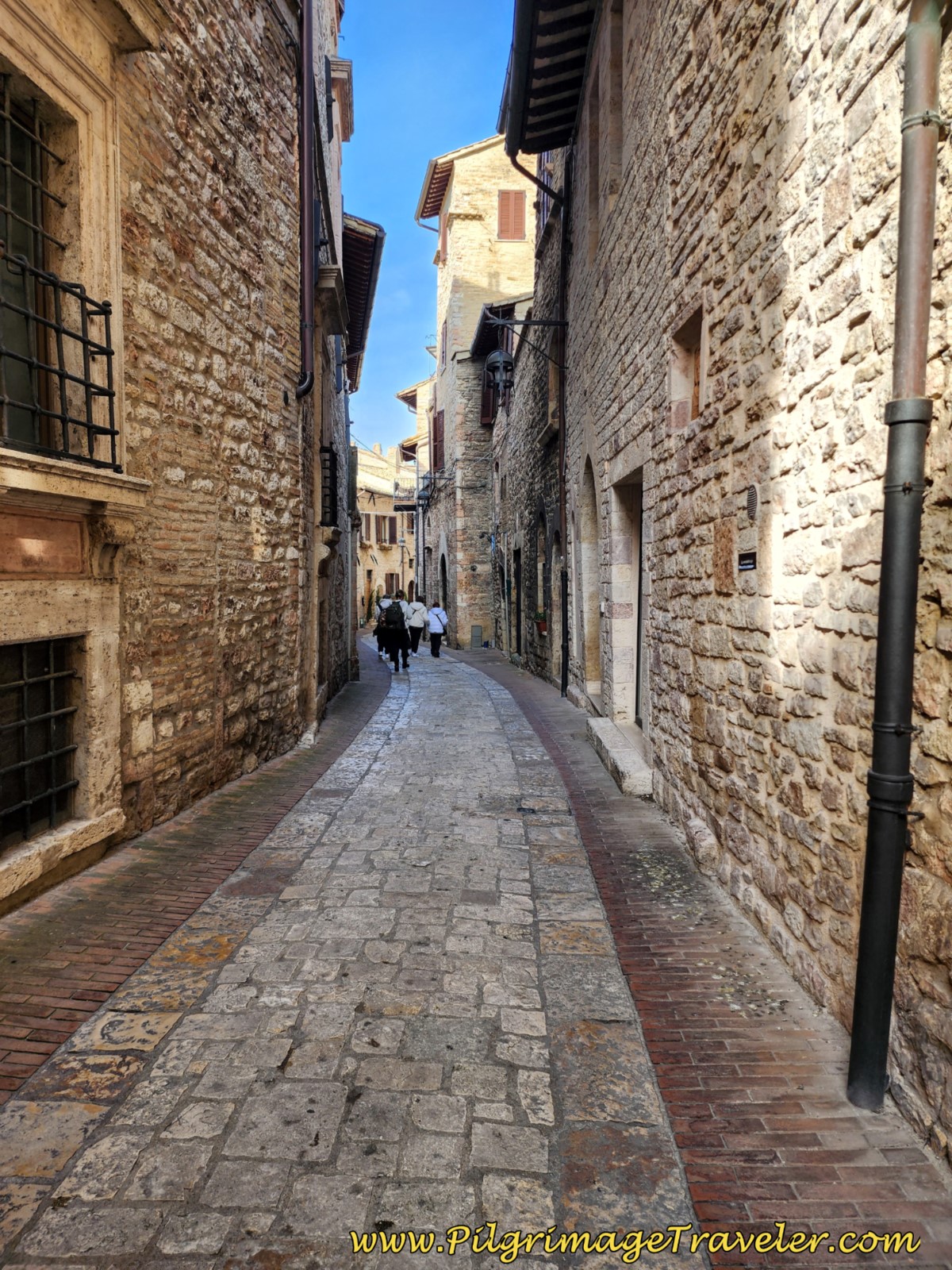
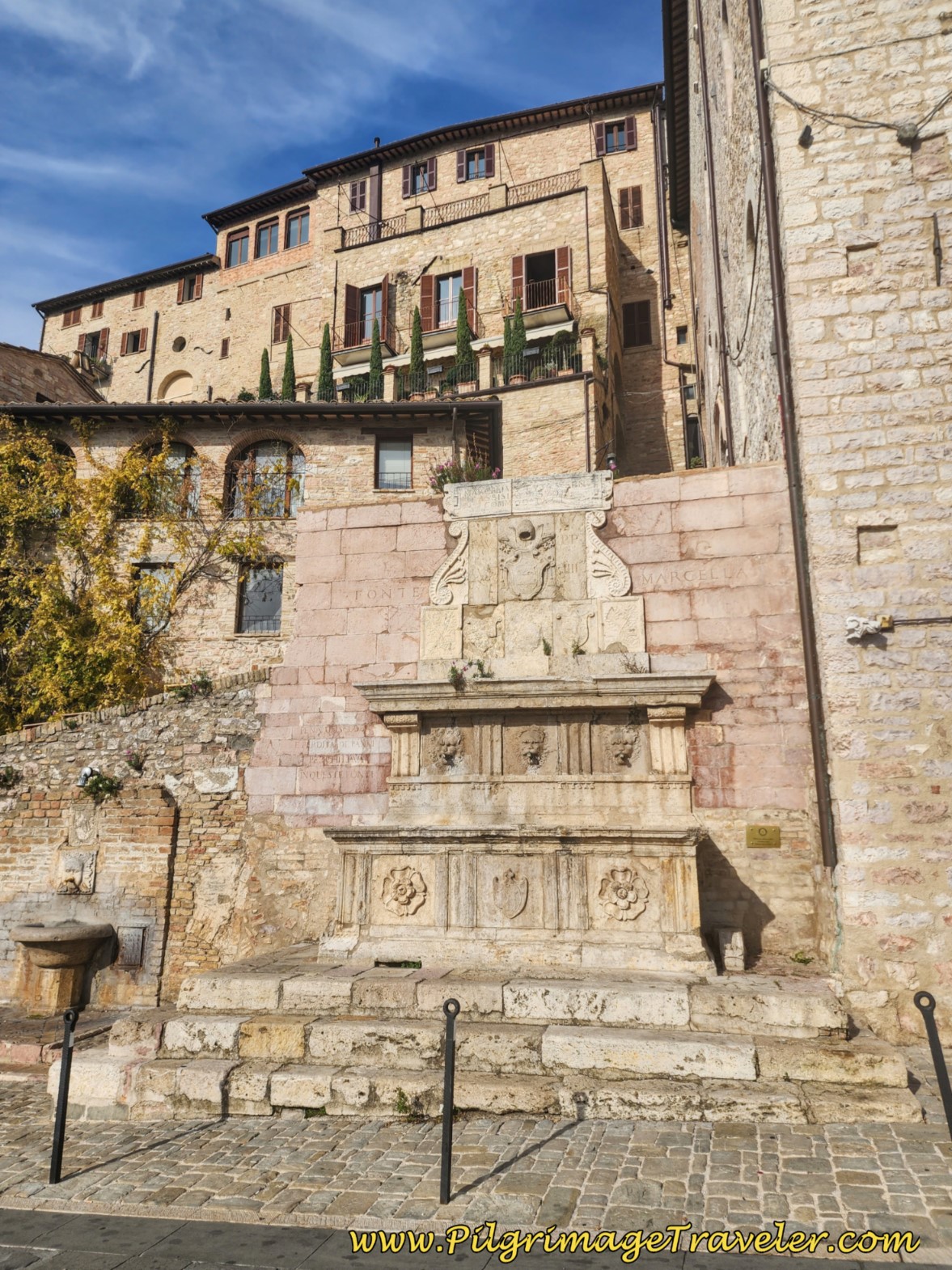
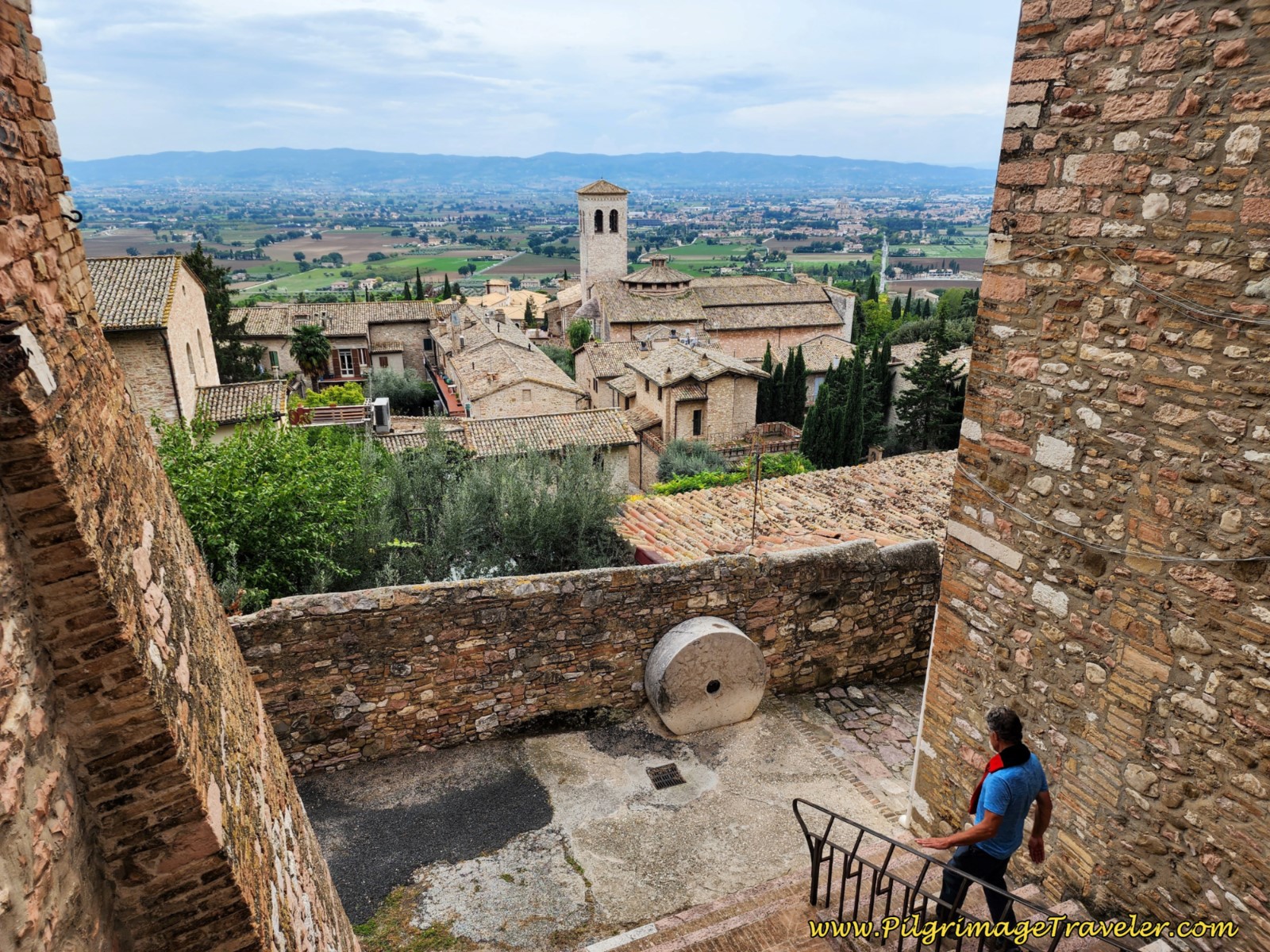
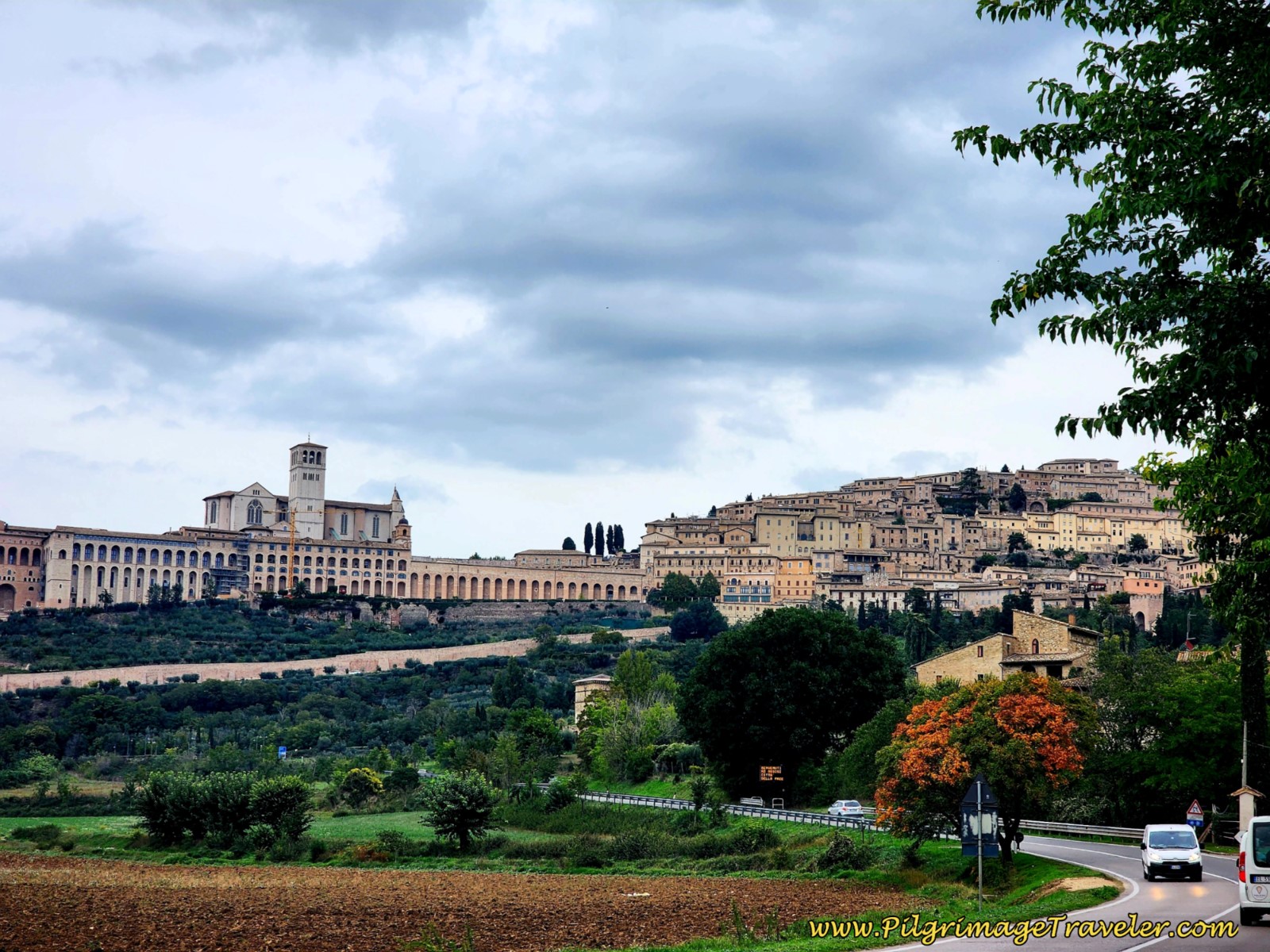
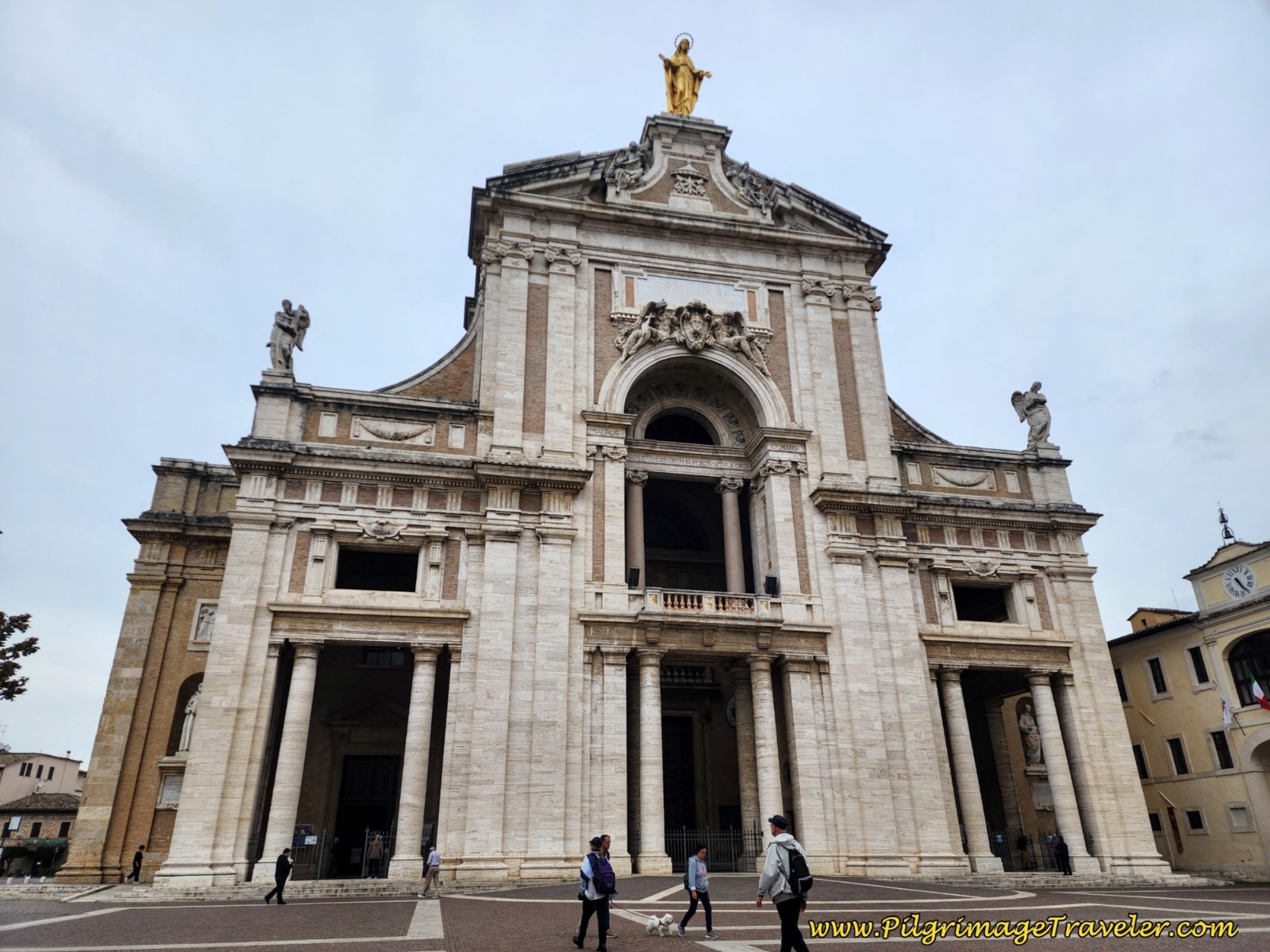
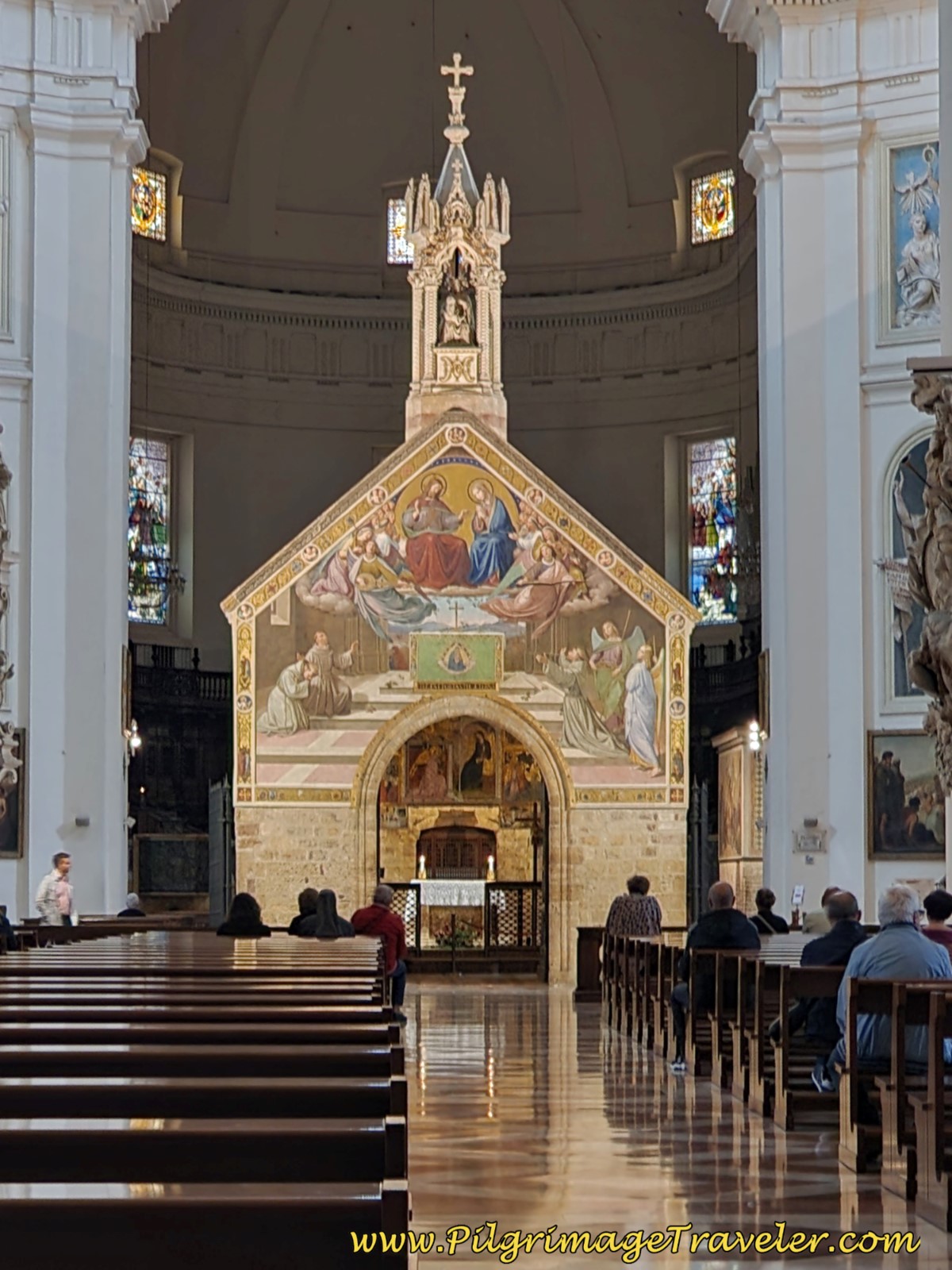
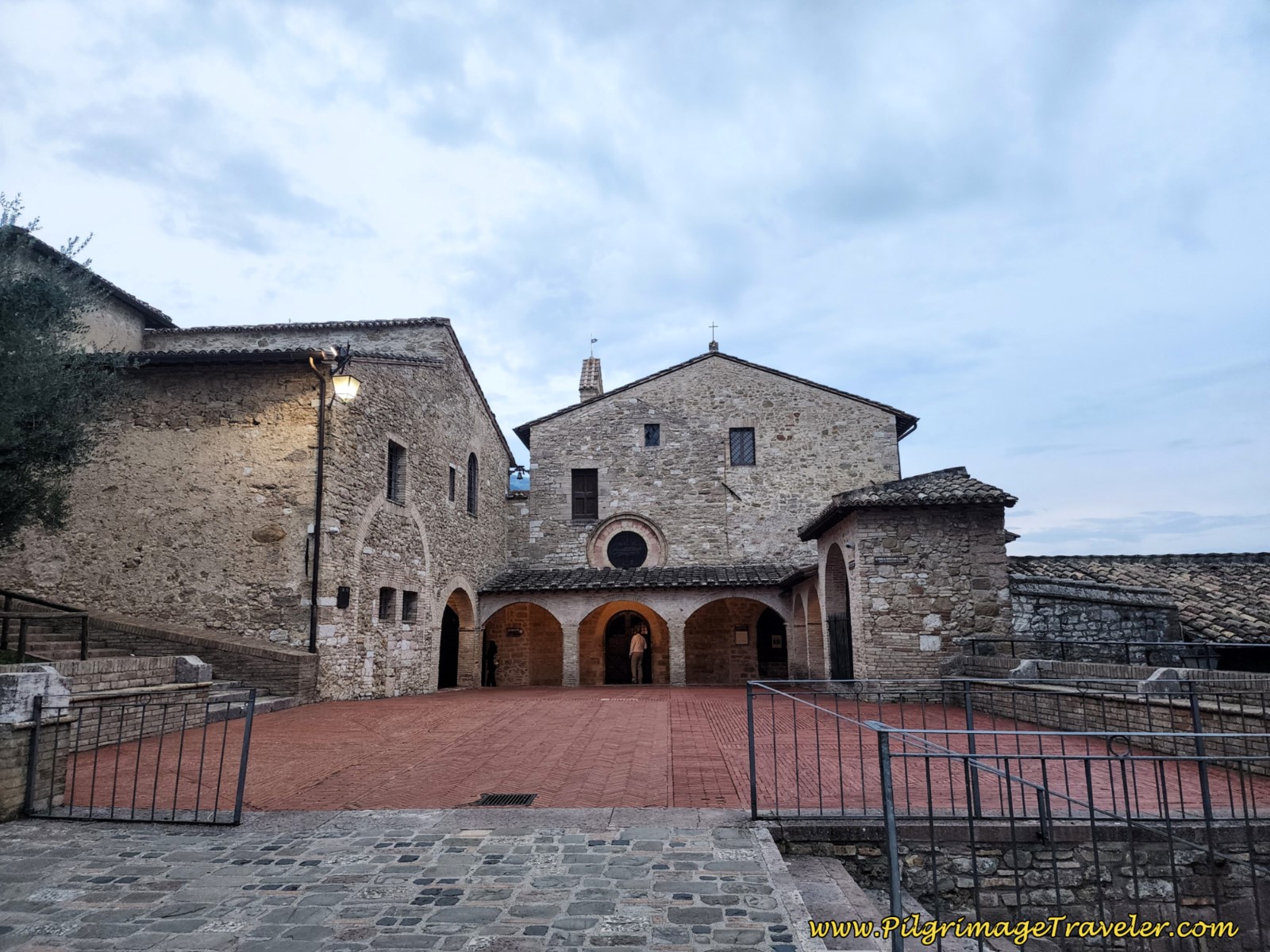
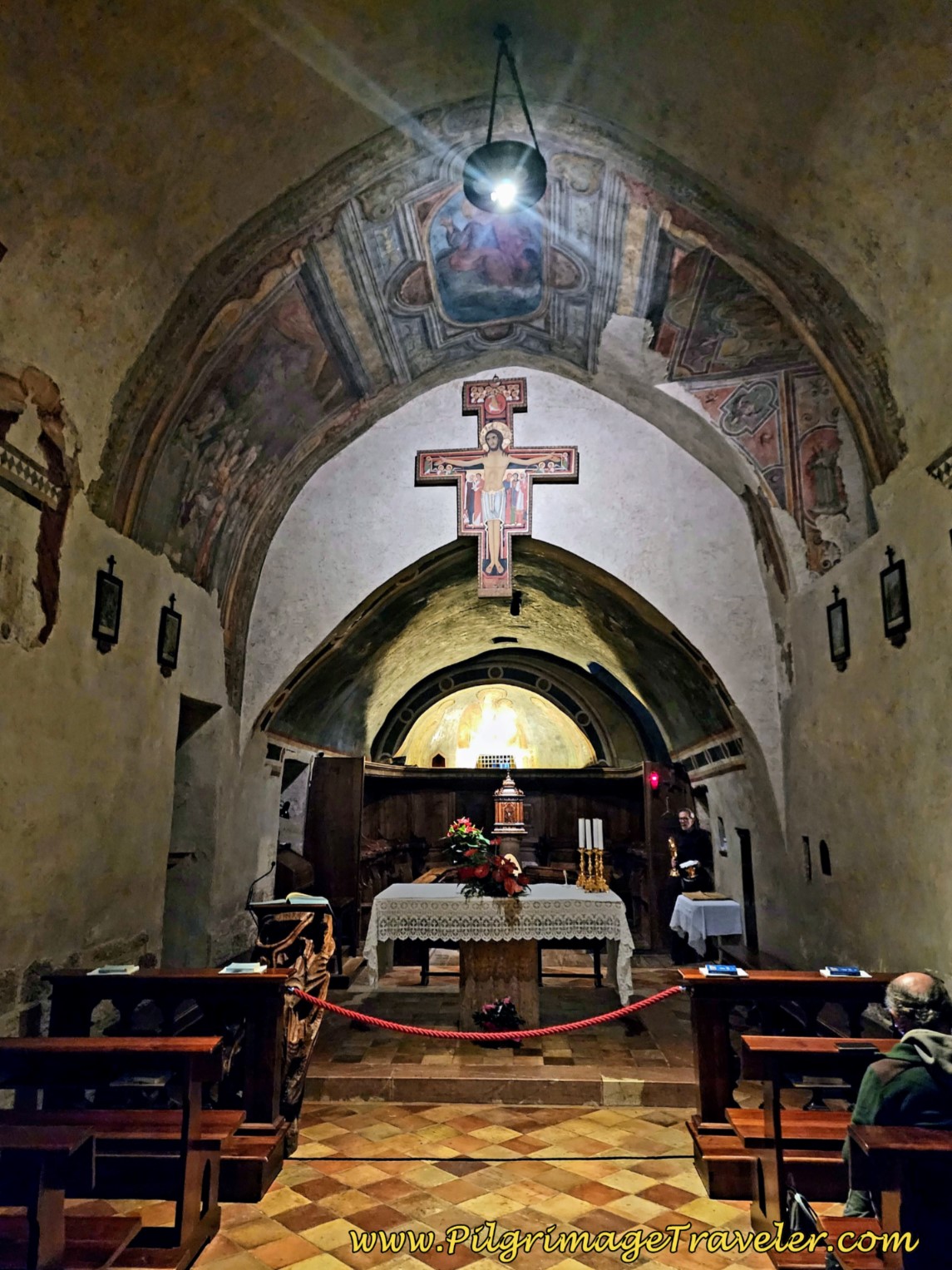
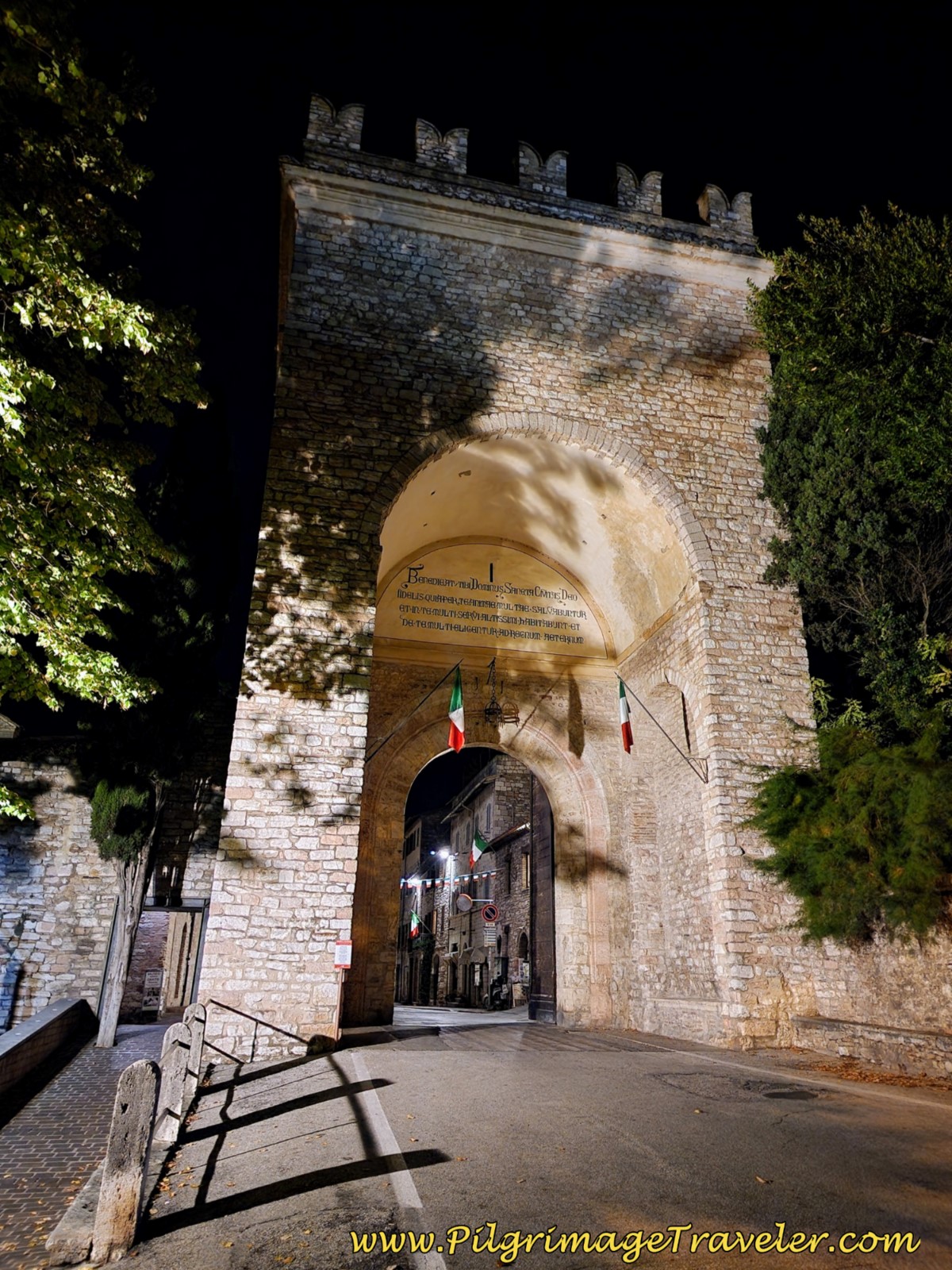
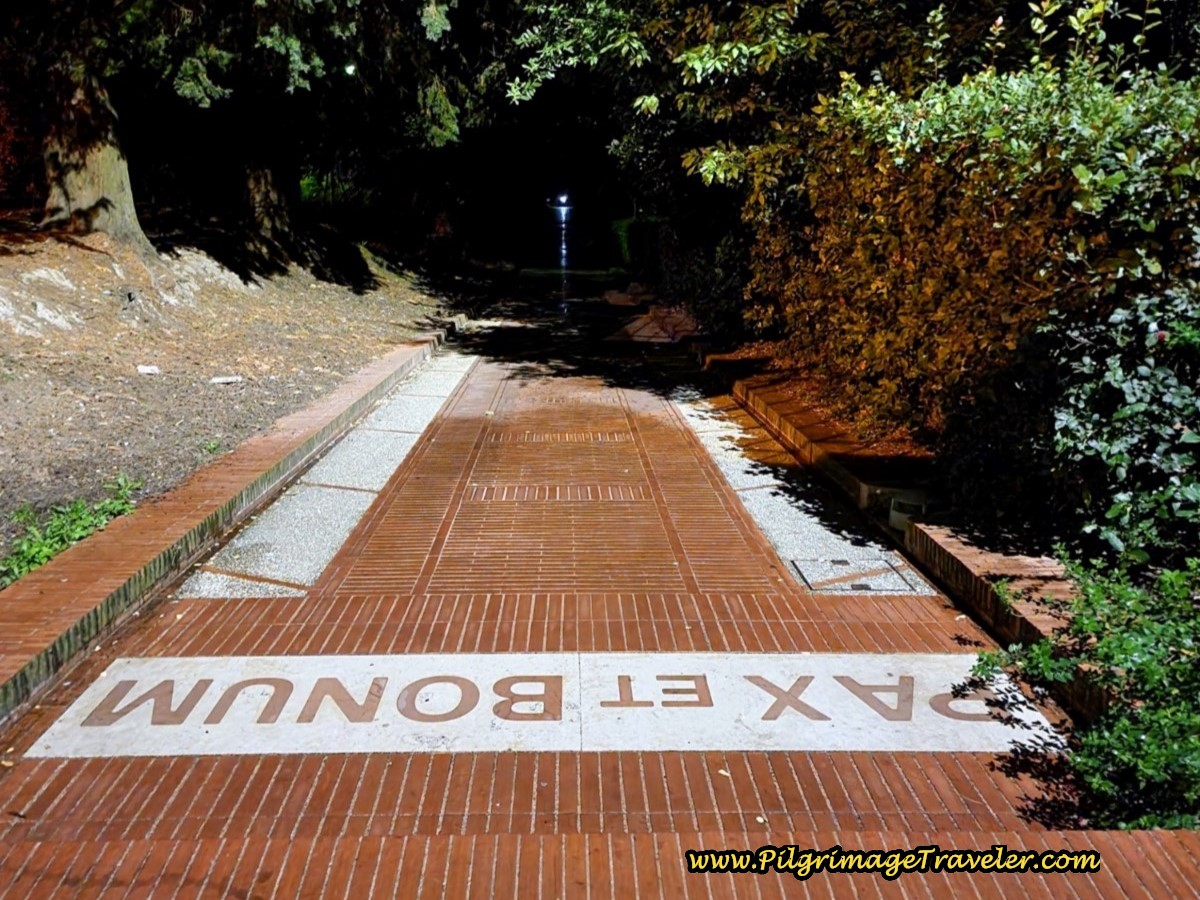
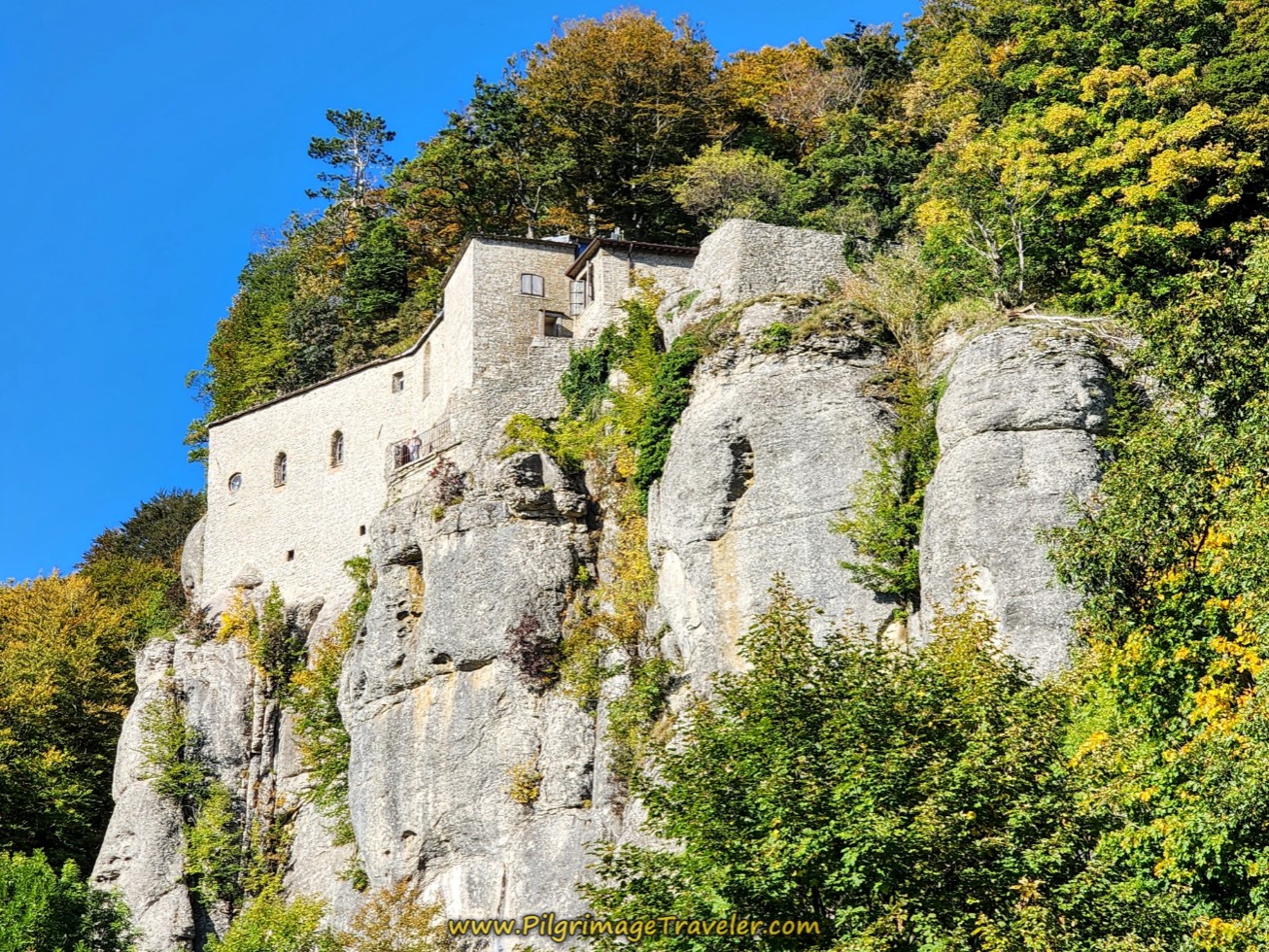
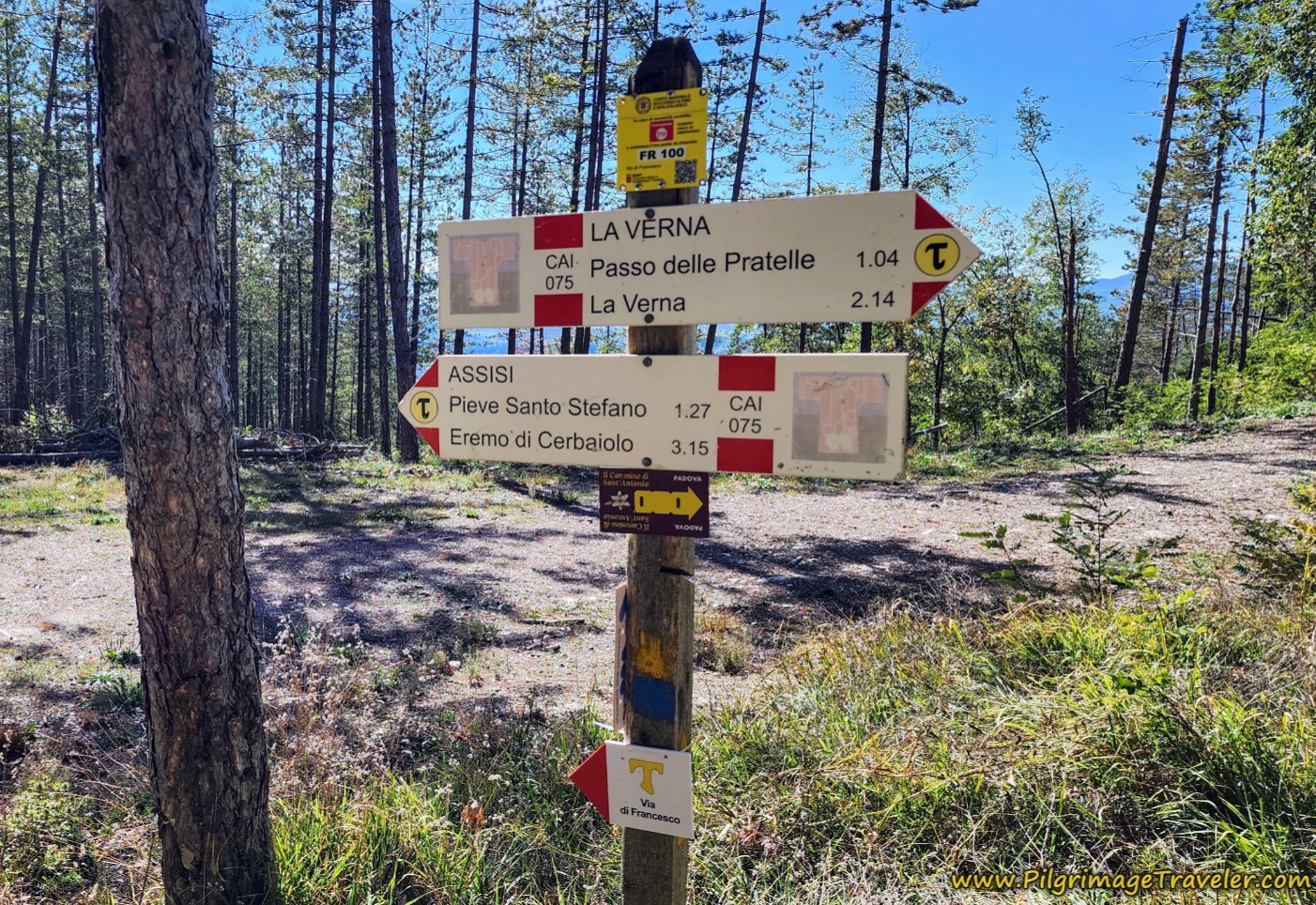
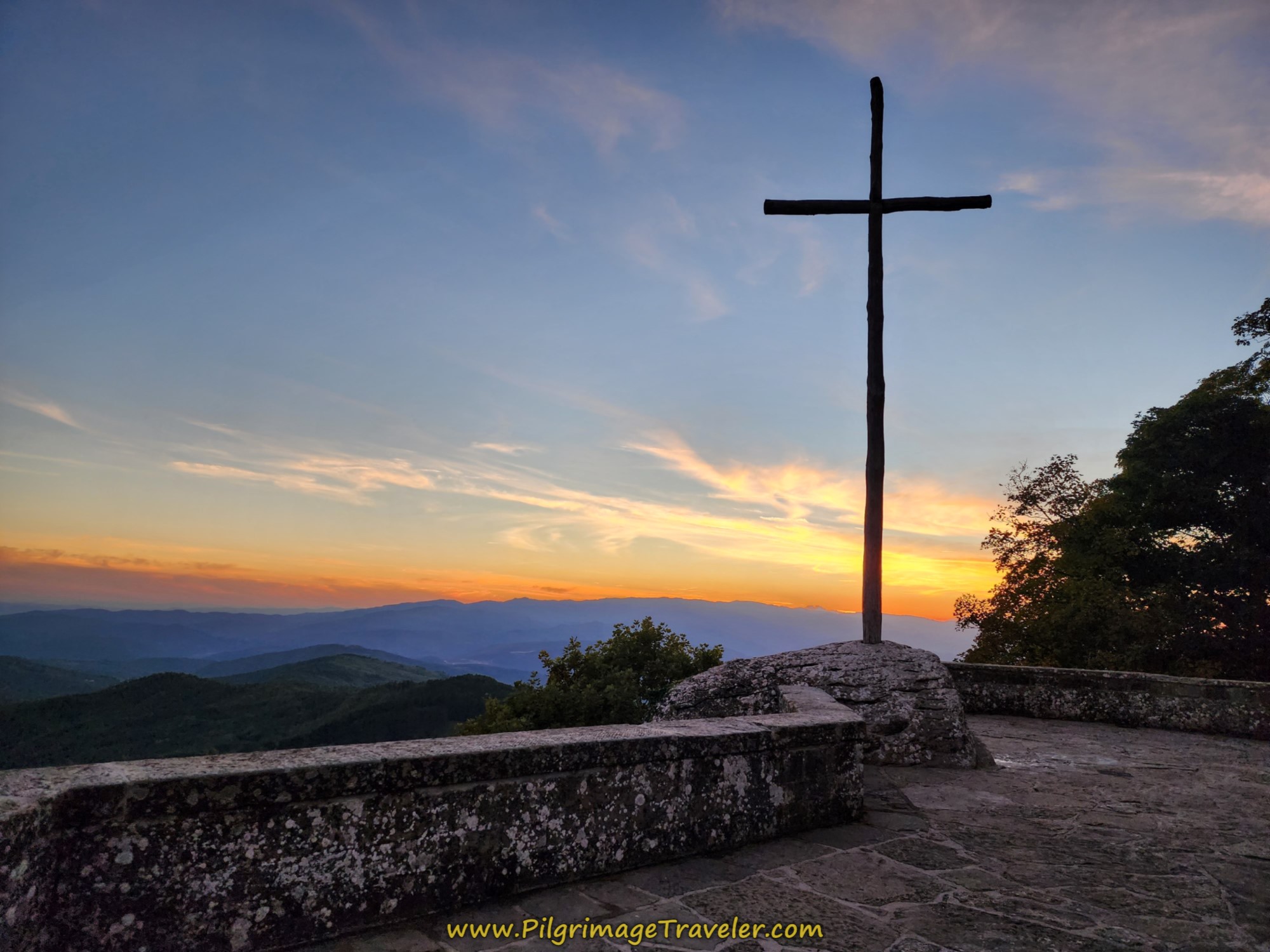
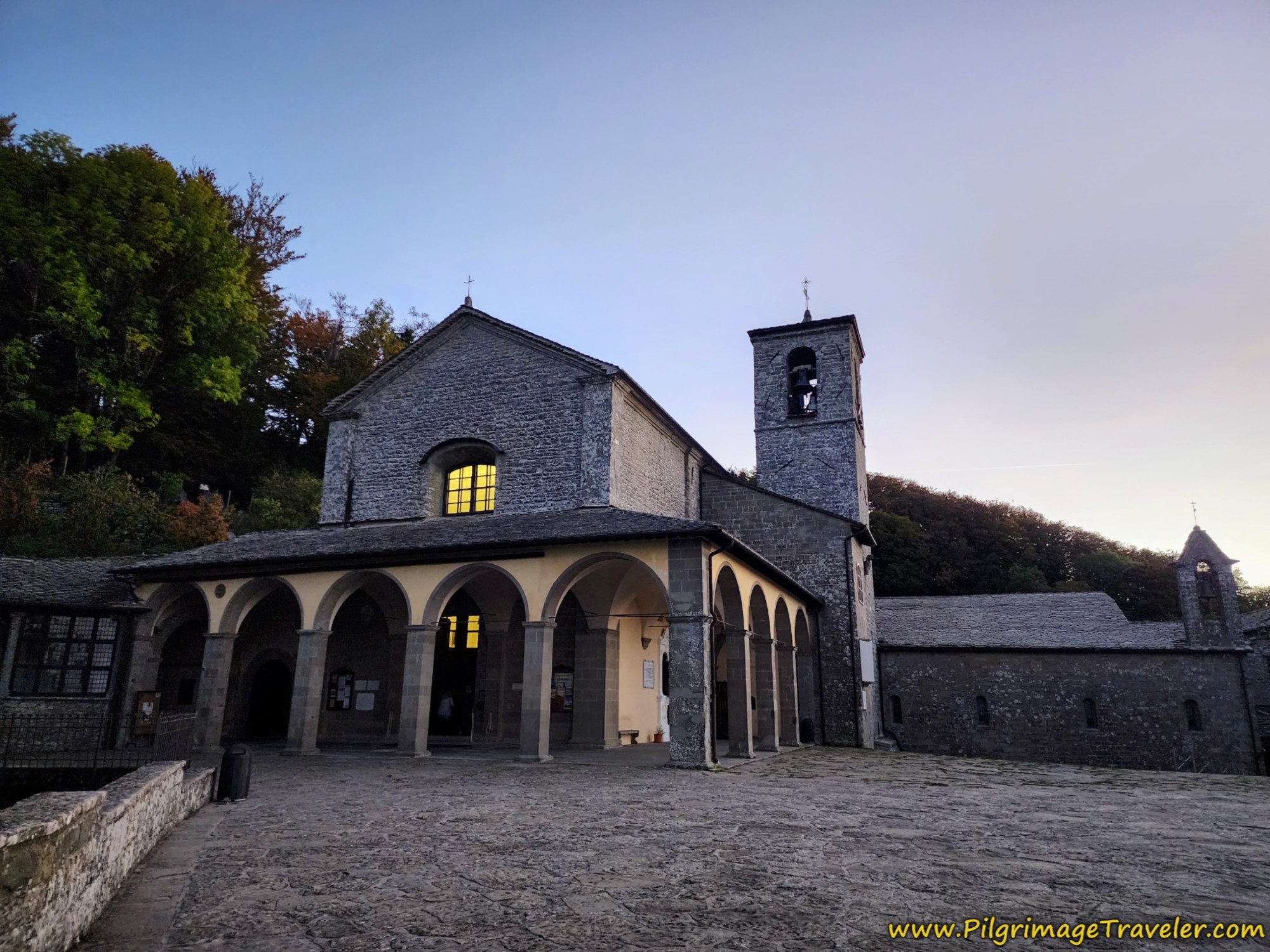
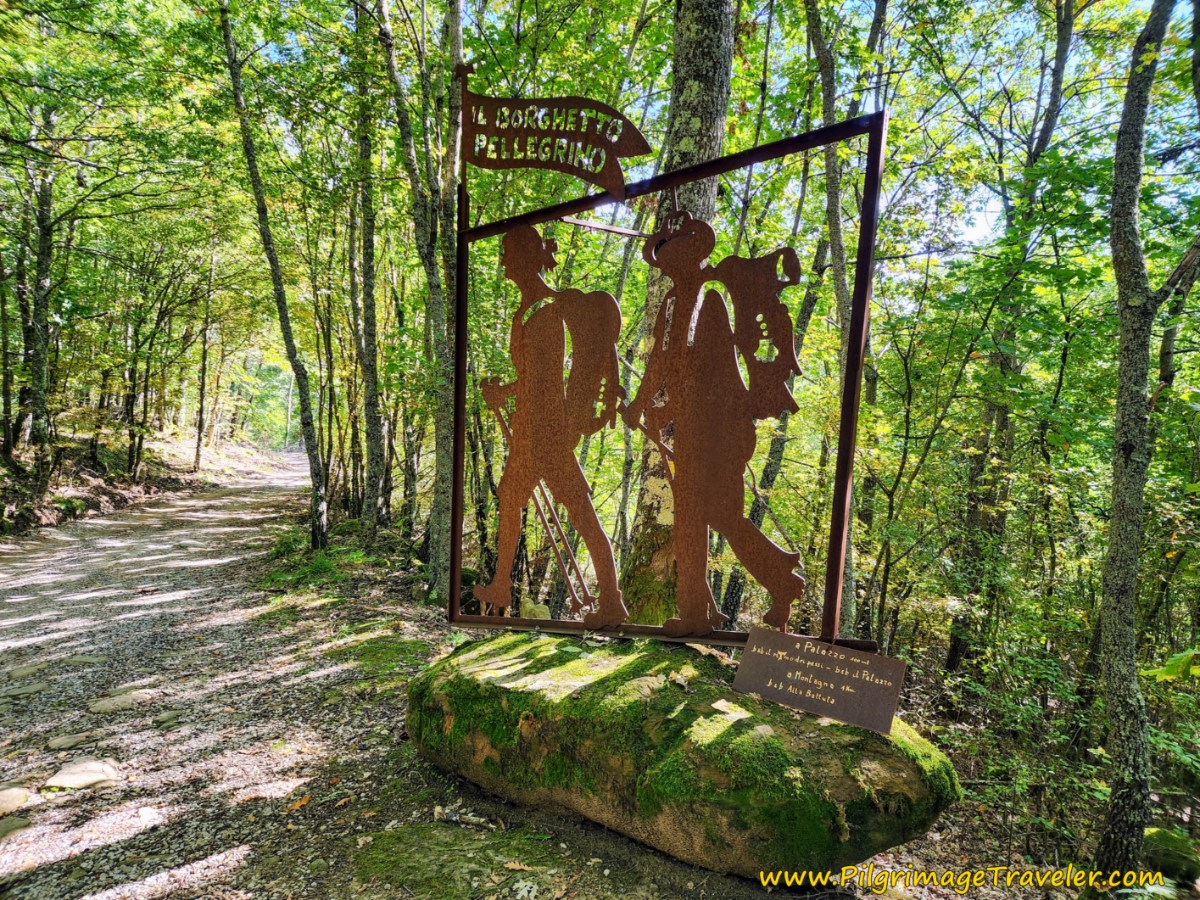
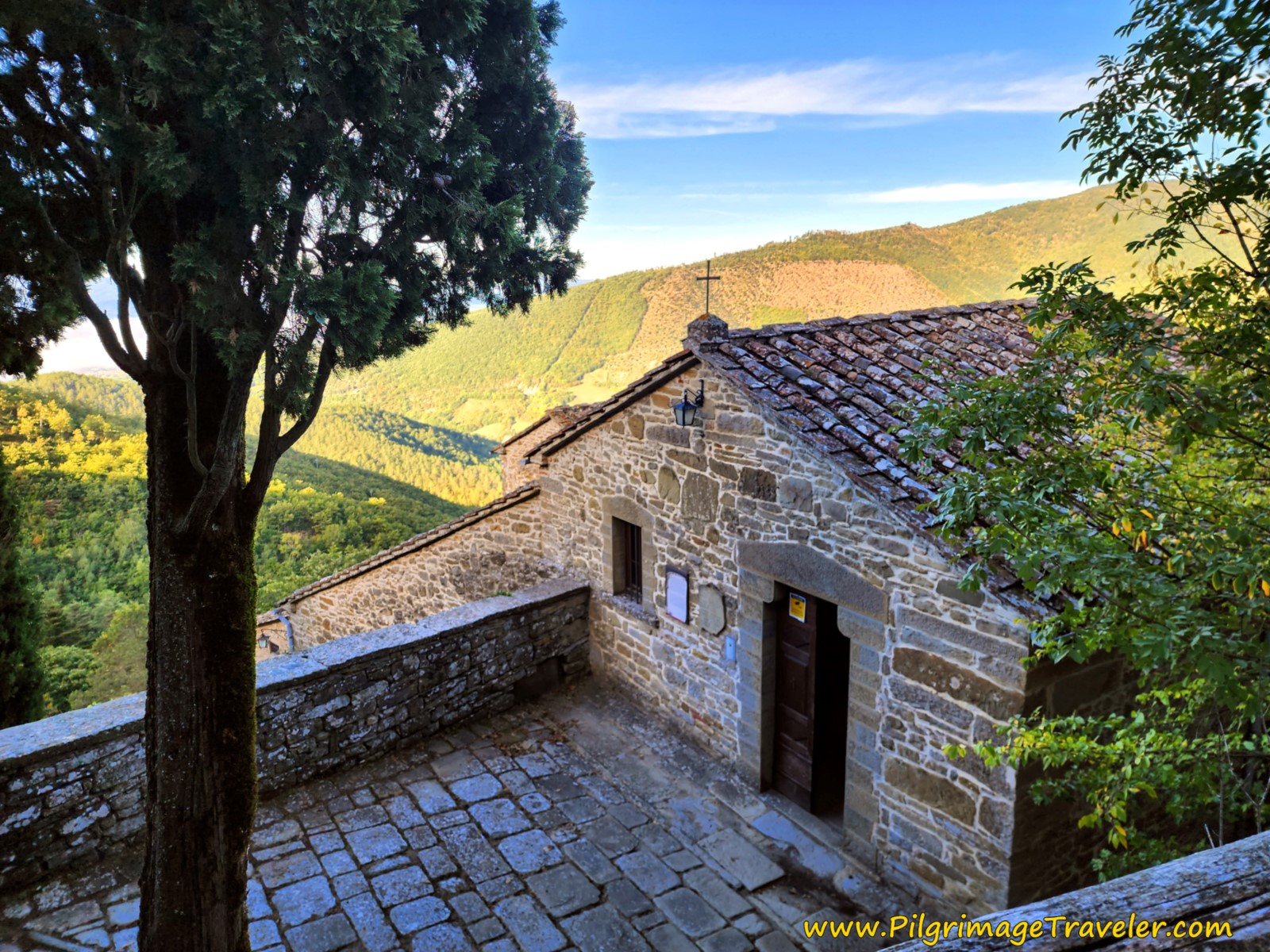
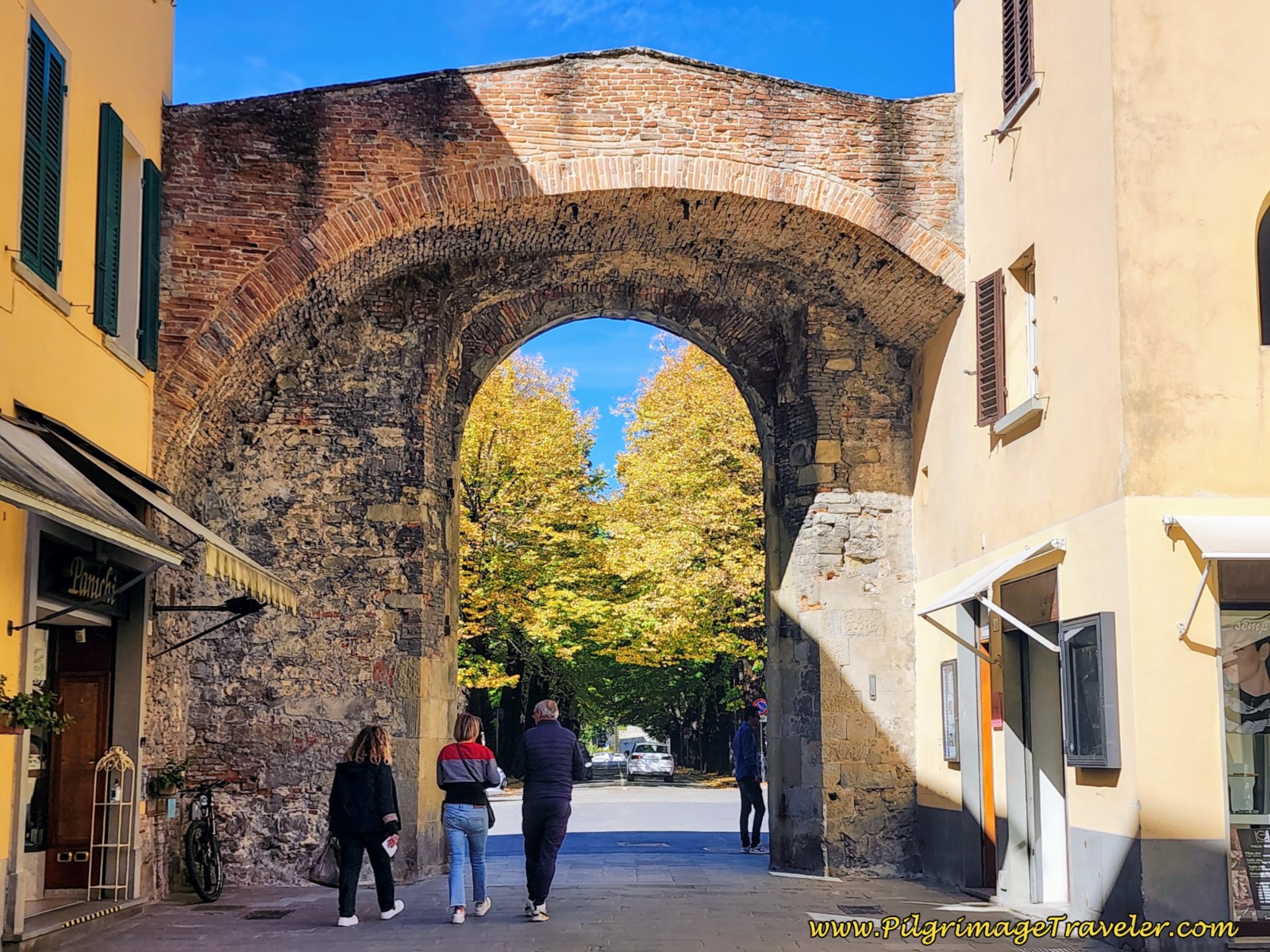
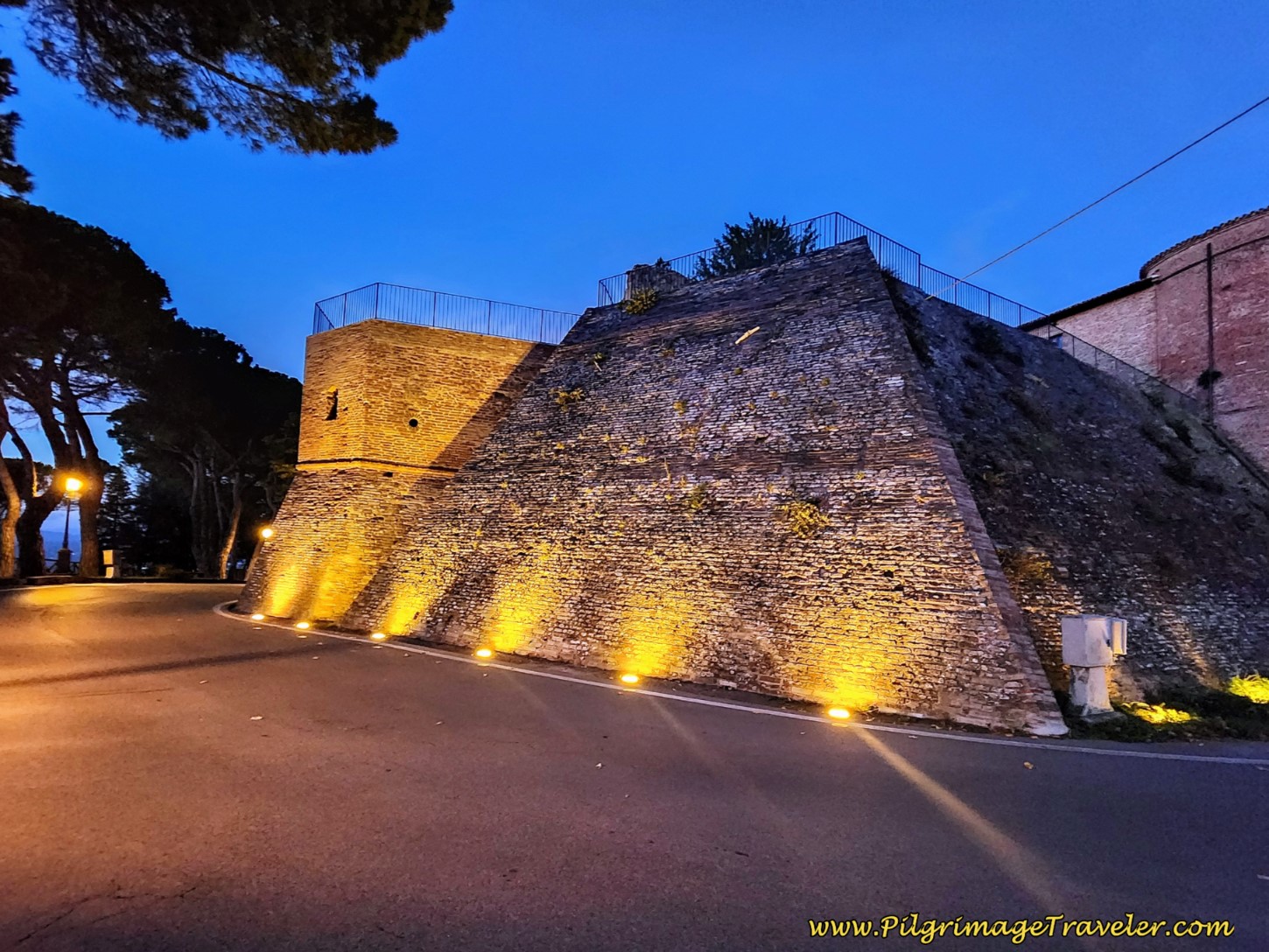
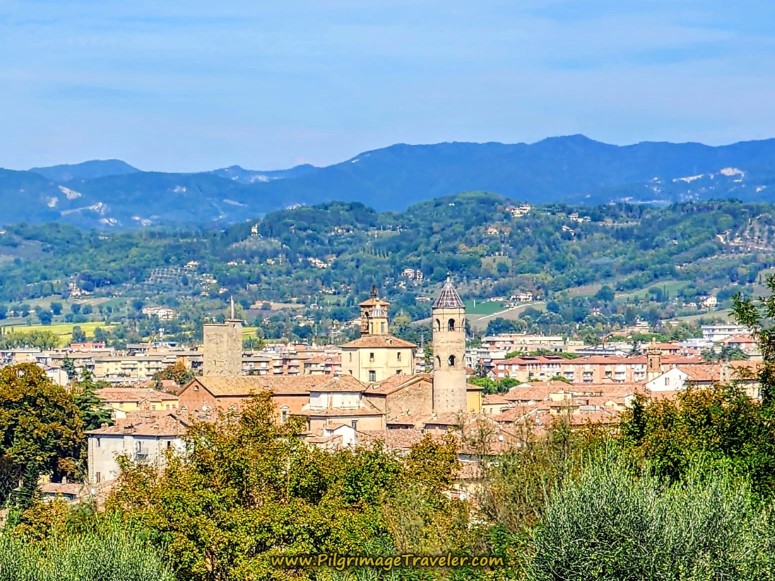
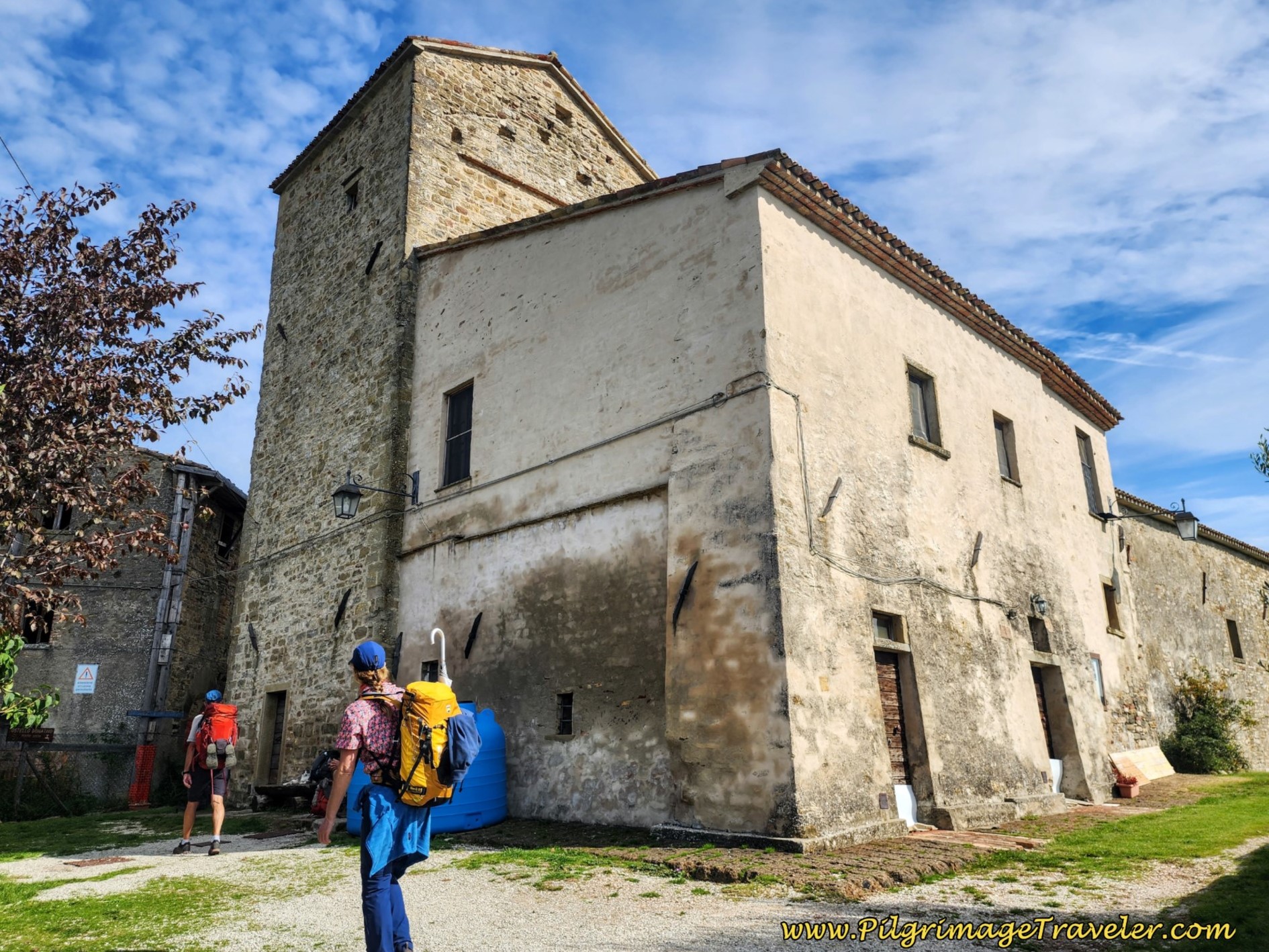
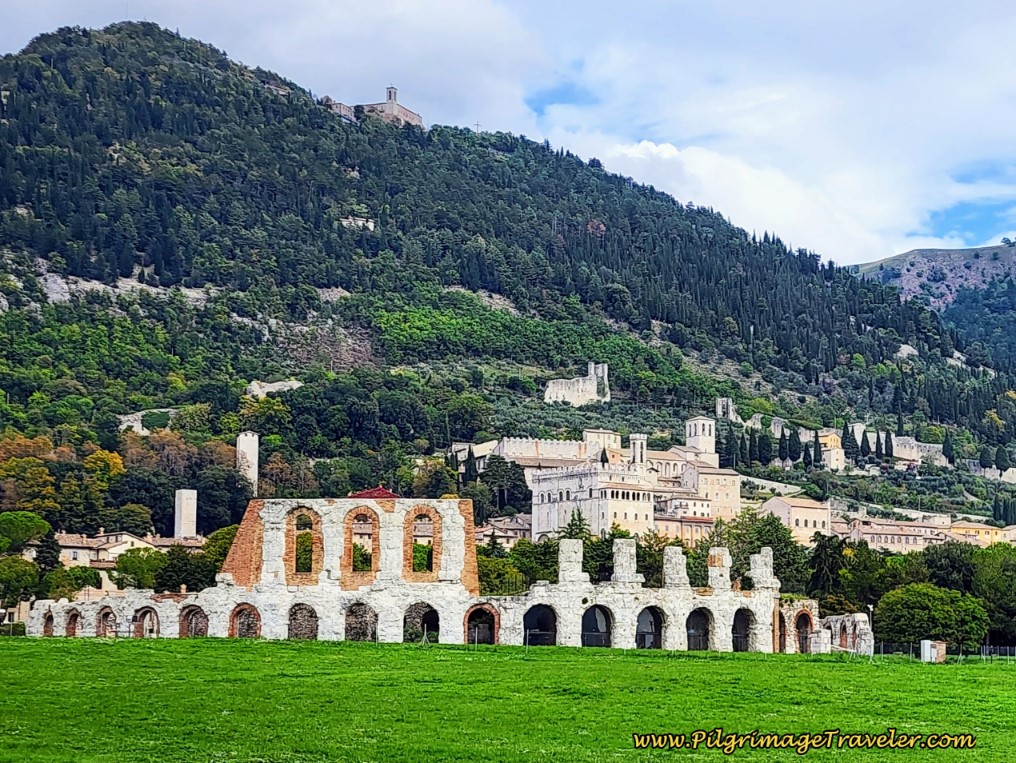
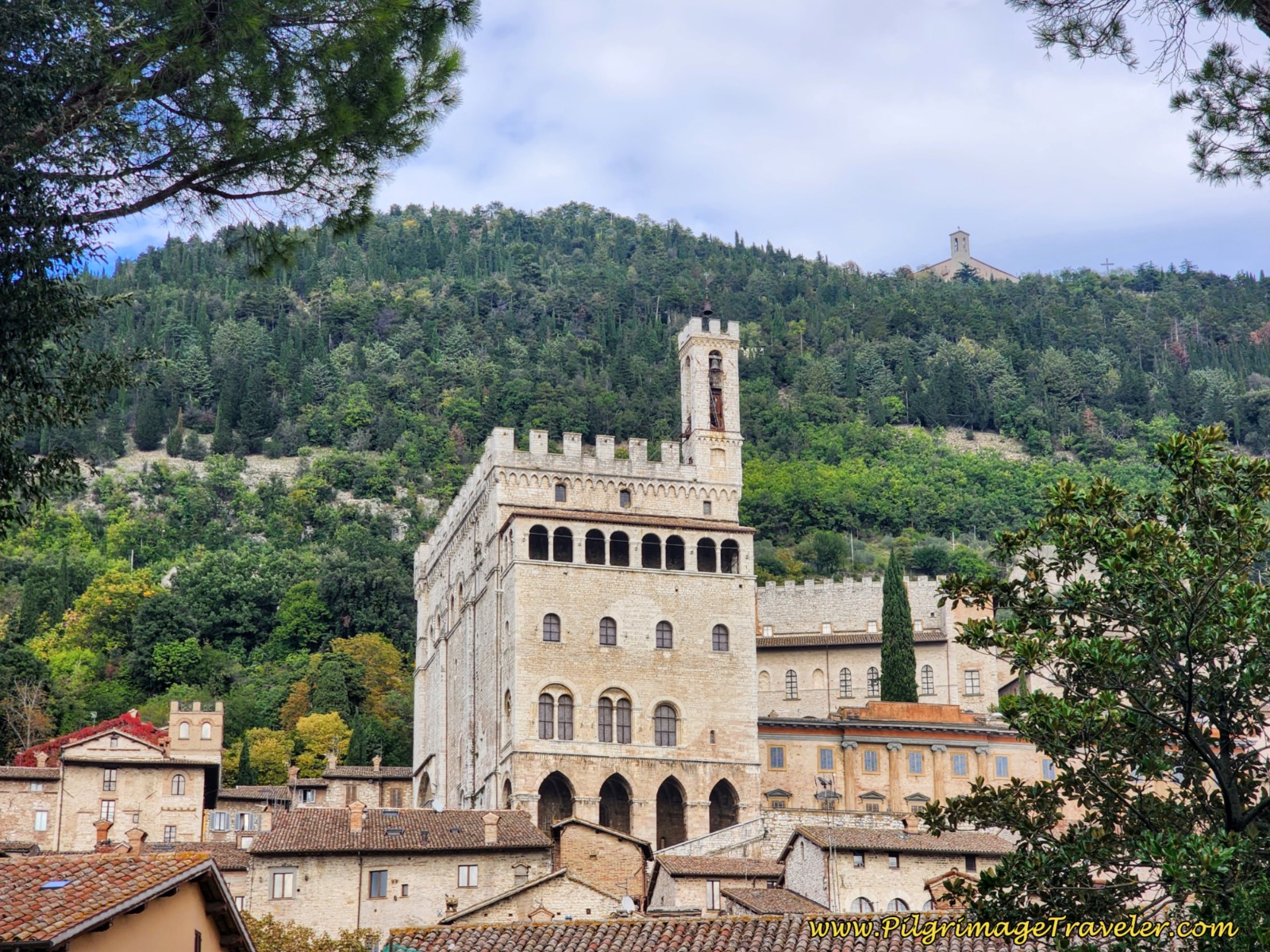
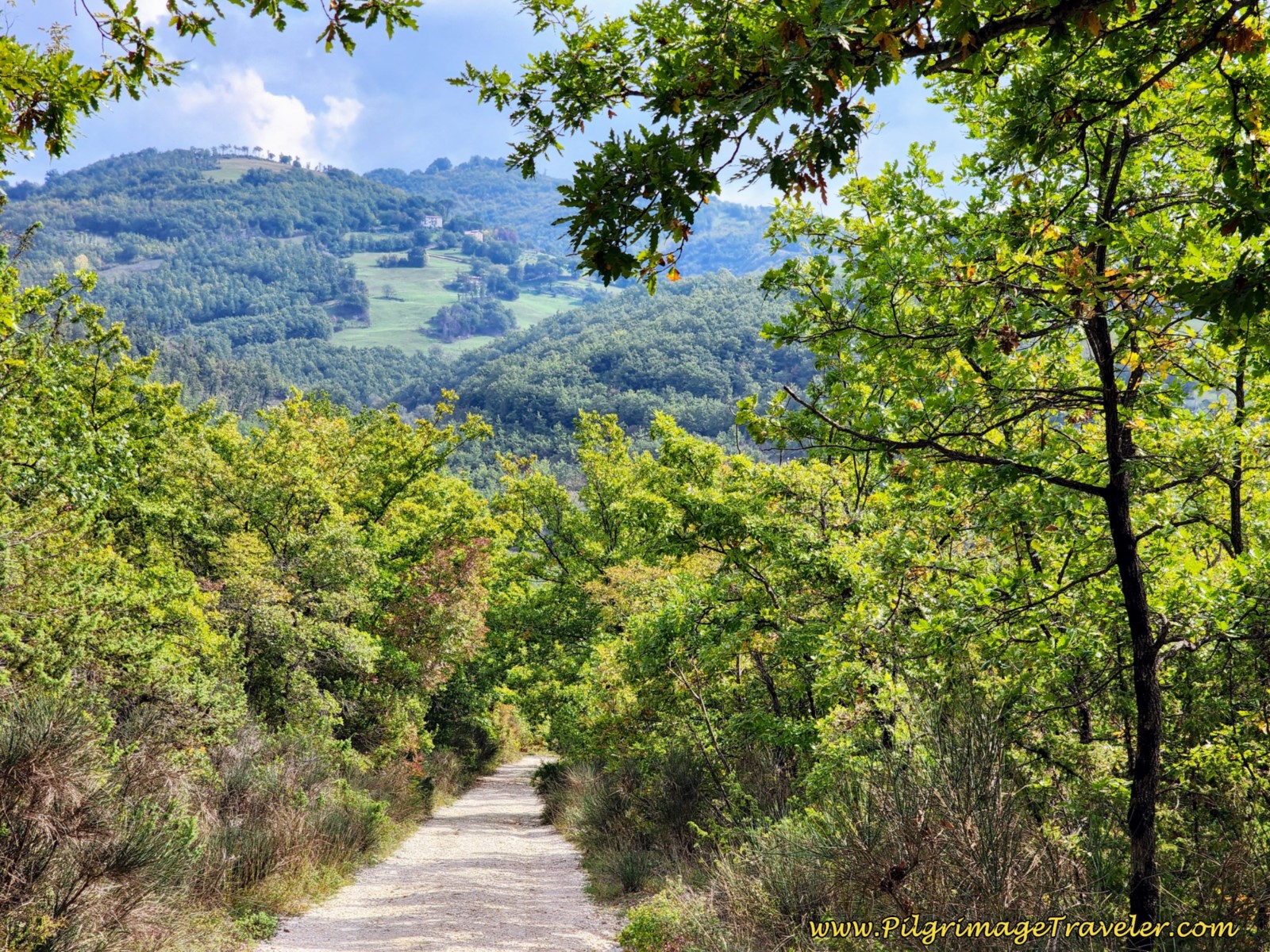
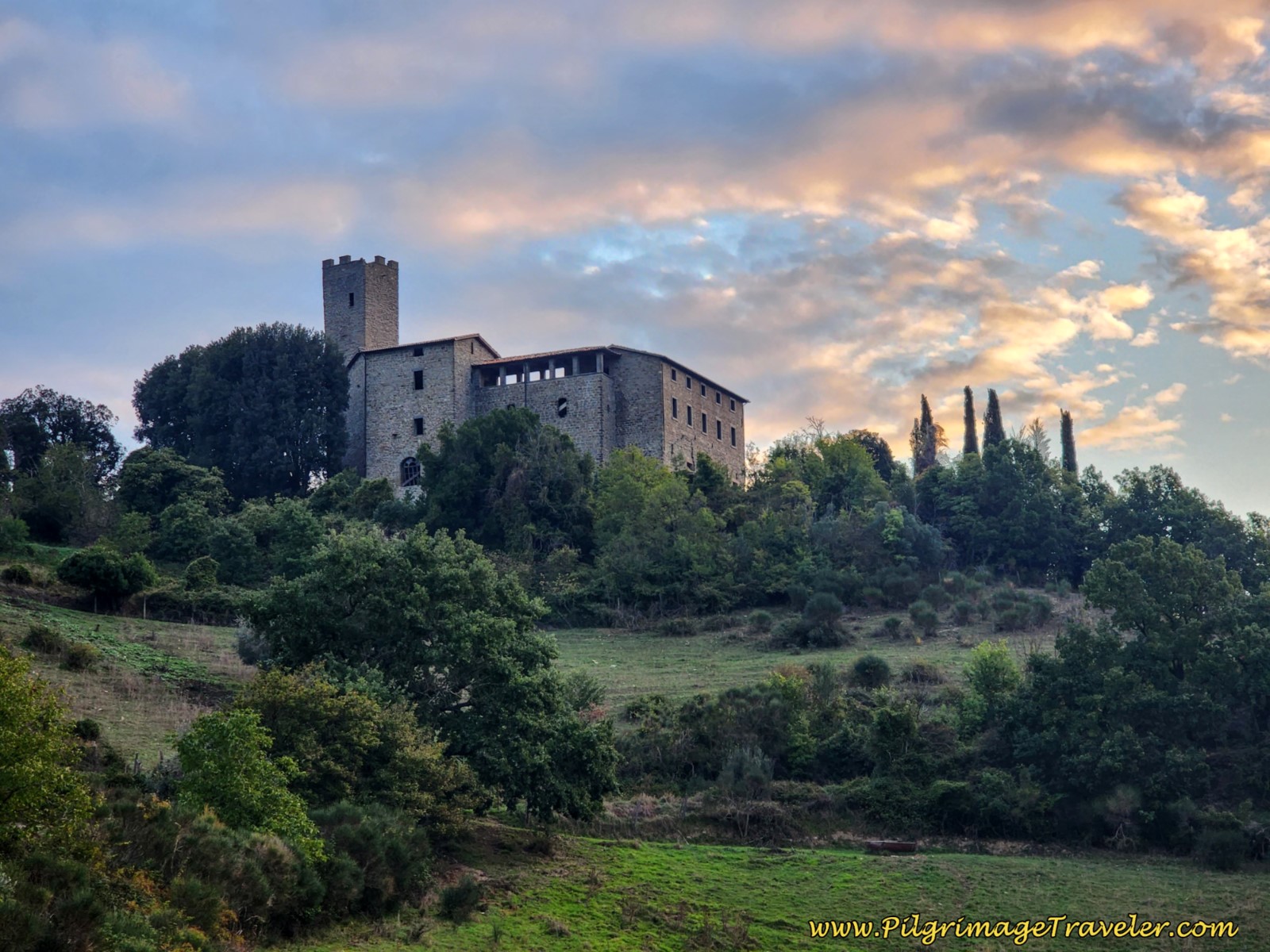
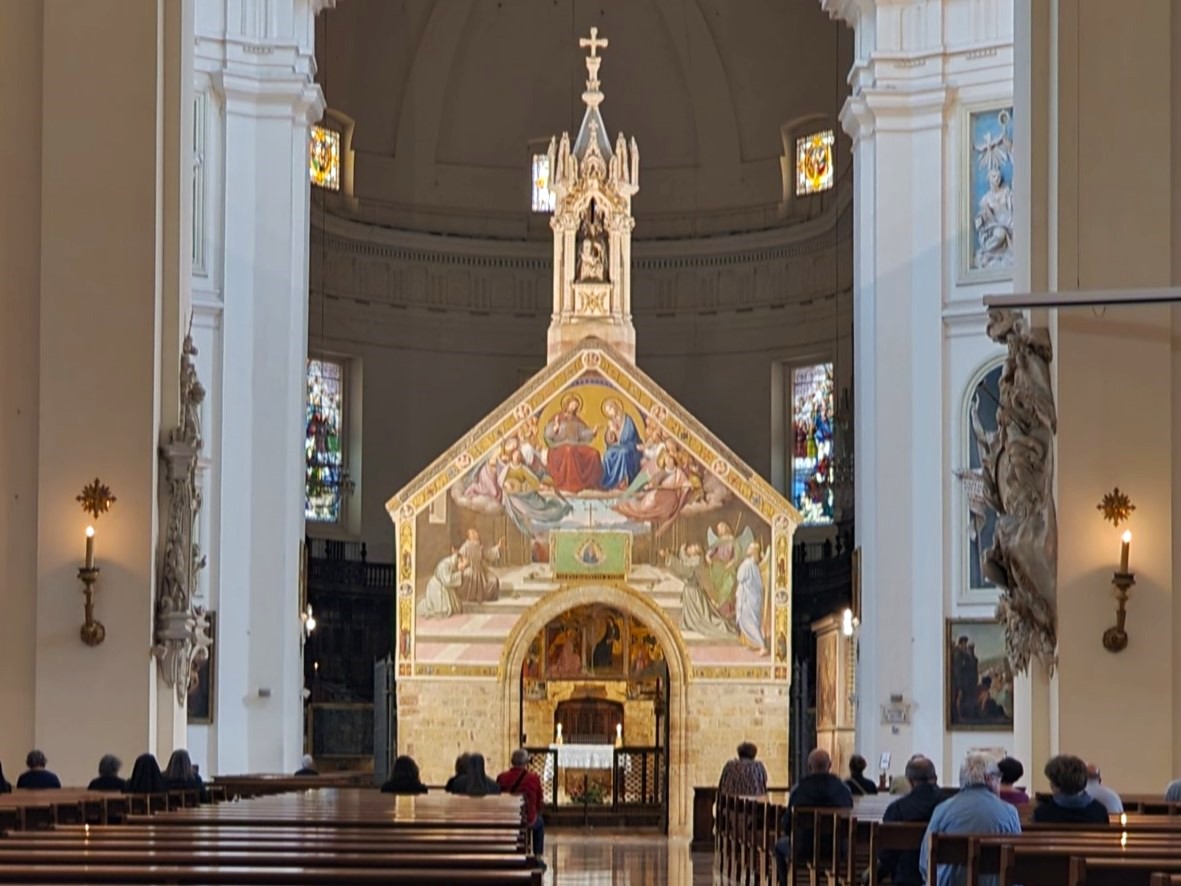
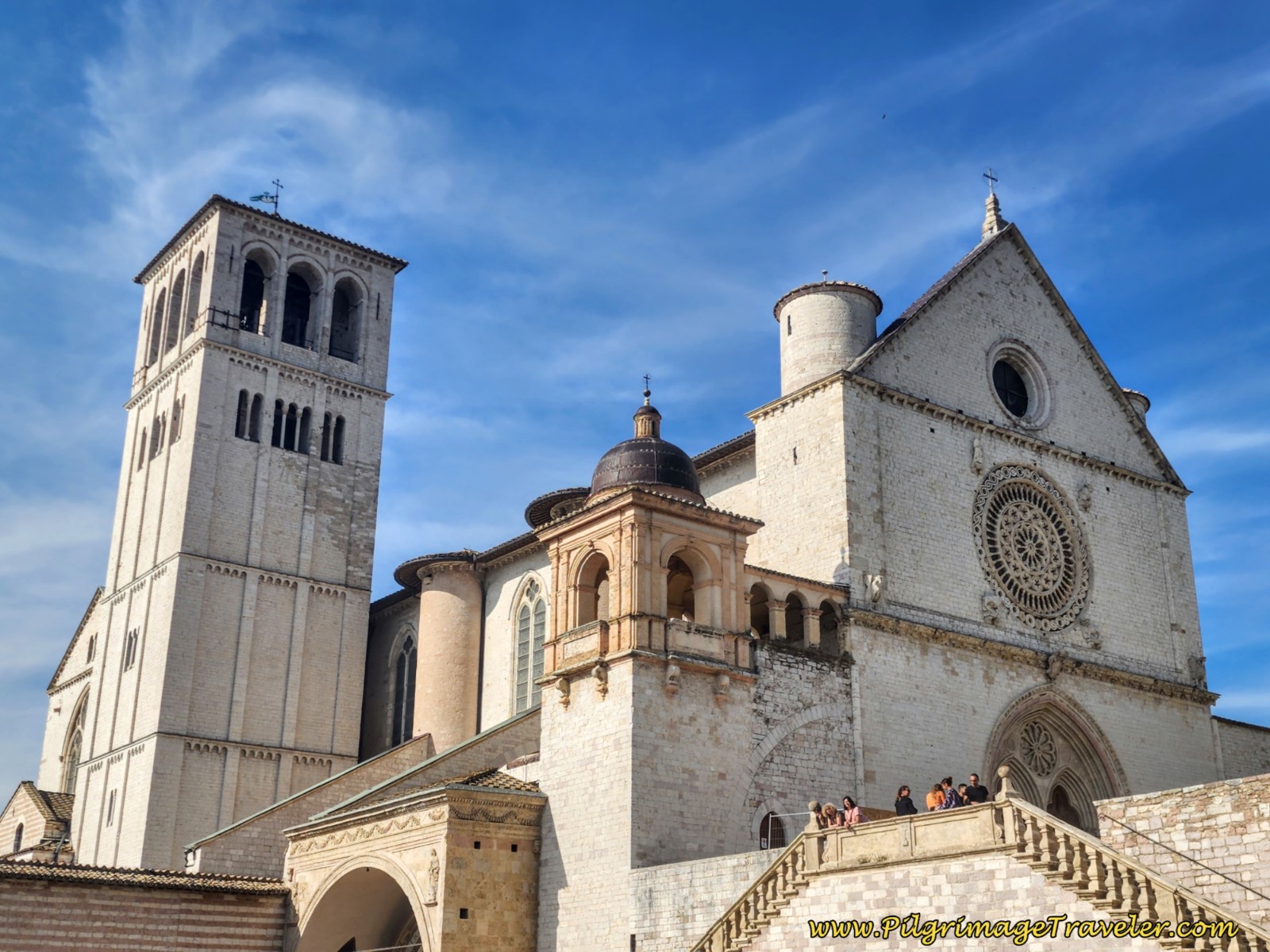

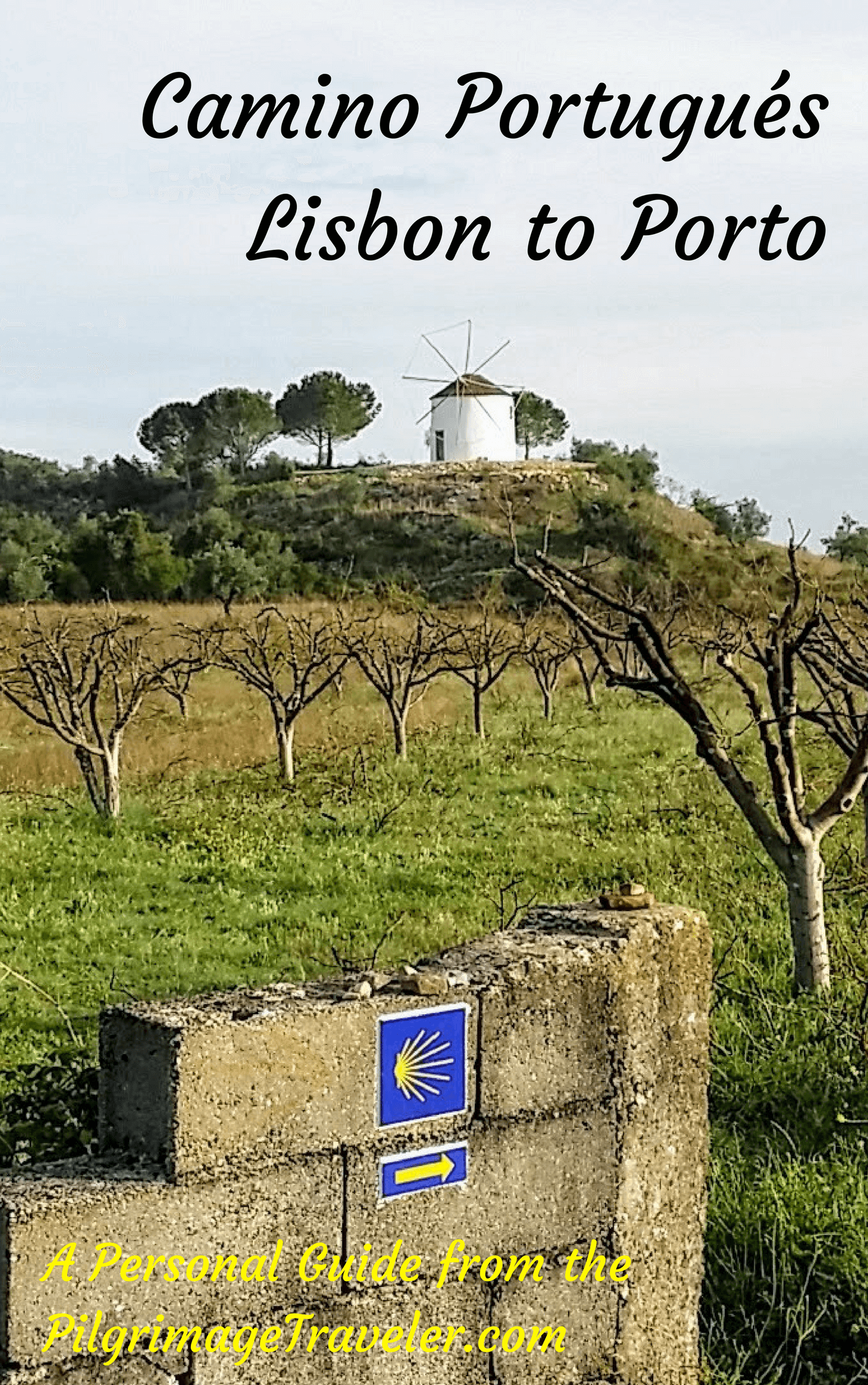















Your Opinion Matters! Comments
Have you had a similar experience, have some advice to give, or have something else you'd like to share? We would love to hear from you! Please leave us a comment in the box below.